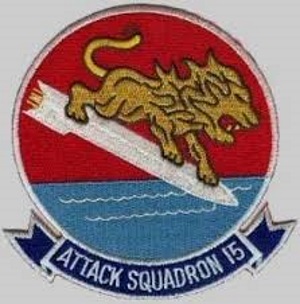 |
Attack
Squadron Fifteen
VA-15 The VALions (November 1965 - November
1966)
(Updated April 30th, 2024
|
This is my most recent update. Please let me know if you find any misspellings, errors in content, or have any new information to add.
bo_smith@bellsouth.net
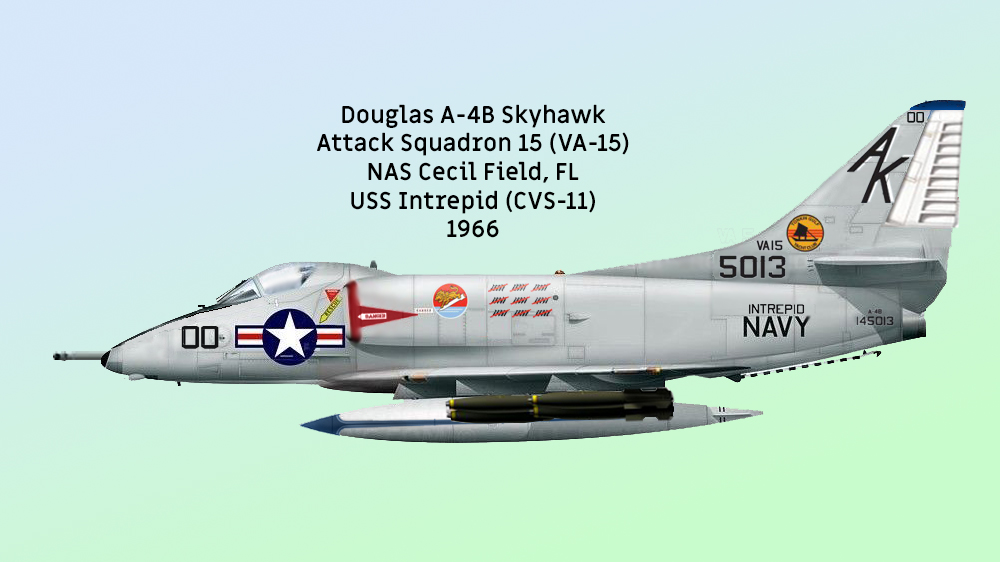 |
The Tonkin Gulf Incidents took place in August, 1964. In the first incident. the USS Maddox (DD-731) was reportedly attacked by North Vietnamese patrol torpedo boats. Shots were fired by the patrol boats and returned by the Maddox. Several North Vietnamese were killed. There was only minimal damage to the Maddox. In the second incident, the USS Turner Joy (DD-951) thought they were also attacked by patrol boats. (From Wikipedia)
Tonkin Gulf Resolution:
On August 7th, 1964, Congress passed the Tonkin Gulf Resolution which authorized President Johnson to take any measures he believed were necessary to retaliate for the attacks and to promote the maintenance of international peace in southeast Asia.
President Johnson ordered the Department of Defense to begin air attacks in the southern portion of North Vietnam and began increasing US force levels in South Vietnam. The Navy began sending aircraft carriers north to a position called Yankee Station to conduct carrier based bombing of southern North Vietnam targets. The carrier based aircraft usually provided close and direct air support missions in South Vietnam before moving north. As US troop levels increased in the south, the Department of Defense concluded that an increased capability to provide air support in the south was needed. The Air Force and US Marines increased air support capabilities based in South Vietnam.
Operation Rolling Thunder (1965-1968):
The gradual and sustained air war over North Vietnam called Operation Rolling Thunder conducted from March 2nd, 1965 through November 2nd, 1968. Rolling Thunder grew from a sequence of single mission retaliatory strikes (1965) into a massive strategic air campaign (1967). Rolling Thunder initially concentrated on attacking infiltration routes into the South Vietnam from North Vietnam. Targets were designated on a weekly basis by the nation's top military leaders, the Joint Chiefs of Staff (JCS), and approved by the Secretary of Defense, the State Department, and most significantly, President Johnson. The final decision on targets were authorized, the number of sorties to be flown, and in many cases even the tactics to be employed by our pilots was made at a weekly "Tuesday Luncheon" in the White House. This meeting was attended by the President, the Secretary of State (Dean Rusk), the Secretary of Defense (Robert MacNamara), Presidential Assistant Walt Rostow, and the Presidential Press Secretary (first Bill Moyers, later George Christian). The significant point is no professional military man, not even the Chairman of the JCS was present until late 1967.
(** This
paragraph was paraphrased
from Alpha Strike
Vietnam, pages 25
and 26.)
Dixie Station:
In 1965, General William C. Westmorland, Commander of US Ground Forces Vietnam, requested that an aircraft carrier be provided by the Navy to support combat operations in South Vietnam.
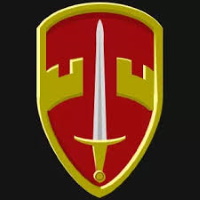 |
Military Assistance Command
Vietnam (MACV) In 1965, the primary mission of MACV was to provide advisors to to the local Vietnamese people at the district and village (hamlet) level for local defense, counter guerilla operations, infrastructure improvements, and other civic affairs issues. In July, 1965 the total number of military personnel assigned to Vietnam to accomplish the mission of advisor and defense was about 23,300. President Johnson significantly increased this number as the mission was expended to include more intensive counter-offensive opeeerations from 966 to 1969. |
In response this South Vietnam buildup, the Navy decided to convert the USS Intrepid CVS-11 (the "S" is for anti submarine warfare) to provide direct support for the MACV mission. The concept was that the Intrepid and it's embarked air wing, CAG 10, would operate from a location called Dixie Station off the coast of South Vietnam. This Dixie Station carrier would not require fighter aircraft as there was no fighter threat in the south. The carrier would not need airborne command and control so no Airborne Early Warning (AEW) aircraft would be necessary. What was required was as much air support for ground troops as possible. It was decided that Intrepid's aircraft deck load would consist of two sixteen plane A4B Skyhawk squadrons and two A1 Skyraider (Spad) squadrons. There was also a three plane helicopter detachment (HC-2) assigned to the ship for logistics and search and rescue missions. Intrepid and it's air wing was tasked to begin training for a June 1966 deployment to Dixie Station.
Useful References
So far, I have found the
following books very useful sources
to add to my personal knowledge of
Dixie and Yankee Station during
Rolling Thunder in 1966.
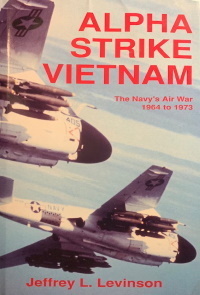 |
"Alpha Strike Vietnam, The Nav'y Air War 1964 to 1973" Jeffrey L. Levinson It is a collection of chapters based on interviews of twenty three attack pilots who flew during the air war. Chapter 11 is about the USS Intrepid's two deployments (1966 and 1967) based on the interview of LCDR Don Felt, Intrepid's Strike Operations Officer. |
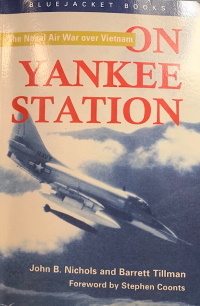 |
"On
Yankee Station", The Naval Air War over
Vietnam Cdr. John B. Nichols, USN Ret. (F8C Crusader pilot) and Barrett Tillman (award winning naval historian) This book not only relates the various phases of Rolling Thunder (1965-1968) but also adds an analysis of the how the political decisions affected the prosecution of the air war from the pilot's perspective. In addition, the appendices offer valuable statistical information: Appendix A- Vietnam Air War Chronology Appendix B- Combat Sorties and Aircraft Losses Appendix C: Overall Air to Air Combat Results |
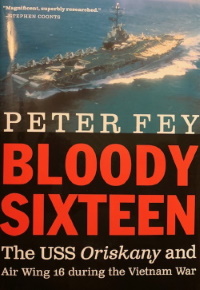 |
Peter Fay's well researched book "Bloody Sixteeen" details the performance of USS Oriskany and CAG 16 team during three Vietnam deployments; 1965, 1966, and 1967. I will compare some aspects of the CAG 16 experience during the summer of 1966 with ours on board Intrepid. |
The four attack squadrons of CAG 10's Dixie Station air wing consisted of the following squadrons:
A4 Squadrons Aircraft Home Base Spad Squadrons Aircraft Home Base
VA-15 A4B Skyhawks NAS Cecil Field in Jacksonville VA-176 A1 Skyraiders NAS Jacksonville, FL
VA-95 A4B Skyhawks NAS Lemoore California VA-165 A1 Skyraiders NAS Alameda California
The squadrons were tasked to commence training at their respective bases and be ready to start work up training on board Intrepid in February, 1966 for deployment in April and to commence combat air support flights from Dixie Station in May. For the two west coast squadrons that meant they would leave their bases in February and not return until after the deployment in November (10 months).
The 1966 VA-15 Squadron Officer Roster
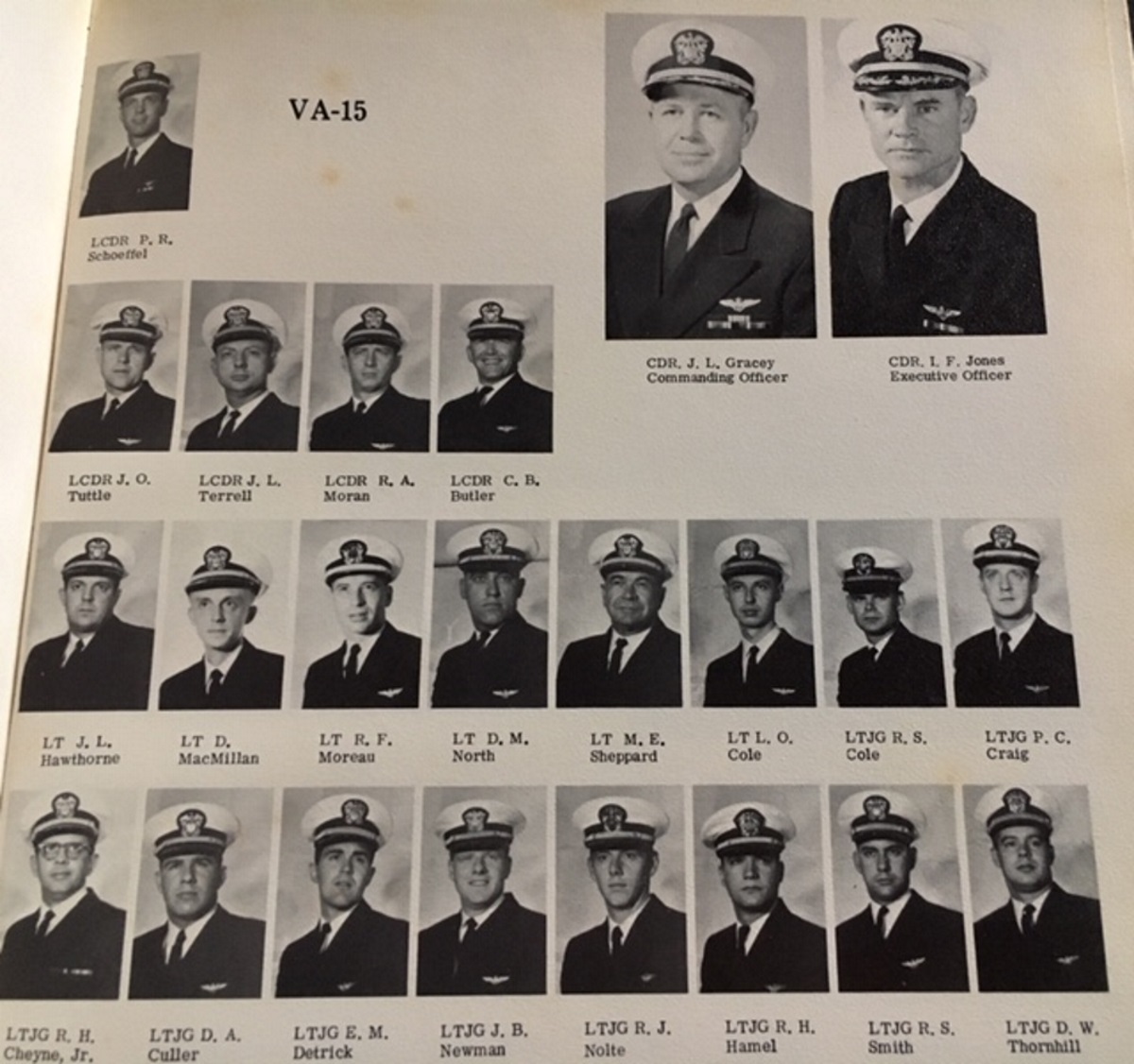
From the USS Intrepid 1966 cruise book
Ltjg Gene Atkinson did not join the squadron until after this picture was taken.
I guess Ltjg Dave Parsons missed being included in the picture for some reason.
1965
The Rebirth of VA-15
Rules for flying in VA-15: LCDR Tuttle was instrumental in setting up the ground rules:
1. We established divisions within the squadron and flew many missions with the same flight leader (CO, XO, LCDRs Schoeffel, Tuttle, Terrell), section leaders (North, Moreau, Butler, Moran, and Lee Cole and wingman (10 Ltjgs). I was assigned to Possum Flight; LCDR Possum Terrell and usually I and Dave Parsons were the wingmen. We flew a lot of three plane flights with Pars and me alternating as section leader or as a three plane division with each of us in a section leader position on either side of Possum. LCDR Fred Hoerner, the CAG 10 Staff LSO, often flew the section lead position when he was available which he made sure was often.
2. There would be "no rank in the air". That meant that pilots would progress due their aviation skills progress not their rank. This didn't mean that much at the start but it became significant later on.
3. We would adhere to strict radio discipline. You never pushed the mike button unless you knew exactly what to say and then in as few words as possible. We wingmen were expected not to say anything because, by definition, wingmen had no reason to say anything. Tuttle would say, "son, all I want to hear out of you is Aye Aye Sir or Mayday". In flight, you never questioned a decision by your leader. It was Standard Operating Procedure (SOP) that when a wingman reached a pre briefed fuel state (bingo fuel), it was OK to say or preferably hand signal "two or four (our positions as wingmen) "bingo". That was it, you never reminded the leader again as to your decreasing fuel state. He was the leader and he knew what your fuel state was. Just "shut up and fly wing". We used hand signals and various movements of the aircraft such as wing rocks etc. to communicate.
4. Formation flights would demonstrate coordination and professionalism at all times; canopies would open and close at the same time, section taxi formations would be perfectly spaced etc. etc. Our goal was not to be "Blue Angels"; just a very professional carrier attack squadron.
Jerry Tuttle liked to refer to
us as, "None Finer"
Working for Jerry Tuttle:
Once both the CO and XO were onboard and Pete Schoeffel was the official Operations Officer, LCDR Tuttle was the Maintenance Officer. I was the Aircraft Division Officer. It was a real learning experience working for him. His best advice to me was "Instructions (written regulations) were for mediocre naval officers". He expected us to identify the problem, determine a solution, and execute it, yesterday. He was all about rapid response time; in the air and on the ground! Miller Detrick was the Line Division Officer and Dave Thornhill was the Quality Assurance Officer. Lt Morris E. Shephard (Shep) was the Maintenance Control Officer and Bob Cheyene, a mustang (ex enlisted) was the Avionics/Ordnance Officer. Jerry Tuttle and Shep knew that the highest possible aircraft readiness would be required to accomplish our mission. It would be the key to our success from the beginning.
I'd like to relate a story that is a
good example of what Jerry Tuttle expected
from his division officers.
One of the other
squadrons that shared Hangar 13 with us was
VA-66. They had their squadron patch on
their aircraft by using a decal. The problem was
that their decals did not adhere well to the
aircraft paint so they tore off in pieces. It
wasn't a pretty picture. Jerry Tuttle came to me
one day and told me that he wanted our squadron
decal on our airplanes but that he didn't want
them to come off. Basically, fix it. Well, I
knew nothing about the naval supply system and
it was doubtful that they would fund this
anyway. So, I researched the issue and found a
3M (Minnesota Mining and Manufacturing Company)
office in Jacksonville. I knew that they
made scotch tape so I asked them whether they
had the capability to make decals that would
stay on our aircraft. Not only could they
arrange to have our decal silk screen painted on
their decal material, but they offered to train
our maintenance personnel how to use their new
bonding product to apply the decal to our
airplanes. Their bonding product worked by
making a molecular bond with the surface of the
aircraft. They guaranteed that it would never
come off. In fact, the problem was that
the only way we could get it off was to remove
it by grinding it off. They made the
decals and then their personnel came out to
teach our "metal smiths", Aviatiion Mechanics
Structiures (AMS) and our Corrosion Control Team
how to apply them. They also gave or
people hints on how to make it easier to remove
the decals if we wanted to paint the aircraft. I
don't know how we paid for the decals and
training; not my area of concern. Our aircraft paint scheme was easy to accomplish and I think it looked great; just the 3M VA-15 decal and a little bit of our blue color on the tail cap. You can see what it looked like on the aircraft below. It is our CAG aircraft number 00 instead of 300. We called it "Double Nuts".
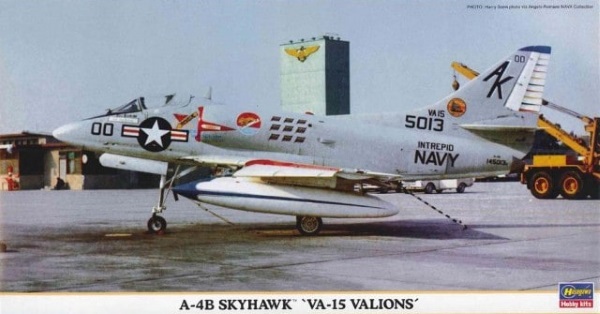 |
The image of the aircraft in the picture was taken at Cubi Point in the Philippines had flown quite a few combat missions. The markings directly behind the decal are groups of five bombs. So, this aircraft's bomb clusters indicates that it had flown 45 missions. Also notice the Tonkin Gulf Yacht Club patch on the tail. We added the Tonkin Gulf Yacht Club patch once we had been on the line for a while on Dixie Station. The bomb mission markings and the Tonkin Yacht Club patch were hand painted on all our aircraft by a single airman in my Aircraft Division. He loved that job! |
Just before we deployed, Cdr Gracey, Jerry Tuttle, and I were "chewed out" by the Cecil Commanding Officer because I had completely disregarded using the proper supply ordering procedure. He and the base supply officer pointed out that I had initiated and executed a contract which I was not authorized to do. Cdr Gracey did not give me a hard time and Tuttle just grinned. I had done exactly what he had intended me to do.
Our MacDonnell Douglas Tech Rep:
CAG 10 had a MacDonnell Douglas Technical Representative (Tech Rep) assigned to us and VA-95 to consult with us on aircraft structural repair issues during our work up and deployment. His name was Glen Gray. An A4 expert, Glen was extremely helpful especially when we had challenging airframe repairs on Dixie Station. He also advised us on MacDonell Douglas ejection seat issues. Glen was also an expert on the inflight refueling "Buddy Store". The Buddy Store was a fuel tank that had been modified with a refueling drogue system. It had a propeller that the pilot could start from the cockpit. The propeller powered the electrical and hydraulic systems that made it work. We had four of them and it took our troops and Glen busy to keep them working properly. Glen helped with both A4 squadrons. But, he spent a lot of time in our ready room and I worked with him personally a lot on Aircraft Division issues.
Uniforms:
We basically had two uniforms. We usually wore wash khakis (cotton short sleeved shirt. cotton slacks, brown shoes and socks (aviators and aviation chief petty officers wore brown shoes and socks. Surface officers and chief petty officers wore black shoes and socks) and a fore and aft cap (piss cutter) or VA-15 ball cap. When on the flight schedule, we would usually be in a flight suit and piss cutter or squadron 15 ball cap. We tried to get issued the cool tan cotton flight suits and ditch the orange ones.
Flying in November:
I flew 17 flights in November in A4C aircraft; formation flights, refueling practice, some instrument practice approaches, and weapons delivery flights at a variety of local targets. The major target area was the Pinecastle Target complex where you could drop live ordnance and strafe with our 20mm guns. There were also several small targets such as Lake George, Rodman, and a few others which were pretty much restricted to MK 76 or MK 106 practice bombing.
The Pinecastle Target Complex: Pinecastle is about 100 miles south of Cecil.

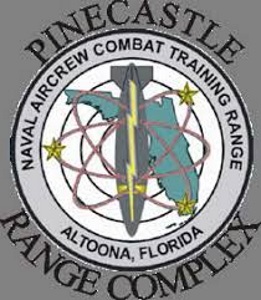 |
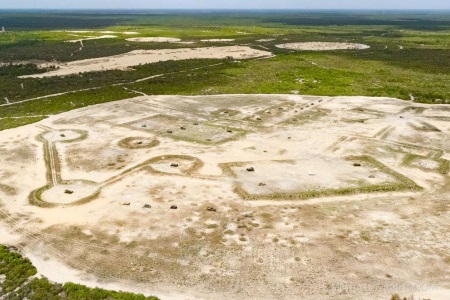 |
The powers above; Chief of Naval Operations (CNO) or OP05 (Assistant Chief of Naval Operations for Air) decided that the VA-15 and VA-95 did not need A4Cs to accomplish the Dixie Station mission. We could do just as well with the older A4Bs. Since we were not going to fly at night, we only needed the old all black main Attitude Direction Indicator (ADI) in the A4B rather that the newer white over black ADI in the A4C. Also, because we were flying in a non SAM (Surface to Air Missile) and non radar controlled AAA (37/57/85mm) environment, we did not need the electronic warfare avionics that were in the fleet configured A4Cs. So, we lost our 14 A4Cs but gained 16 A4Bs. At one time in early December, we had almost 30 aircraft out there on our ramp. You better believe if they were there, Jerry Tuttle was going to fly them. As a result, we flew more A4 flight hours than any other squadron in December, 1965. Another factor was that we were not flight hour limited (fuel rationing).
December: My big news in December was the birth of my second daughter, Laura Kendall Smith on December 1st at the Jacksonville Naval Hospital. I did a bit better with Laura. I took a few days off from flying.
My first flight in December was on December 6th. It was my first A4B flight. I flew 19 flights (27.8 hours) in December; three of them in A4Cs (6th, 7th, and 8th). By the middle of December, the A4Cs were gone. My last flight in December was on the 23rd so I guess we did take a bit of a break for Christmas and New Years.
1966
There was a world of difference between our social life in VA-15 than in the training command or VA-44. First, we expected to be together for two cruises so we thought we could really establish some good friendships. We did manage to fit in some good times despite the fact that we were extremely busy getting ready for workups. Also, we had some non flying officers and their wives who were an integral part of the social life of the squadron.
First, was our squadron flight surgeon, Lt Dave MacMillan. "Quack" as he was respectfully named, mostly paid attention to his primary responsibility; keeping the pilots in the proper physical and mental condition to be effective officers and pilots. But, Quack also paid attention to the squadron medical needs of the officers' wives and the enlisted men and their wives and families. Quack actually made house calls when needed. Bye the way, over 50 years later Dave Macmillan, a retired neurosurgeon, is still called "Quack" at squadron reunions!
Not second but next, was Lt Morris E. Sheppard. Shep was everywhere. Although he spent many hours in Maintenance Control and around the hangar deck and flight line, he found time to mingle in the ready room getting to know every officer and their wives or girl friends when he could.
Next, the Avionics and Ordnance Officer, Bob Cheyne also made an effort to find his way to the ready room both ashore and onboard the ship. He and his wife Pat regularly attended squadron social functions. His widow Pat still attends our regular squadron reunions over 50 years later.
It was a little different in the case of our squadron Intelligence Officer, Lt John Hawthorne. Although John was officially assigned to the squadron, he spent most of his time ashore at other offices associated with intelligence matters. On aspect of being an attack pilot in the 1960s was that we were part of the nuclear deterrent program. John spent most of his time working on target folder sources and assisting each of us prepare our target planning folders. This was a very highly classified program at the time. I'll discuss it a little more detail later.
Calls Made and Returned:
According to Naval tradition, an new officer back in 1965 was expected to "pay a call on his Commanding Officer at his quarters as soon as possible after reporting aboard his ship or squadron. It was expected that the call would be brief; the new officer should not hang around. Upon leaving, the officer placed his calling card (one for the CO and every member of the COs family) in a silver plate or ceramic dish located at the front door. After an appropriate amount of time, the commanding officer would return the call (rarely happens). Because we had twenty four officers reporting in within about a six week period, "Calls Made and Returned" was not practical. So, Cdr. Gracey decided to have an oyster roast party and consider it as "Calls Made". Some left cards. Some did not. I did. I really liked the idea and had a ceramic dish by my front door when I was a squadron Commanding Officer in 1978.
The Oyster Roast: The CO, Cdr. Jack Gracey and his wife hosted our first squadron party. (Calls Made)
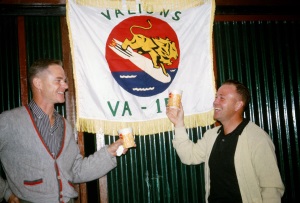
XO CDR Ike Jones; CO Cdr Jack Gracey
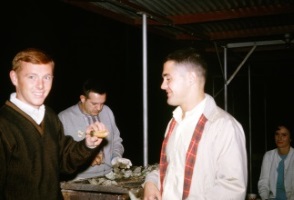 |
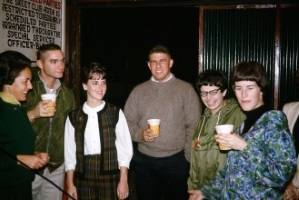 |
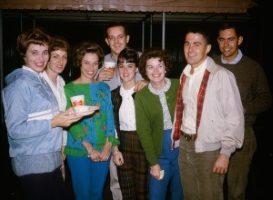 |
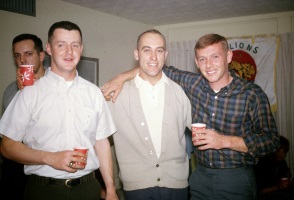 |
It was a great party. Not pictured here are the Moreaus, Terrells and the Tuttles. But, Im sure they were there. John Hawthorne was able to attend this party. He managed to get into three of the four pictures. In future parties, we would find out how much Barbara Tuttle liked to dance to Elvis and the Beetles. Possum started his fame as The Phantom Fannie Feeler". Back in those days, we were not so uptight about such things. Also not pictured here in his bachelor days, is Dave Parsons.
Not to worry, here he is!
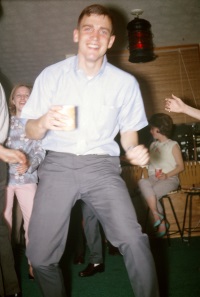

Flight
Operations in January, 1966
This is a picture of one of our new A4Bs in January 1966 with the new paint job
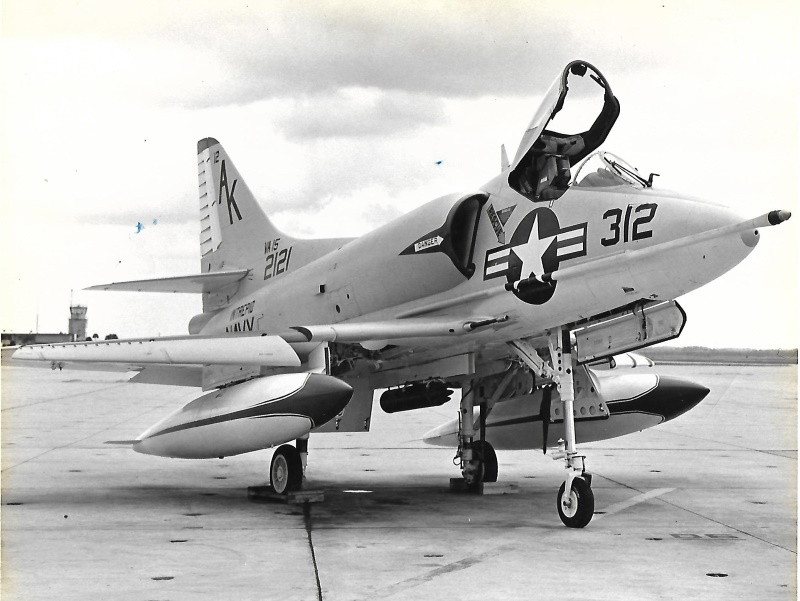 |
| Note
the 2.75 " practice rocket pod on the
centerline station Also note the Cecil field tower in the background. |
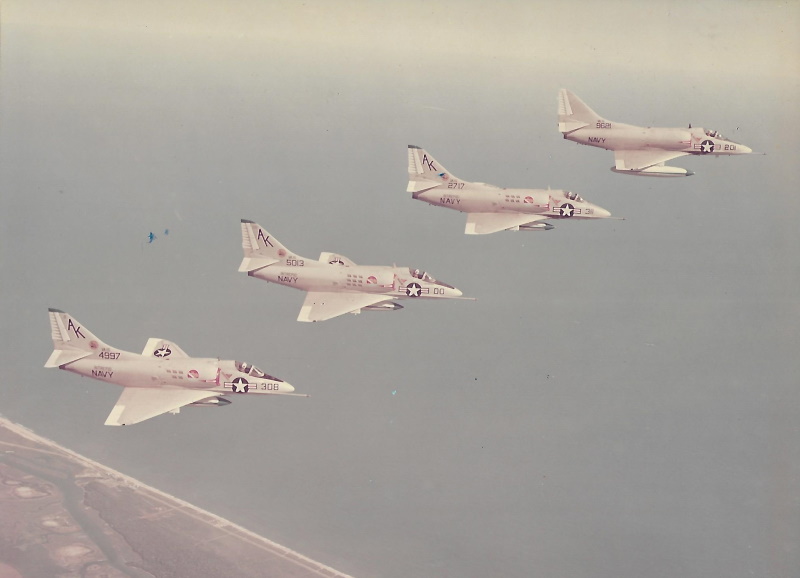 |
| VA-15
A4B echelon formation over
Jacksonville Beach It was actually taken after the cruise (note mission markings and Tonkin Gulf Yacht Club patch). This must have been taken just before we received our A4C aircraft for the second Vietnam deployment. |
Carrier Airwing Ten had completed their move from NAS Oceana to Cecil during December. The Air Wing LSO (Landing Signal Officer), LCDR Fred Hoerner flew mostly with us (Possum flight) during January. He also conducted most of our VA-15 individual pilot debriefs.
I'm not sure how the VA-176 Spad drivers stationed at NAS Jacksonville worked out their carrier quals but CAG 10 LSOs had to be involved. Also, I suspect that the VA-165 Spads at NAS Alameda and the VA-95 A4s at NAS Lemoore either must have come east to get in some FCLPs with the CAG 10 LSOs or the LSOs went west to them.
Flight Operations in February,
1966
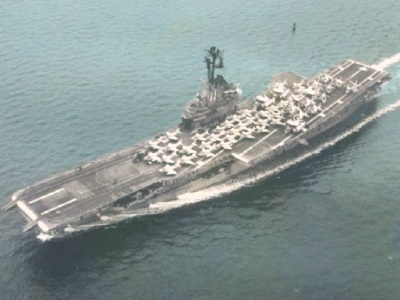 |
USS Intrepid (CVS-11) Workup Training |
USS Intrepid Underway Workup Training One:
We flew out to the Intrepid on February 1st. The Intrepid was probably located off the coast of Jacksonville. We spent a little over three weeks onboard. I flew 26 flights; 39.3 hours, 23 arrested landings (2 bolters). I left Intrepid for a couple of days at Cecil for some reason from the 14th to the 17th. It wasn't just for a break because I flew two flights on the 14th and flew back on 17th (two days home with Mary and the girls). I'm sure that in the beginning, we concentrated on learning the carrier/airwing procedures for departures and landing order etc. We didn't bag any traps (get practice) because all my flights had only one landing (except for the two bolters).
We did some night flying (not much) to practice night departures, get a little night time, and practice entering the holding pattern (Marshall) and executing a carrier controlled night approach. I logged 3.2 hours of night time; 3 night cat (catapult) shots (take off), three night CCAs (Carrier Controlled Approach), and 3 night landings. We were going to be the day only Dixie Station carrier off of Vietnam but we still were going to transit the Atlantic and operate in the Mediterranean Sea. We had "real world" missions during the transit to and while in the Med so had to be prepared for the possibility that the missions might involve some night flying.
We also did as much weapons training as we could. I suspect we did some MK 76 practice bombing of the "spar. The Intrepid (or any surface ship) could deploy a sled type device (AKA the spar) from the stern and tow it with a steel cable about 2000 feet aft of the ship. The airplanes (usually a division) would set up a circular pattern and make individual bombing runs attempting to hit the "spar". This was not very realistic training but it was better than no practice if a land target is not available. I know we did do some weapons flights to most likely Pinecastle Target because I expended some MK 80 series live bombs and shot some 5" Zuni and 2.75" LAU 7 rockets which could only have been used at Pinecastle.
We flew back from the ship on February 23rd and took a few days off from flying to give the maintenance folks a chance to work on the jets.
Flight Operations in March, 1966
USS Intrepid Underway Workup Training Two:
We flew out of Cecil for the first couple of weeks or so. I flew 5 flights which were mostly weapons flights. Two were MK 76 practice bombing flights. But I got a chance to fire my first two Bullpup missiles on the third flight. The Bullpup was an air to ground missile that you controlled via a wire from the aircraft to the missile. Firing a Bullpup was like playing a video game. We even had a Bullpup simulator which was a video game.
We had one which we practiced with in Hangar 13 at Cecil and moved to the ready room on the ship.
We flew out to Intrepid on March 18th for only a short one week workup. The ship was probably located off of VACAPES (the Virginia coast) close to her homeport in Norfolk. I flew 8 flights during that period; 7 arrested landings one of which was my 30th Intrepid trap. We flew off the ship on March 23rd for Cecil. I flew only 3 flights in March for 21.5 flight hours.
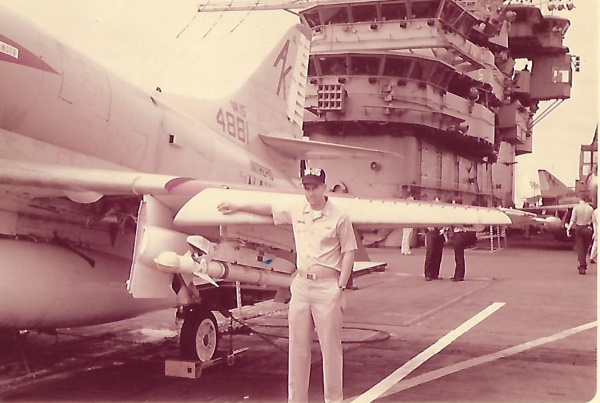 |
| Bo on #1 Catapult on Intrepid
during workups |
The Bahamas Trip
We basically shut down the squadron for four days at the end of March. All the enlisted men (troops) got basket leave (took four days off without it counting as leave) and all the officers that could took a trip to the Jack Tar Hotel, West End, Bahamas. It was for officers and wives or girlfriends; no children. The no children concept unfortunately prevented some key people from attending such as the Terrells and Tuttles. "Quack", Doc MacMillan, arranged the whole thing including a chartered prop plane, rooms, and meals for a reasonable flat rate of something like $500 each. When you are going on your first combat deployment, it was worth every penny.
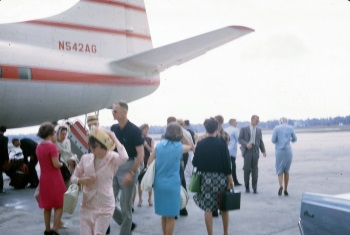 |
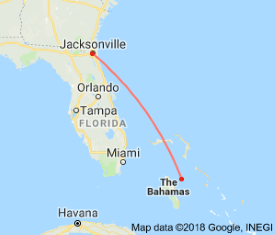 |
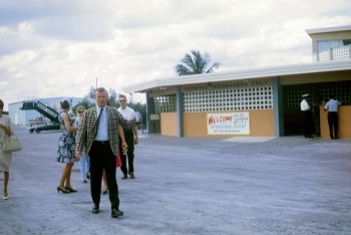 |
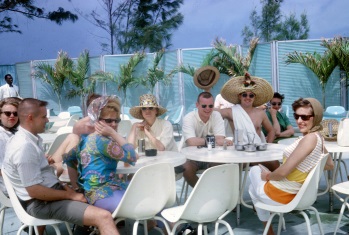 |
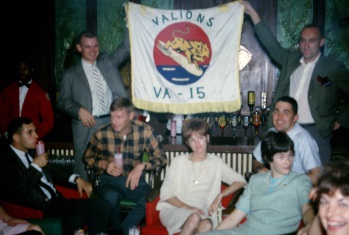 |
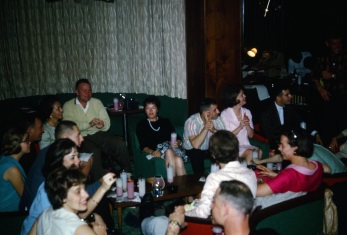 |
The pictures sort of speak for
themselves. But, there are a couple of stories
that are worth telling.
The
first night at the hotel, some of us
were are the bar drinking Flaming
Hookers. A Flaming Hooker is a
small drink (an once or so) of very high
proof (180 or so, almost pure alcohol)
rum or other beverage imbibed from a
tall narrow after dinner drink glass
preferably with a flared edge. The key
ingredient is that you have to light it
and drink it down while its burning.
(Note: If you drink it right away before
the glass gets hot and avoid your lips
you're OK. Otherwise, you could be in
deep trouble. Well, while we were
having our Flaming Hooker party, a
middle aged woman unknown by us, came to
the bar and claimed to be the world
champion Flaming Hooker drinker. Well,
the aftermath of what followed was that
we almost set the bar on fire. The
woman turned out to be named
Flossy Segal. Her husband, Jake Segel,
was a Korean War Marine veteran. When
he found out that we were a bunch
of carrier pilots on our way to Vietnam,
he invited all to have dinner with him
and Flossy the next night. Our XO,
Ike Jones, thought it was a bad idea as
he questioned Jake's motives. We ignored
the XO and
had a fantastic time the next
night. Later after the Vietnam
deployment, Mary and I visited Jake and
Flossy in Richmond, Virginia where they
owned a furniture business.
On the day after the Flaming Hooker event, most of us (males) decided to play golf. The wives/girlfriends decided to tag along and make value judgments about our golf games. We had a special set of rules of the game though. Each golfer had to take a "swig"(large gulp) of rum on the T box prior to driving and again on the green after putting. By the fifth hole, everyone was laughing. By the eleventh hole, no one was walking strait. There were several shots that endangered the gathering of wives and a club or two that ended up in trees; no problem except the replacement cost of the club appeared on the bill.
We flew all 16 airplanes to the Intrepid on April 1st, 1966. I had conflicting thoughts about it. I was concerned about how Mary, Heather, and Laura would handle our separation for seven months. But, I knew that they would spend a lot of time in Duxbury with Mary's family. That was comforting. But, at the same time, I was excited about my first carrier cruise and that it would involve actual close and direct air missions in support of our troops in a relatively safe AAA (Anti Aircraft Artillery) environment. A light attack pilot's dream come true.
We had
two A4 squadrons (VA-15 and VA-95) with 16
A4Bs each (32 A4s). We also had two
A1 Skyraider (Spad) squadrons (VA-176 and
VA-165) with 10 Spads each (20 Spads) for
a total of 52 attack aircraft. We
also had a ship''s COD (Carrier Onboard
Delivery) aircraft which was used for
logistics including personnel transfer.
And last but not least, the ship had a
detachment of helos (HC-2) which were used
for logistics and search and rescue.
We had an HC-2 helo in the air near the
ship called the "Angel" whenever we were
flying.
On the day after the Flaming Hooker event, most of us (males) decided to play golf. The wives/girlfriends decided to tag along and make value judgments about our golf games. We had a special set of rules of the game though. Each golfer had to take a "swig"(large gulp) of rum on the T box prior to driving and again on the green after putting. By the fifth hole, everyone was laughing. By the eleventh hole, no one was walking strait. There were several shots that endangered the gathering of wives and a club or two that ended up in trees; no problem except the replacement cost of the club appeared on the bill.
Vietnam
Bound
We flew all 16 airplanes to the Intrepid on April 1st, 1966. I had conflicting thoughts about it. I was concerned about how Mary, Heather, and Laura would handle our separation for seven months. But, I knew that they would spend a lot of time in Duxbury with Mary's family. That was comforting. But, at the same time, I was excited about my first carrier cruise and that it would involve actual close and direct air missions in support of our troops in a relatively safe AAA (Anti Aircraft Artillery) environment. A light attack pilot's dream come true.
Deckload
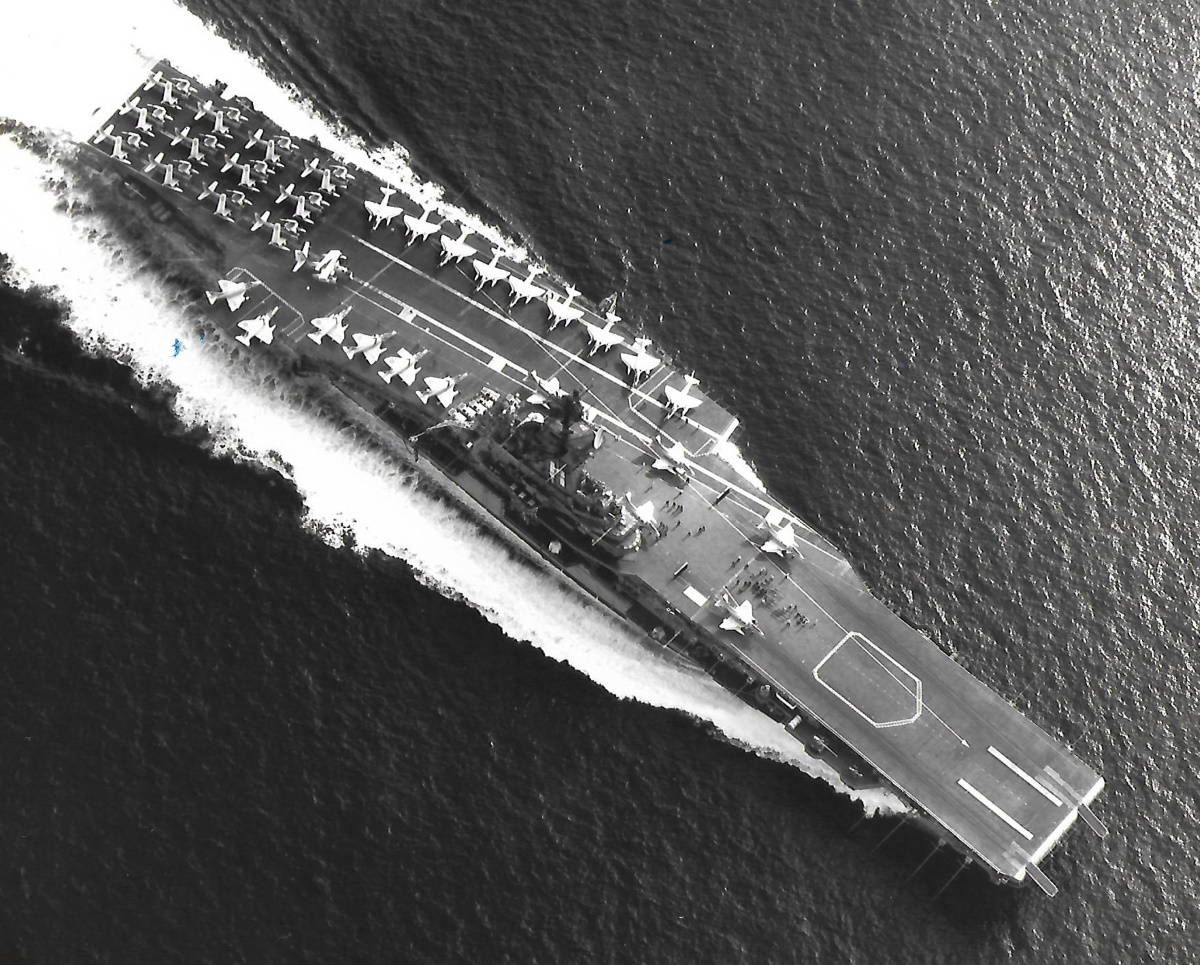 |
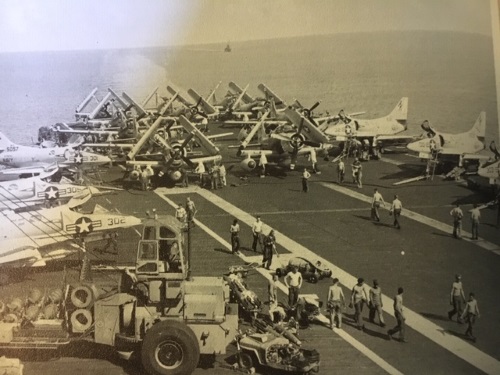 The Spads
were normally spotted on the
aft flight deck.
|
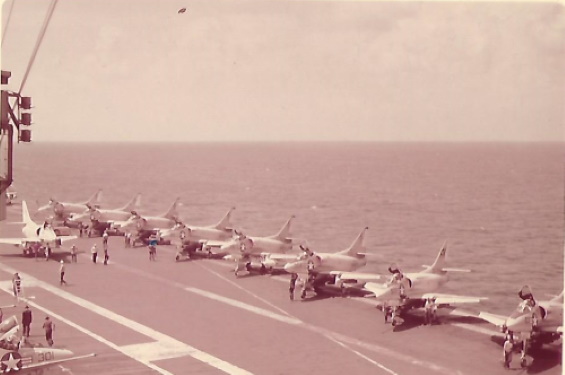 The Skyhawks
were spotted on the port aft
angle of the flight deck and
along the foul line.
|
Carrier
Air Wing Ten Squadrons
We had two A4
squadrons (VA-15 and VA-95) with 16
A4Bs each (32 A4s). We had two
A1 Skyraider (Spad) squadrons
(VA-176 and VA-165) with 10 Spads
each (20 Spads) for a total of 52
attack aircraft. We also had a
ship''s COD (Carrier Onboard
Delivery) aircraft which was used
for logistics including personnel
transfer. Last but not least, the
ship had a detachment of helos
(HC-2) which were used for logistics
and search and rescue. We had
HC-2 helo in the air near the ship
called the "Angel" whenever we were
flying.
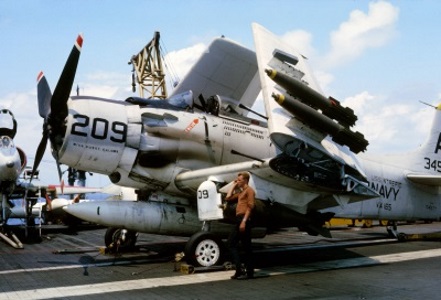 VA-165 Spads-200s
|
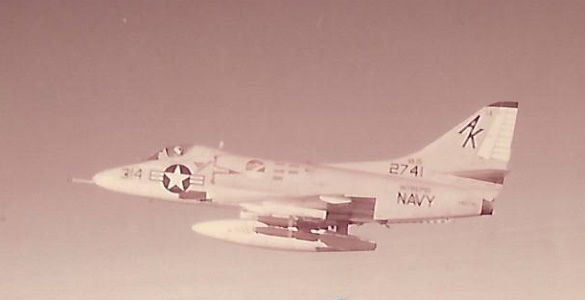 VA-15 A4B Skyhawks-300s
|
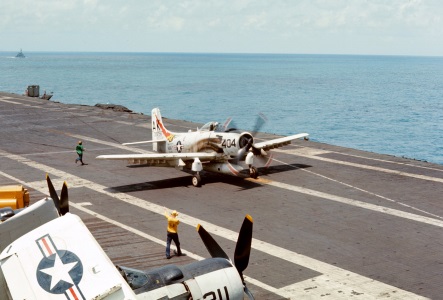 VA-176 Spads-400s
|
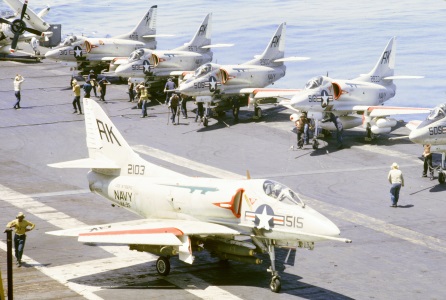 VA-95 A4B
Skyhawks-500s
|
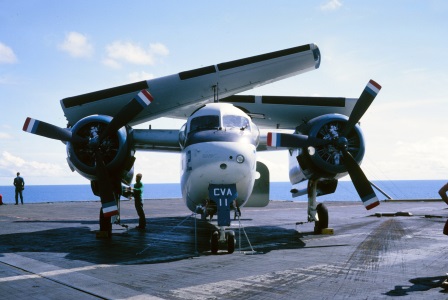 Intrepid's COD
|
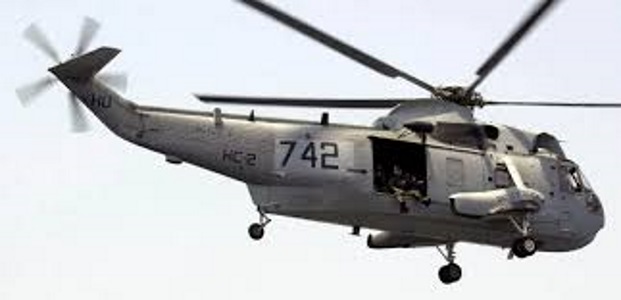 HC-2 Helo
|
Transit
from Norfolk to Naples, Italy
It took 18 days to transit the Atlantic to the Straits of Gibraltar and then on to our first port visit in Naples. I flew one fight in the vicinity of the Azores Islands on the 5th of April, and four flights in the western Mediterranean enroute to Naples. During or transit to Gibraltar, we were under the operational control of Second Fleet based in Norfolk. As soon as we passed through the Straits of Gibraltar, we switched to the operational control (OPCON) of Sixth Fleet in Gaeta, Italy. Although there wasn't much flying, there was quite a bit to do during the transit.
Norfolk to the Straits of
Gibraltar: The Intrepid left Norfolk on April
4th, 1966
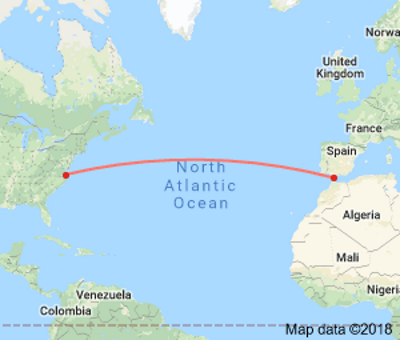 |
It's about 3,800 miles from Norfolk to the Straits of Gibraltar. We did not fly at all until we were close to the Azores so we would have a bingo field available if something went wrong. But we kept ourselves occupied with two activities: 1. It was a great opportunity for those of us who thought we might want to command a ship one day to stand some underway bridge watches. 2. We had a lot of planning and studying to do in connection with a mission we would have when we were in the eastern Med. This mission was in connection with America's policy of nuclear deterrence. I will discuss this in some detail in a separate section. |
Before I get into a discussion of our nuclear deterrence mission, I want to tell you an exciting story. At least it was exciting to me, even scary.
The Soviet Union liked to keep track of American aircraft movements as much as possible. One way they did this was by overflying our carriers using their Tupelov TU-95 Bear aircraft. The Bear had an amazing range and could inflight refuel. They could get to us from the Baltic Sea through the Iceland UK Gap and then down to our track and return. One day, we received intelligence that a bear was enroute when Intrepid was about 500 miles west of the Azores. It was Navy policy that Soviet Bears would not overfly one of our carriers without being intercepted by a section of one of the carriers fighter aircraft. There was only one problem. We didn't have any fighters and the highest altitude that an A4B could reach was about 43,000 feet. The Bears could fly well above that. There was no way that we could reach them. However, sometimes the Bears would come down to a low altitude, even 1,000 feet to take pictures of the carrier. Well, to shorten the story; VA-15 was tasked to be ready to launch to intercept the Bear and then fly to the Azores. The sea was exceptionally rough and there was no way we would attempt to land. I was assigned to fly with the XO, Cdr Jones on the mission. We manned aircraft. He was on the port catapult. I was on the starboard. We actually started our engines and were hooked up. I was looking at waves breaking over the bow similar to the picture. Thank God they scrubbed the mission.
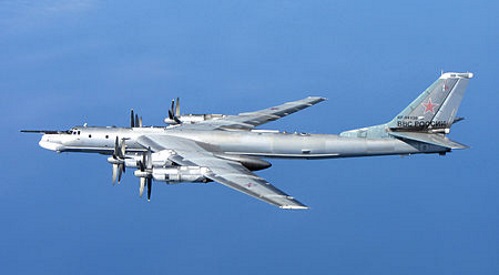 Tupelov
TU-95 Bear aircraft
|
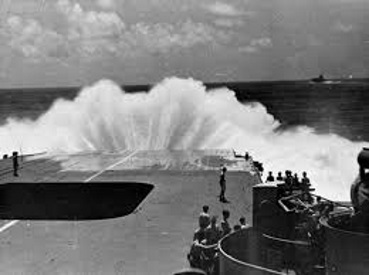 The
square hole in the deck is where he
Number 1 elevator is located.
|
Our Nuclear Deterrent Mission:
In the 1966, the United States Navy had a significantly larger nuclear deterrent capability than we have today. Our modern capability consists of fewer numbers of nuclear weapons due to the Strategic Arms Limitation Talks (SALT agreements with the Russians). Another difference is that our modern capability only involves strategic weapons systems such as US Navy nuclear ballistic submarines, long range strategic bombers (B1/B2), and strategic surface to surface ballistic missile systems.
In the 1960s, we had had a tactical nuclear weapons capability. In Europe, the US Army had artillery with a low yield nuclear capability. In Europe at that time, the Soviet Union had an overwhelming advantage in terms of ground infantry and tank forces. If they chose to attack West Germany and France from East Germany and satellite countries such as Poland, there was no way that NATO forces could stop them with conventional weapons. The US Army's tactical nuclear capability made it unthinkable that the Soviets would attack with their conventional forces. The USAF and the Navy also had tactical nuclear capabilities. The USAF F-105 Thunderchief was designed to conduct low altitude high speed penetration of Soviet military targets such as airfields with tactical nuclear bombs. Our Navy aircraft carriers carried tactical nuclear weapons designed to be delivered by our their embarked A4 carrier aircraft. Aircraft carriers operating in the northwestern Pacific and eastern Med were assigned tactical military targets. When we were back at Cecil our AI (Aircraft Intelligence Officer), John Hawthorne worked with the system to get our targets that we would be tasked to attack if needed. Each of us had a specific target . We worked on constructing our navigation charts that we would use, memorized the navigation route and defensive environment etc. We flew practice "profile missions at Cecil which involved high altitude navigation descending into Florida airspace, and a 500' AGL (Above Ground Level) low level route to Pinecastle where we would deliver a MK 76 or Mk 106 practice bomb. We practiced various types of deliveries designed to give the aircraft the greatest possible separation from a nuclear detonation. We were issued eye patches to put on one eye so that if the flash of the detonation blinded on eye, we had one remaining. We would of course have moved our mirrors so that a flash behind us wouldn't be reflected in our eyes. We did flash blindness training to observe how long to expect our vision to be regained after a big flash. If you look at the paint scheme for naval aircraft in the 1960s, you might notice that the fuselage paint is a light gray which provides fair camouflage in a cloudy sky. But, all the flight control surfaces (ailerons, elevator, and rudder) are white as the color white reflects light most effectively reducing heat. It was a serious mission and we were trained to perform it. Thank God, we didn't have to!!
The Azores to The Straits of Gibraltar:
As soon as we passed the through the Straits of Gibraltar we switched to 6th Fleet operational control (OPCON).
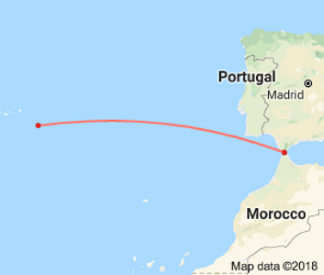 |
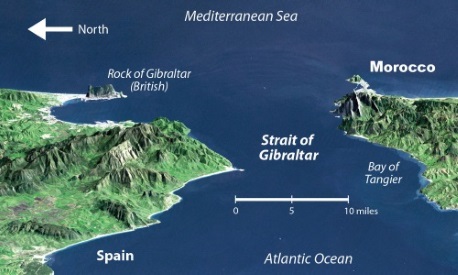 |
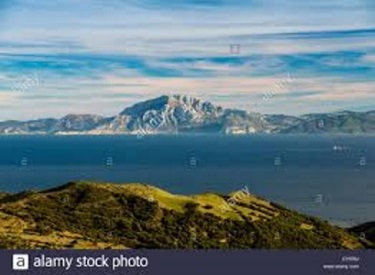 |
The Straits of Gibraltar to Naples, Italy:
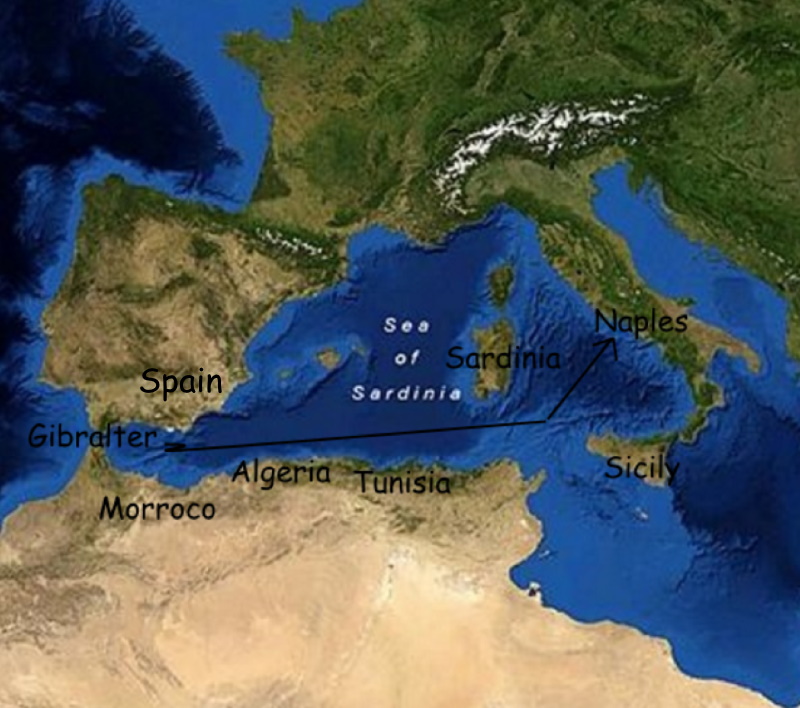 |
| As
we passed by Gibraltar on the left, we
had Morocco on the right. Next, we had
Spain on the left and Algeria on the
right. We conducted three days of
flight ops from April 15th
through the 17th on our way to Naples. |
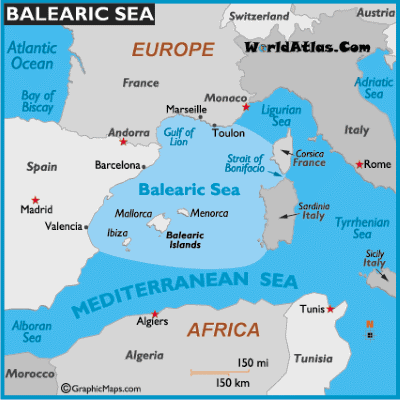 |
We probably conducted our flight ops in the Tyrrhenian Sea northwest of Sicily and southeast of Sardinia because it was closer to Naples. I flew four flights, three practice bombing flights and one practice inflight refueling flight. We entered the port of Naples on April 18th, 1966. |
Inport Naples Italy, April 18th
and 19th, 1966
We were only in Naples for two days as we had to transit the eastern Med and the Suez Canal and then the Indian Ocean to get to Cubi Point in the Philippines May 5th. So, we only had a chance for a quick visit in Naples this time. I remember though getting off the officer's liberty boat at Fleet Landing and walking up the main street in that part of Naples. We went to a restaurant about halfway up the hill and I had my first meal of real Neapolitan food. We walked around a bit. had a few drinks and that was about it. I made about ten visits to Naples in my navy career. I learned more about it with each visit, played lots of tennis, and met lots of local Neapolitans. I appreciated it and enjoyed it more with every visit.
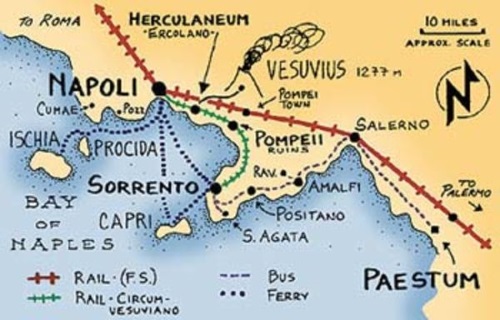 |
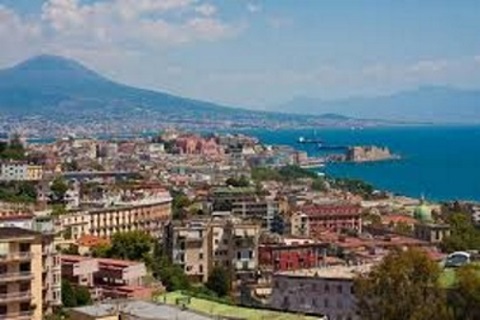 |
So, lets take a brief tour of some of the great places to visit in the Naples area. I never visited Ischia, so I can't tell you much about it. I had a few sailors get in trouble over there over the years with motor scooter accidents. We had to get them out of jail before the Sixth Fleet lawyer showed up or they would miss ship's movement which we didn't want. It was against Sixth Fleet policy to rent motor scooters; too many accidents.
Well start with the Baia Bay/Pozzouli area west of Naples and then move on to the Mergilina area. After Merginlina, well look at the port and take a ride out to NATO Heaqurters for the Southern Command (AVSouth). Next well take a look at Pompei and Mount Vesuvius before heading out to visit Sorrento and the Amalfi coast. Our final stop will be on the Isle of Capri.
Baia
Bay/Pozzouli:
On the left of the word Naples is Bahia Bay. Bahia Bay features the old town of Pozzouli which has an old Flavian Amphiteater ,ruins from the first century AD and Sufatare (The inspration for Dantes Inferno). On the other side of the bay is Julius Caesars summer palace, Roman baths and Nero's palace where he fiddled while Rome burned. Further to the left are the remains of the first Greek settlement in Italy called Cumae (@450 BC). The Greek settlement of Syracusa on the east coast of Sicily is a bit older. Syracusa was chronicled by the first known historian Thucydides.
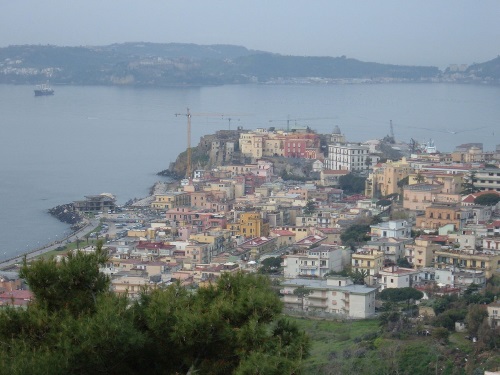 Pozzouli is in the
foreground. On the other side of
Baia Bay are the baths and the ruins
of the palaces of Julius Caesar and
Nero. Between the two points of land
submerged under Baia Bay is a fully
intact road with the ruins of
buildings.
|
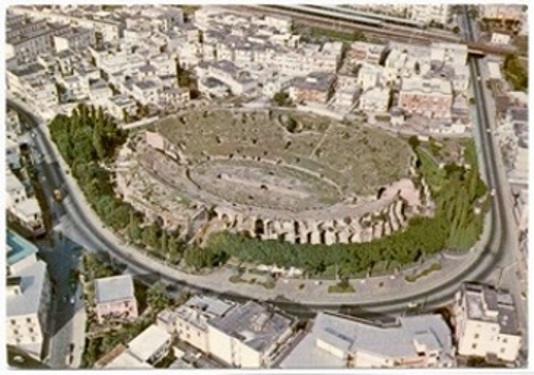 This is the Flavian
Amphiteater in Pozzouli.
Supposedly, it was large enough to
have mock ship battles in it.
|
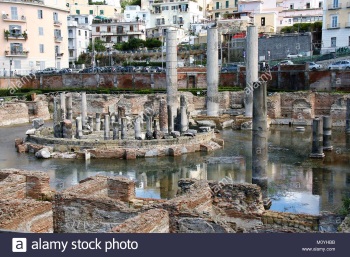 You don't have to go
to Rome to see ruins
|
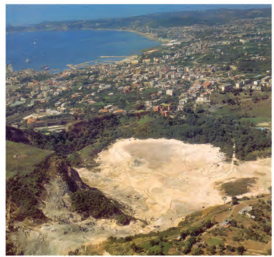 Sufatare
|
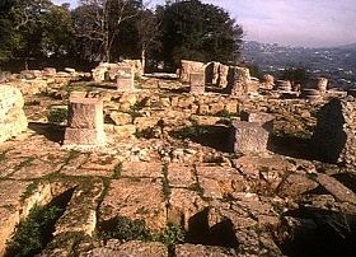 The Greek settlement
of Cumae-450 BC
|
This map
you excellent detail of the city of Naples
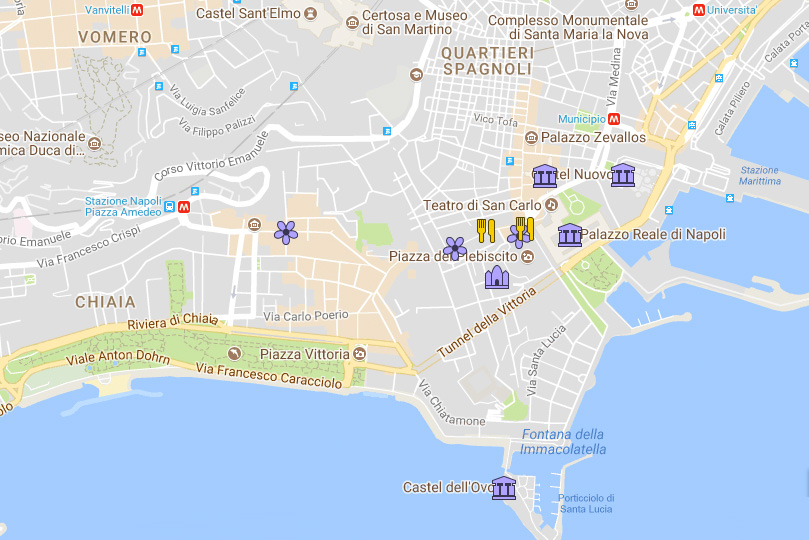
The green area on the left is a park that has excellent red clay public tennis courts. The coastline along the park is called Mergelina. Mergelina has apartments, restaurants, hotels, and a marina. The Hotel Vesuvio was my hotel of choice when I visited Naples. The Castel d'Ovo (Egg Castle) is on the right.

Mergilina:
The green area on the left is a park that has excellent red clay public tennis courts. The coastline along the park is called Mergelina. Mergelina has apartments, restaurants, hotels, and a marina. The Hotel Vesuvio was my hotel of choice when I visited Naples. The Castel d'Ovo (Egg Castle) is on the right.
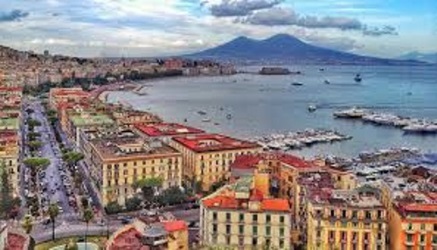 Mergilina is in the
foreground with its marina. The
Hotel Vesuvio is the second
building with the red roof. The
park is further up on the left;
green trees. A little futher on to
the right is the Egg Castle.
|
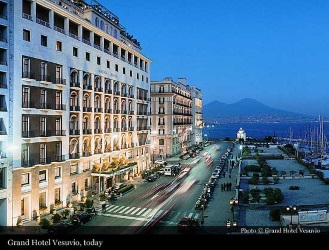 The Hotel Vesuvio was my favorite place to stay when I was in Naples. It was close to the tennis courts and had a great bar. I was told that the bar was sometimes frequented by Russan KGB. |
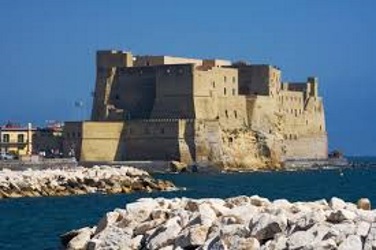 The Egg Castle
|
The
Port of Naples:
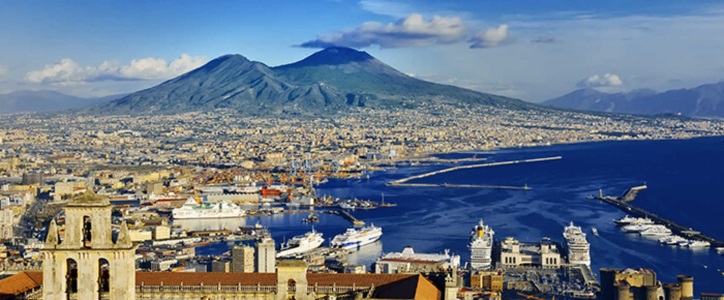 This is a
spectacular picture of the port of
Naples with Mount Vesuvius in the
background. If you were getting
off the white ship in the lower
left of the picture, you would be
at Fleet Landing. We would ride
the liberty boats to and from the
the carrier which would normally
anchor off to the right outside
the breakwater.
|
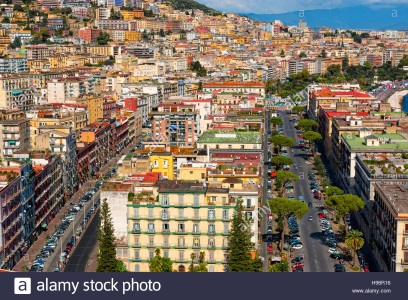 Naples is a
medieval city that covers a large
area. There are many plazas and
interesting places to visit
throughout the city.
|
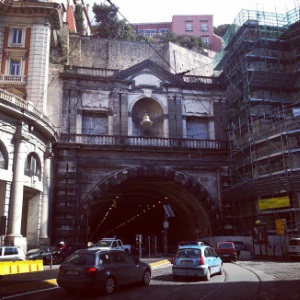 Take an exciting
ride through Tunnel della Victoria
to get to AVSouth
|
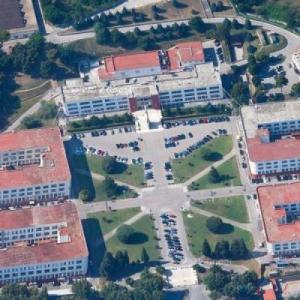 AVSouth is the NATO
Headquarters Southern Command. It
had an excelent Officer's Club
|
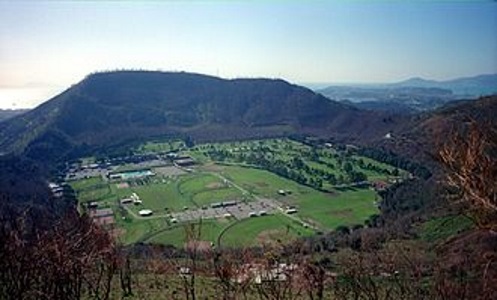 This is Carney
Park. Located in the cadera of an
extinct volacno, it was a great
place to hold squaron or ship
athletic events and picnics.
|
Now let's visit Pompeii:
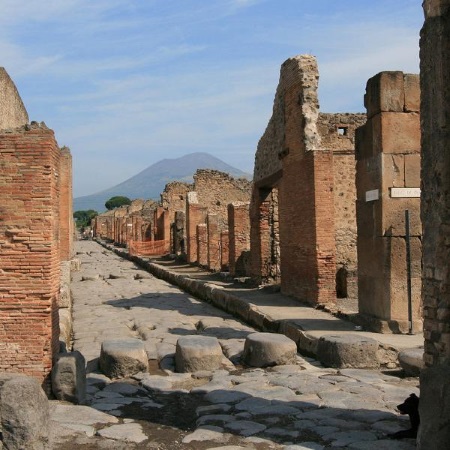 |
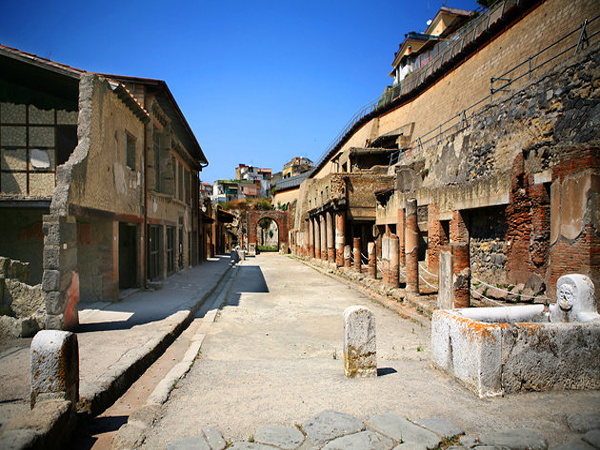 |
On to the Sorrento Peninsula:
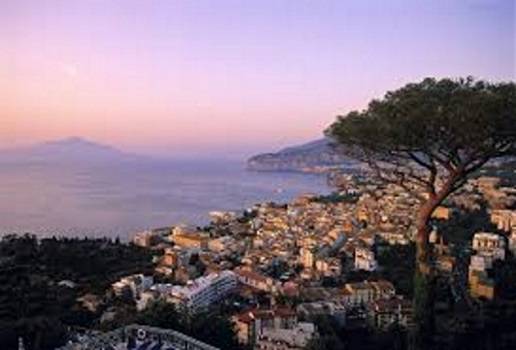 It's a beautiful
drive along the coast from
Herculaneum and Sorrento
|
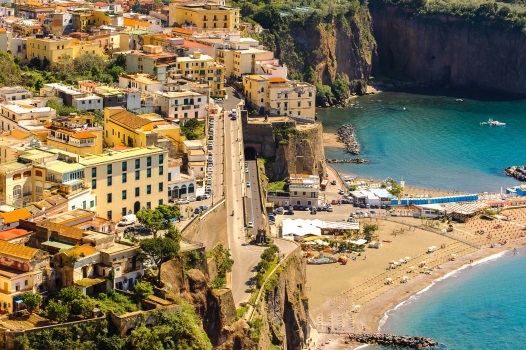 There are nice little
hotels, excellent restaurants and
great shopping in Sorrento. Get
yourself a fossil marble table top.
|
Then
drive across the peninsula and stay for a
few days on the most spectacularly beautiful
coastline in the Mediterranean.
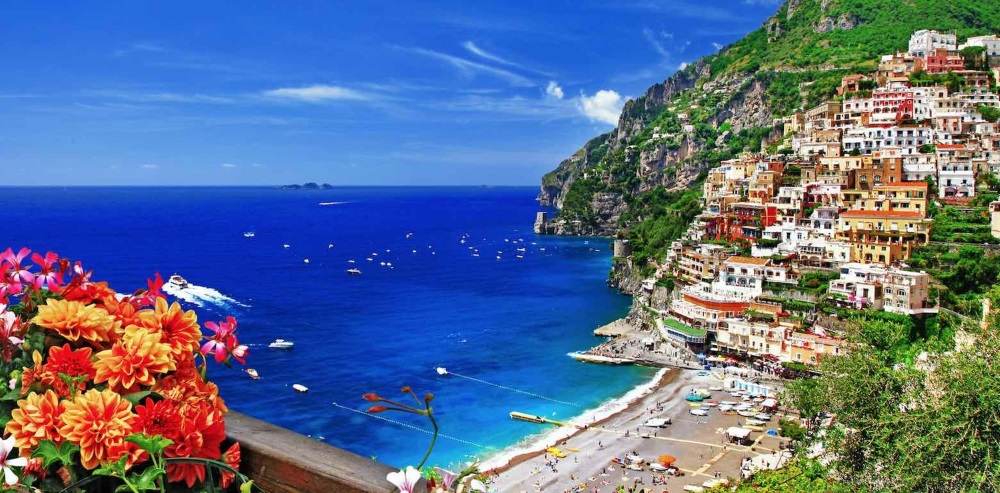

Positano on the Amalfi coast was one of my favorite places to spend time in the Mediterranean
Our
final stop will be the Isle of Capri:
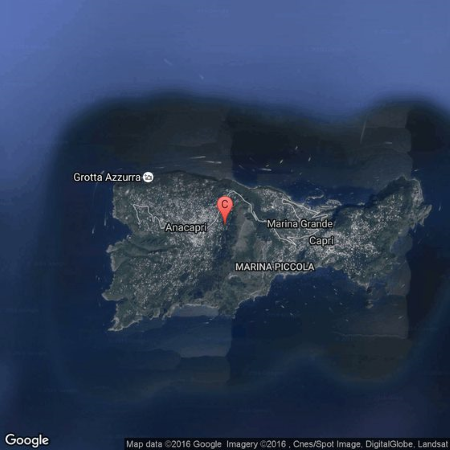 I'm afraid you will need a
boat or take a ferry to get to
Capri.
|
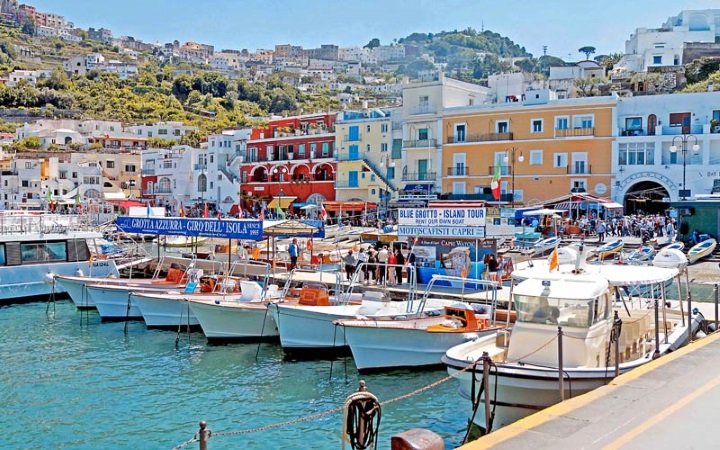 Capri has some nice
shops,restaurants, and places to
stay. But, for me, the action is
on the other side of the island
where there are a couple of
restaurants with great views and
of course the Grotto Azzurra
(The Blue Grotto)
|
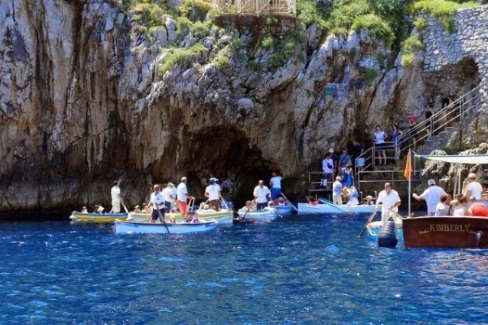 You will some kind of a
boat, even a row boat, or a
canoe to get you to the Blue
Grotto.
|
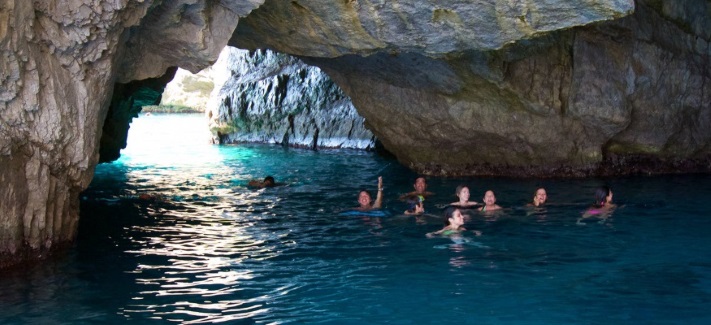 You can enter the grotto
by a small boat or canoe
or swim in. There are lots of
schools of small silver fish
that swim in very large schools.
The light reflects off of them
as you swim through the school.
Its a fantastic experience.
|
We were underway from Naples
on April 20th, 1966
We didn't do any flying during our transit to the Philippines because we had to steam as fast as we could to get to there on time.
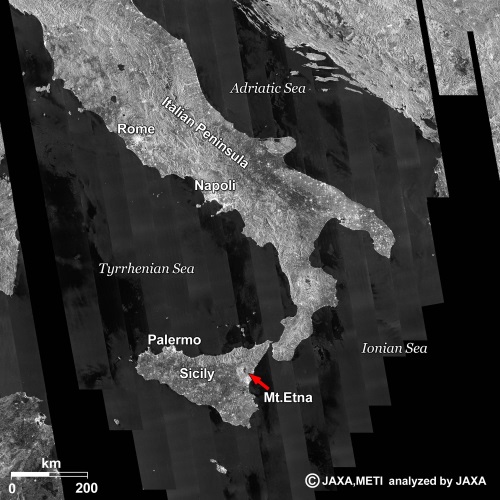 |
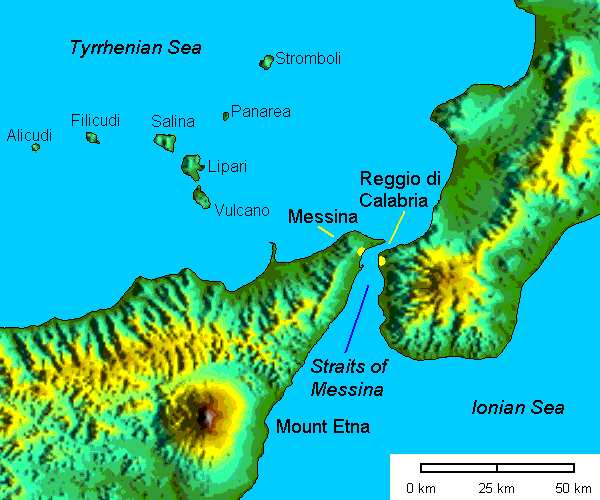 |
Our route
would take us south southeast from Naples
through the Tyrrhenian Sea. The
volcanic island of Stromboli passed to our
starboard as we proceeded to the Straits of
Messina.
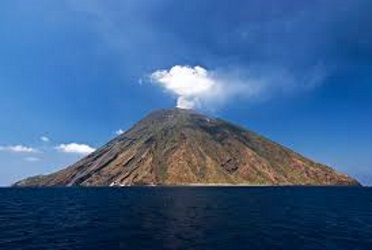 The volcanic island
of Stromboli
|
 This how the
Straits of Messina looked during
going north to south;
The Italian town of Catania on the left, Sicily and Mount Etna on the right. |
Our transit from the Straits of
Messina to Port Said at the entrance of the
Suez Canal
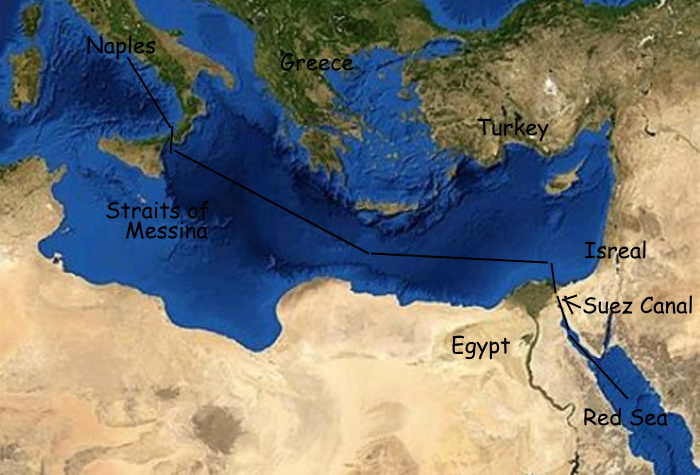 |
The Suez Canal
| From
Port Said, we headed south with all
the other southbound ships to Great
Bitter Lake where we paused to let the
northbound ships pass us. From Great Bitter Lake, we continued south to Port Suez and the Gulf of Suez. From the Gulf of Suez, we continued southeast to the Red Sea. 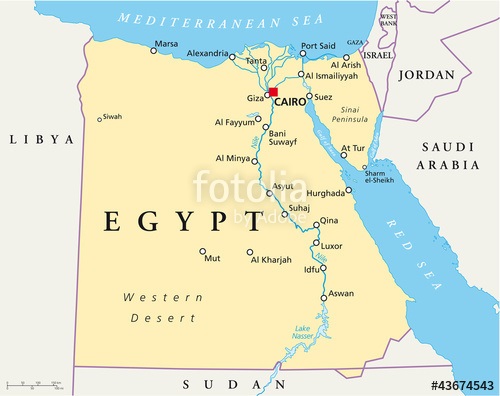 |
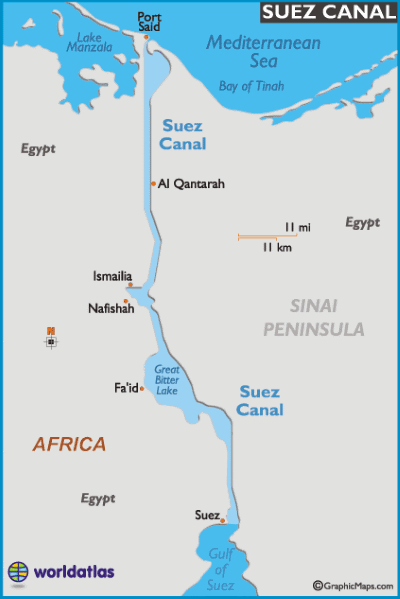 |
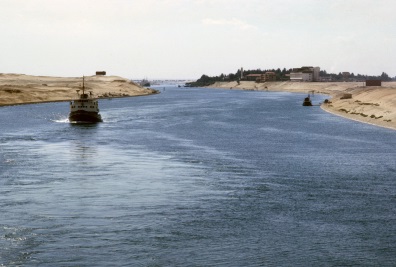 Not much room for an
aircraft carrier!
|
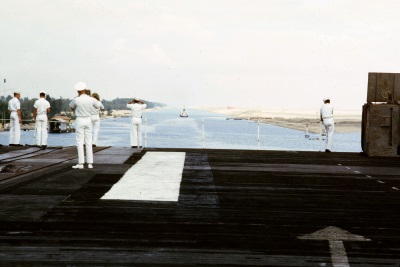 Sightseeing in our
Tropical White uniforms.
The Sinai Desert on the left, Egypt on the right |
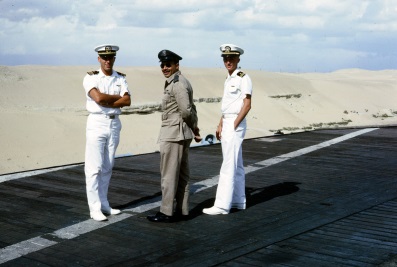 Dave North and Doc
MacMillan talking with an
Egyptian Air Force officer.
|
Squadron Picture Taken during our
transit of the Suez Canal
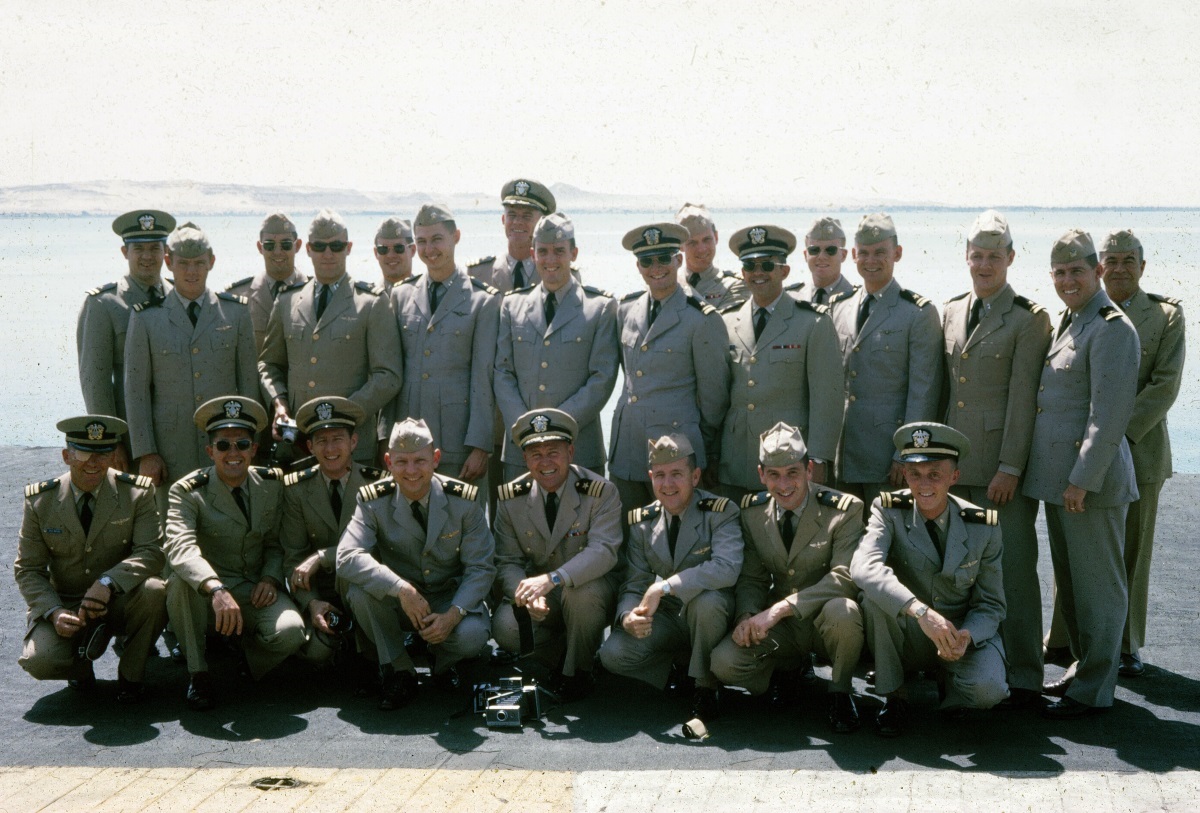 |
| Back Row: Lt
John Hawthorne, Ltjg Dick Nolte,
ME, LT Dave North, Ltjg Dave
Thornhill, Lt Lee Cole, Cdr. Ike Jones
(XO), Ltjg Dave Parsons, Ltjg Bob Hamel,
LCDR Pete Schoeffel, Lt Bob Cheyne, Ltjg
John Newman, Ltjg Bob Cole, Ltjg P.C.
Craig, Ltjg Dave Culler, Lt Shep
Shepperd Front Row: LCDR Bill Butler, Ltjg Miller Detrick, LCDR Moose Moran, LCDR Possum Terrell, Cdr. Jack Gracey (CO), LCDR Jerry Tuttle, LT Moon Moreau, LT Doc MacMillan (Ltjg Gene Atkinson and our new Air Intelligence Officer, ENS Dave Moyer would not join the squadron until we arrived in Cubi Point) |
From the Red Sea to Subic
Bay/Cubi Point, Philippines
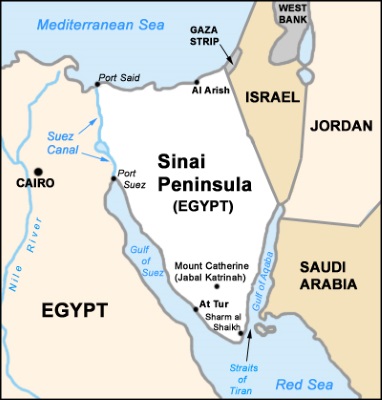 |
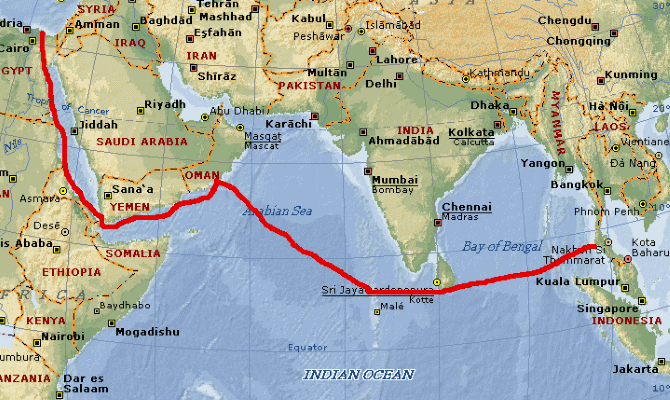 |
From the
Gulf of Suez to the Red Sea to the Gulf of
Yemen to the Arabian Sea to the Indian Ocean
to the Straits of Malacca.
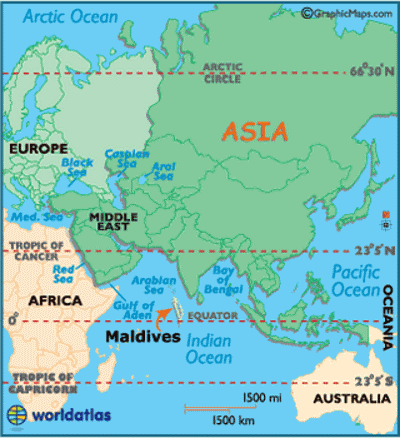 |
If we had the time, we could have crossed the Equator by going south of the Maldives. But, we were short for time, so we probably went to the north of the Maldives and south of Sri Lanka as a more direct route to enter the Straits of Malacca. We would have to save the opportunity for having a Crossing the Equator ceremony complete with King Neptune, shell backs and pollywogs for another trip. As it turned out, that never happened for me in VA-15. I had to wait until I was in VA-82 in1971 when we crossed the Equator enroute to Rio de Janeiro. |
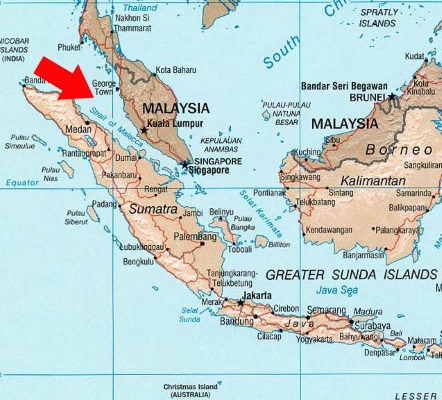 |
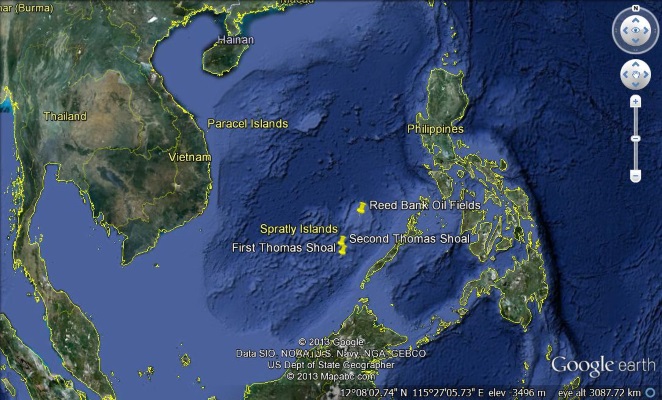 |
Transit
the Straits of Malacca between Malaysia and
Sumatra, pass by Singapore, hang a left into
the South Cina Sea to the Philippines.
Intrepid made it on time I We flew off to NAS Cubi Point on May 6th, 1966:
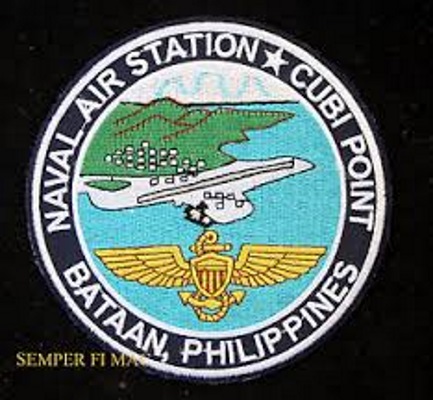 |
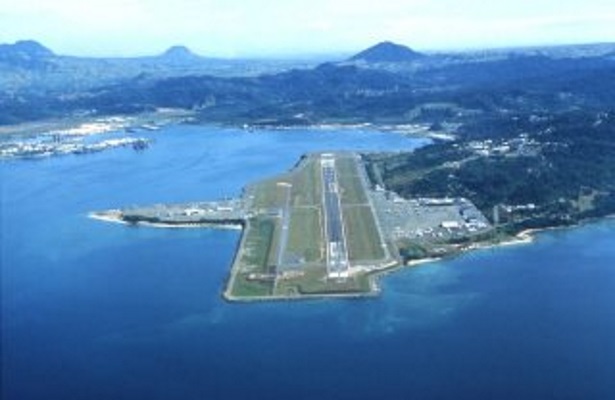 |
The
carrier pier at Cubi Point is perpendicular
to the runway on the left. The BOQ and the
famous Cubi O'Club are on the hill to the
right.
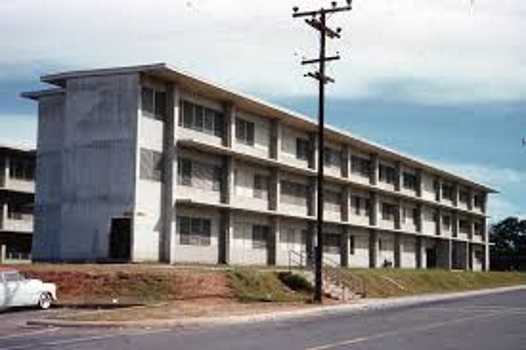 The BOQ at Cubi
wasn't spectacular but it was a
great place to rest after a night at
the nearby O'Club
|
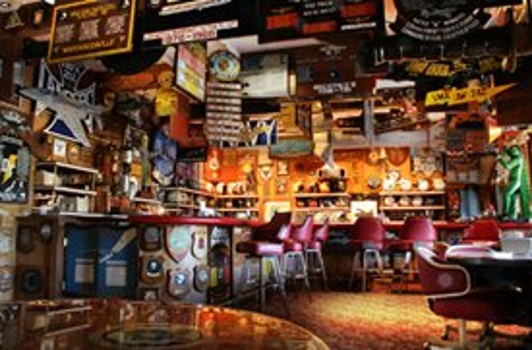 The Cubi O'Club was
famous for it's plaques and Cubi
Specials. It was the Trader Jons of
the western Pacific
|
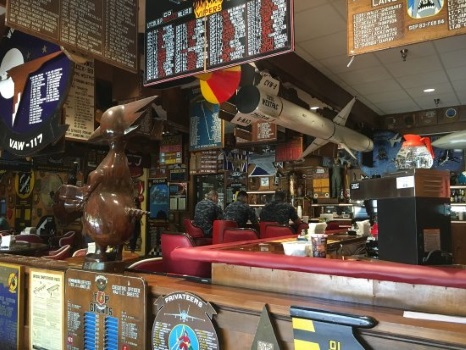 The Cubi O'Club was
such an important part of Navy
western Pacific (WESTPAC) tradition
that it has been recreated at the
Naval Air Museum in Pensacola
|
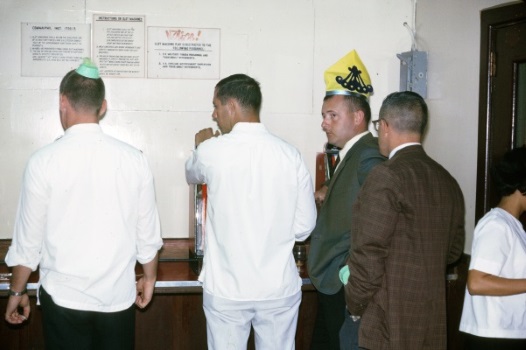 Bob Cole (Cozy) on
the left and Bob Cheyney (brown
jacket) were playing the slots when
the new pilot, Ltjg Gene Atkinson
(yellow party hat) joined us.
The dress code at the Cubi Club in
1966 was jacket or barronge.
|
New Air Intelligence Officer (AI)
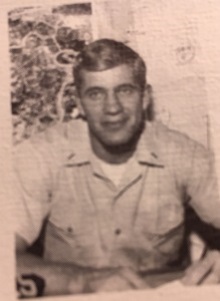 Ltjg Dave Moyer
|
I'm
not sure when Ensign Dave Moyer reported to
the squadron
and relieved the Lt John Hawthone as
our AI. John was in the squadron
picture taken while transiting the
Suez Canal, Dave was not. But Dave
was the AI before we made the Sasebo
in port visit in August. Gene and I think that Dave may have joined the squadron in Cubi at the same time as Gene did. Dave Moyer was an Ensign when he reported to the squadron and made Ltg later. |
Olongapo City
When the Subic Bay Naval Station and Cubi Point Naval Air Station were built, the inhabitants living on the land had to be relocated and the land leveled. Most of the people that were moved were members of the Negrito Tribe. They were relocated to a jungle area on Cubi Point property.
More about the Negritos later.
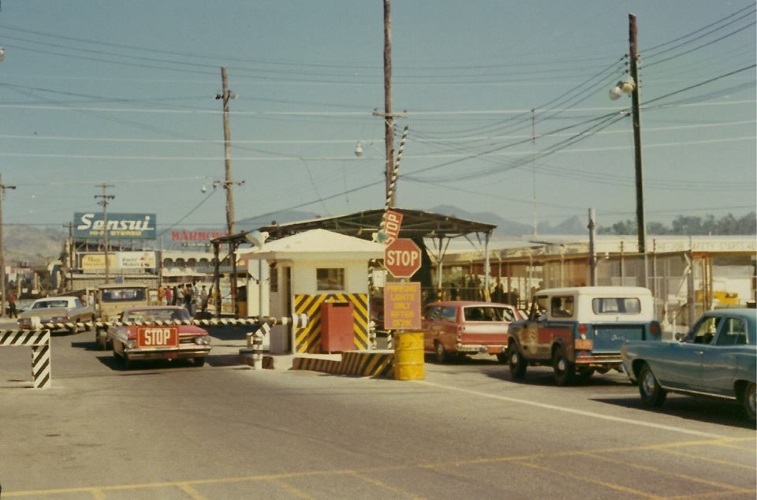 As the bases were
developed and town built up.
The dividing line was the
Olongapo River. So, the town
became known as Olongapo.
Access to the town from the base
was via a bridge over the Olongapo
River.
The image to the left shows the Naval Base Olongapo Gate. |
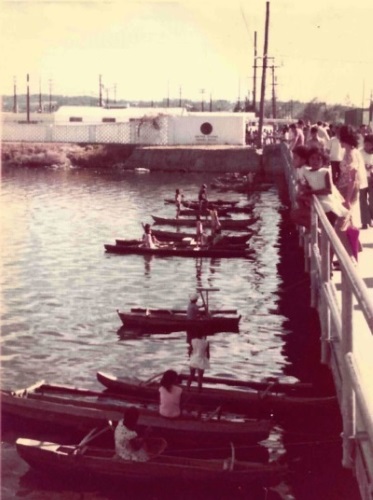 After the main
gate, you walk across a bridge
over the Olongapo River. There are
usually numerous small boats with
teenagers wanting to drive for
coins.
|
 |
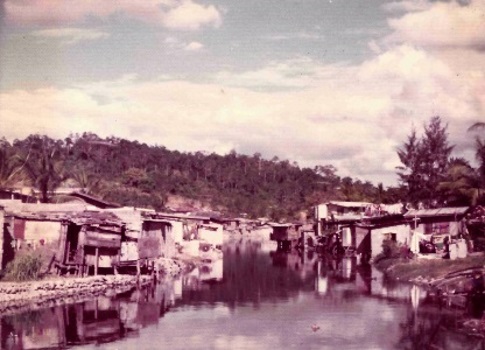 |
| Once across the
bridge, you could either walk up the
main street (which was not paved
1966) or take a Jeepney to the bars
and restaurants. The original Jeepneys were converted US WW2 jeeps. This picture was taken in the early 1970s with nice paved streets and remanufactured Jeepneys. |
The people of
Olongapo were mostly very poor
especially in the early days
(1960s). The average daily earnings
of most of the people was about
$3/day. The bar, restaurant, and
furniture company owners were much
better off. The furniture companies
in Olongapo produced outstanding
quality rattan and mahogany
furniture. |
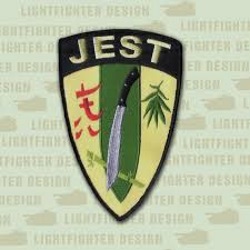 |
Jungle
Escape and Survival Training
(JEST) |
Although all pilots and aircrew personnel had been through SERE (Survival,Evasion, Resistance, Escape) training back in the states, all aircrew on their way to flying over Vietnam completed Jungle Escape and Survival training in Cubi Point before flying combat missions. In 1966, the training lasted two days and one night. The administrative personnel were navy and Marines. The jungle instructors were Negrito Tribesmen. The Negritos were from the mountain jungles and had been resistance fighters against the Japanese during WW2. After the war, some members of the tribe relocated to the jungles on the coast onthe land taken over by the Navy for the construction of the bases. The Negritos were survivors and were enthusiastic and effective instructors of techniques required to survive in the jungle.
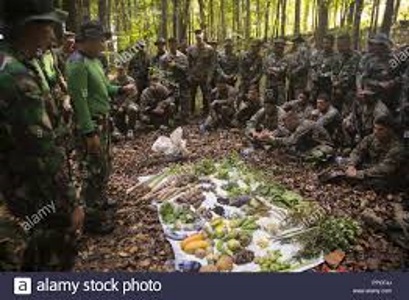 The first day was
dedicated to lectures followed by
hiking in the jungle with stops
along the way for practical
instruction.
|
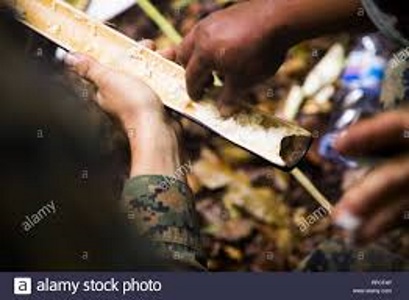 One of the
techniques we learned was how to
prepare a protein rich meal from
the jungle except for a bit of
rice we carried with us.
|
This technique involved catching small fish and any other animal material and putting them along with some rice into a section of green bamboo found along the trail. Add some water and steam the rice and bits of fish/insects etc. for awhile. Then open the bamboo and use one of the halves as a plate. Voila, a protein rich meal.
We spent the night hiking for a short while to learn that you cannot see very far in the jungle at night. We would take off our outer green shirt and hike with just a white T shirt. In the jungle at night, you can't see the guy in front of you even for more than three feet or so even with a white T shirt on. Lesson learned; don't try to move at night in an unfamiliar jungle. Stay put, and move during the day.
We slept in the jungle clearing at night sleeping on a platform made from jungle materials (to stay above all those creepy crawlies that move along the jungle floor at night.
The next morning at daylight, we hiked out of the jungle and had breakfast at the mess hall.
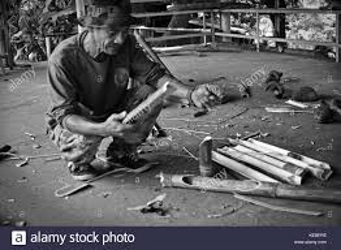 The Negritos made excellent tools for jungle survival such as fishing hooks, arrows for their crossbows, and knives. |
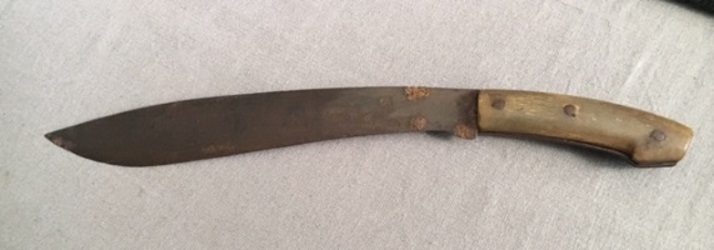 The trademark
Negrito knife was this machete (pictured in the
JEST emblem).
The one in this image is mine; made for me by a Negrito named King. He actually made it for me before our second cruise. The blade is made from a old US Army jeep spring (WW2 jeeps were made mostly by Ford and used high quality American steel) The handle is made from white water buffalo horn. (I donated it to the National Flight Academy at NAS Pensacola, Florida) |
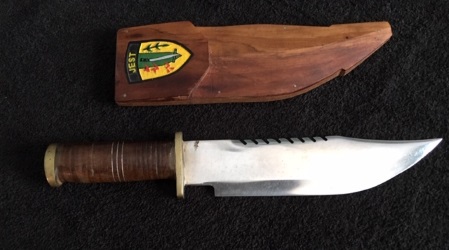 The Negritos also
made excellent, less practical,
but very popular Bowie knives like
this one of mine. It has a chromed
blade and a custom made mahogany
wood sheath with the JEST emblem.
(I donated it to the National Flight Academy) |
Time for Getting Down to Business
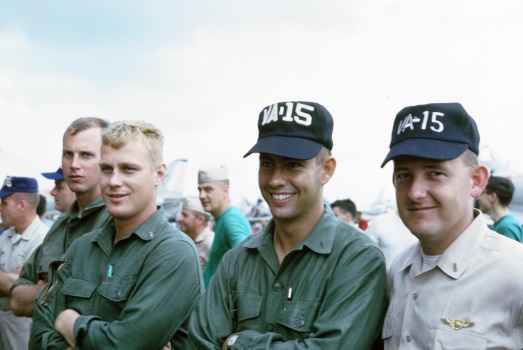 left
to right: two pilots from another
squadron, me, Gene Atkinson
|
Gene
Atkinson (AKA Sid, AKA Wimpy) reported
to VA-15 in Cubi Point. After
completing VA-44, Gene flew commercial
from Jacksonville to Clark AFB just to
the north of Cubi. He took a bus to
Cubi and reported for duty. We had
only arrived a day or so before. As the junior guy, Gene was assigned as the CO's wingman. He flew one flight at Cubi with the CO before walking aboard Intrepid for a ride out to Dixie Station. His second flight with the squadron, his first off Intrepid was a combat flight with his new flight leader, Cdr Gracey. Instead of wearing orange flight suits, we were issued the matching olive drab cotton shirts and pants I am wearing in the picture for our missions over South Vietnam. |
I flew two flights in Cubi on May 10th before flying onboard Intrepid on Dixie Station on May 12th, 1966
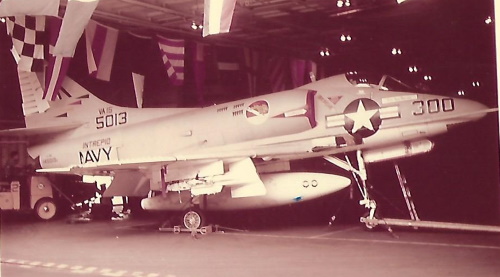 |
In addition to flying my combat missions, as the Aircraft Division Officer I was destined to spend a lot of time on the hangar deck. |
Dixie Station Squadron Picture
Dixie Station- Our First Line Period- May 15th - June 14th, 1966
Underway Replenishment (Fuel)
Underway Replenishment (Ammo)
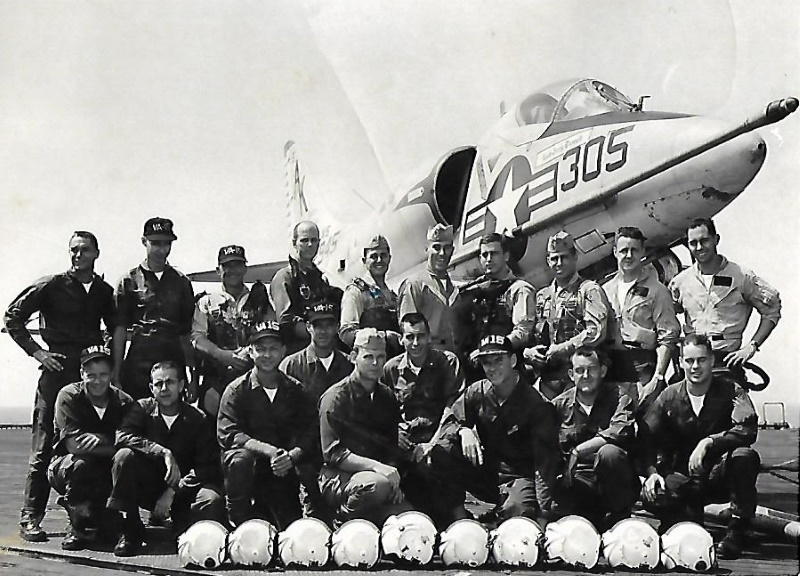 |
| Back
Row: Bob Hamel, Lee Cole, Billy Butler,
Pete Schoeffel, Miller Detrick, Dave
North, Dave Parsons, Dixie Culler, P.C. Craig, me Front Row: John Newman, Jerry Tuttle, Possum Terrell, Dick Nolte, Bob Cole, Moon Moreau, Ike Jones (XO), Gene Atkinson, Dave Thornhill (Not pictured-Jack Gracy-CO) |
| The pilots were ready to go! |
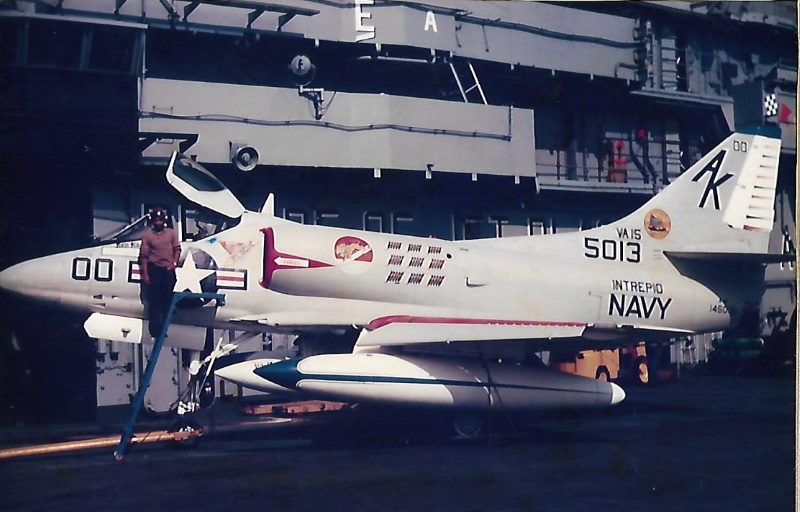 |
| The
aircraft were ready to go! |
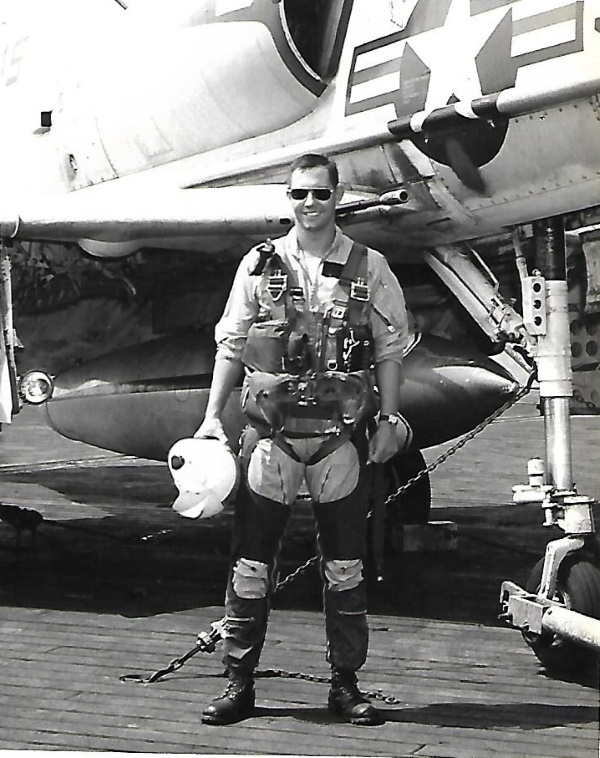 |
| I
felt very confident that I was
ready to go into combat. We had accomplished a very aggressive training program. I felt that Possum Flight was well prepared for the task ahead! |
Dixie Station- Our First Line Period- May 15th - June 14th, 1966
Underway Replenishment (Fuel)
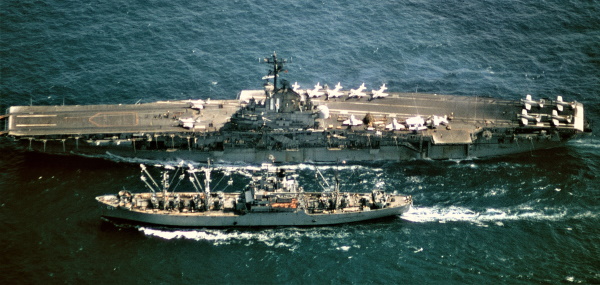 |
Every three or four days, Intrepid would replenish ship and jet fuel while underway on Dixie or Yankee station. |
Underway Replenishment (Ammo)
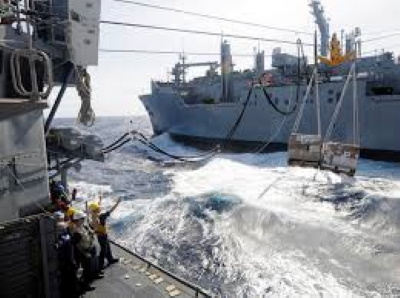 Underway supply of bombs, rockets, missiles, and ammo from a replenishment ship (AE) to an aircraft carrier. |
Sometime
while Intrepid was in transit, the
decision was made by CTF77
(Commander Task Force Seventh Fleet)
that the dedicated Dixie Station
carrier did not require first rate
MK 80 series bombs ( MK81 250#, MK82 500#, MK83 1000#, MK84 2000#) that Commander Naval Air Force Atlantic Fleet (COMNAVAIRLANT) had gone to great pains to load up the Intrepid with the best quality bombs. As soon as Intrepid left Subic Bay, she off loaded all those MK80 series bombs to an AE (ammunition supply ship) enroute to Dixie Station. They were replaced with World War II "fat" bombs. The old "fat bombs" were very difficult to handle onboard the ship. The ordnancemen had no forklifts and many of the bombs came without pallets and had to be assembled on the hangar deck and then rolled a around on the hangar and flight decks. ** Paraphrased from Alpha Strike Vietnam, page 96. |
Fat
bombs positioned forward of the
island after an unrep ready to be
move to the hangar deck.
|
As it turned out,
although the "fat bombs" were
difficult to handle Although the "fat bombs" were difficult to handle onboard by the "ordies" and lacked the thermal protection of the MK 80 series bombs, they turned out to be ideal for the close air and direct air support missions from Dixie Station. The 220 lb "ring frag bombs" were excellent for the A4s because the Skyhawk could carry a lot of them and they were effective against enemy soldiers on the ground. The 2000lb fat bombs were ideal for the Spads because they could carry a big punch. |
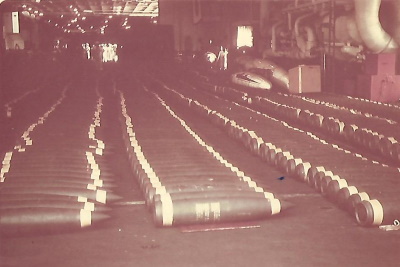 |
Mk 82 bombs on the hangar deck after an unrep |
Types of Dixie Station Aircraft Configurations and Weapons Loads:
The A4 internal fuel capacity was 5400#s of fuel. It is capable of carrying three drop tanks (fuel tanks; each with 2000#s of fuel) for long range transits (no weapons).
Or, the A4 can carry two drop tanks (4000#s of additional fuel) and a refueling store for inflight refueling.
Or a centerline drop tank (2000#s of additional fuel) and two Multiple Ejection Racks (MERs) carrying 10 of the new MK 81 or MK 82 bombs or 10 to 12 of the old 220 ring frag fat bombs.
Or, LAU 10 5" rocket pods on TERs (two pods per TER, four rockets pod), or LAU 3 2.75# rocket pods (two pods per TER with 19 rockets per pod)
Or, we could also carry napalm on the TERs.
Each A4 had an two internal 20mm guns available on every mission.
We could also carry a MK 4 gun pod which had a high rate of fire 20mm capability on each parent wing station. But the gun pod was not very reliable and required removal of the MER or TER which proved impractical.
After off loading all those Mk 80 series bombs before the first line period, we began stocking up on the Mk 81s (250 lb), MK 82 (500 lb), MK 83 (1000 lb), and even some MK 84 (2000 lb) boms because we used up the old bombs quickly and more MK 80 series bombs became available. Mk
80 series bombs temporarily
positioned in the "bomb farm" on the
starboard side of the island during
flight operations.
|
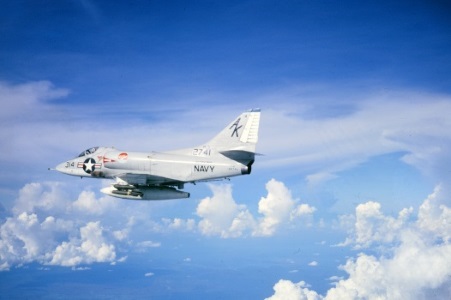 This was our standard
bomb load; a center line tank with
two TERs with 6 MK 82 500#
Or, we could replace the bombs with four LAU 10s (16 5" rockets). Or four cans of napalm |
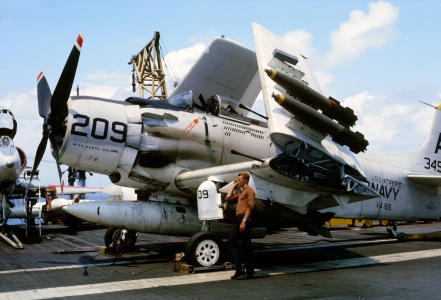 This is a standard
Spad bomb load
It could carry lots of bombs or rockets had four 50 cal guns on the wings and could stay on station much longer than our A4s |
Our average mission lasted 1 hour and 45 minutes which was controlled by the cycle time desired for the carrier deck (spot the deck for launch, launch aircraft, recover the previous cycle, respot the deck. The pilot indicated a thumbs up or down following landing which determined whether the plane was spotted for ready for the next launch or in a maintenance spot (hard down aircraft went to the hanger deck). The plane captains, trouble shooters, and ordnance men had about 45 minutes to make the plane ready for the next launch cycle while the flight deck fuels guys refueled the plane during the same time frame. Our squadron would have four planes (one division) on one cycle and eight planes (two divisions) on the next cycle. This required that 12 of our 16 aircraft had to be mission ready. We often had one additional plane configured as a tanker so we often had 13 of 16 ready. The other A4 squadron (VA-95) had a similar tasking. So, the ship had 12 A4 mission aircraft and one tanker assigned to each cycle.
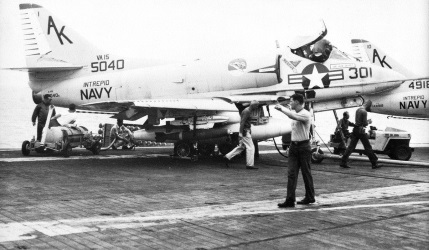 |
Getting the aircraft ready for the next launch. The ordies (red shirts) have the get the bombs loaded. The troubleshooters (green shirts) and the plane captain (brown shirt) have to get the plane ready for flight. The purple shirts (flight deck refueling crew) need to get the plane refueled. All this in about a 45 minute period before the plane director (yellow shirt) can have a brown shirt remove the chocks for taxi. This picure also show to LOX crew replenishing the plane's liquid oxygen. |
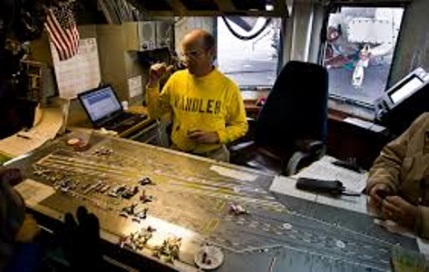 |
The respotting of aircraft after landing is coordinated by the Air Boss in PriFly and the Aircraft Handling Officer in Flight Deck Control. The Handler is responsible for spotting the aircraft for the next launch or getting down aircraft out of the way either on the flight deck or in the Hangar Deck below. |
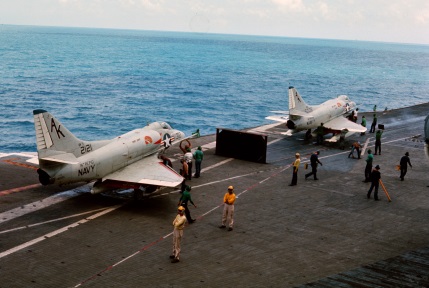 |
This picture shows some of the various colored shirt personnel getting the plane ready behind the port catapult (Cat 2). The vertical barrier between the aircraft protects the aircraft behind the cat (a bomber) from the jet exhaust of the plane on the cat (a plane configured as a tanker). |
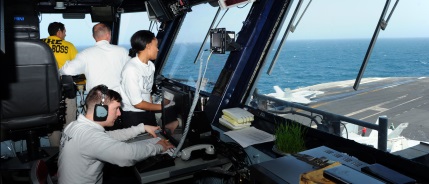 |
The
movement of aircraft on the flight
deck during launch recovery of
aircraft is the responsibility of the
Air Boss who operates from Primary
Flight Control (PriFly) on the port
aft side of the island. He and
his staff in PriFly communicate with
the various flight deck directors and
officers on the flight deck and
the Landing Signal Officer (LSO) on
the LSO platform to ensure the safe
launch and recovery of aircraft. |
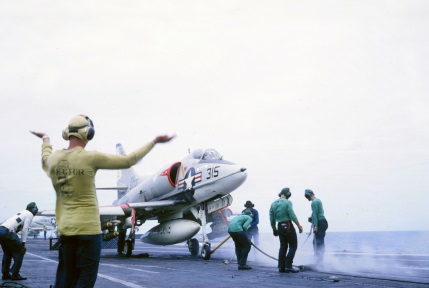 |
This picure shows a standard mission configured aircraft on Cat 2 with a centerline drop tank and a TER on each wing with MK 81s (250# bombs) or MK 82s (500# bombs). |
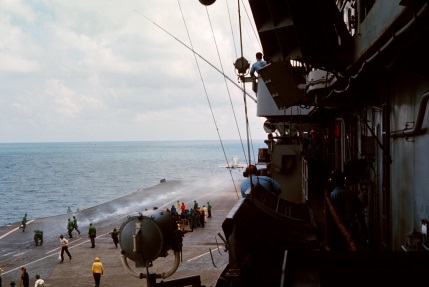 |
This picure shows the aircraft off the end of the bow after being shot off Cat 2. As soon as the pilot is comfortably airborne, he will make a turn to clear his jet wash for the next plane which will be launched off Cat 1. |
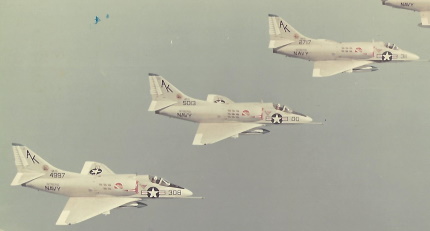 |
Once the flight joined up, we would fly to our anticipated point in the Mekong Delta where we were briefed to meet up with a Forward Air Controller (FAC). |
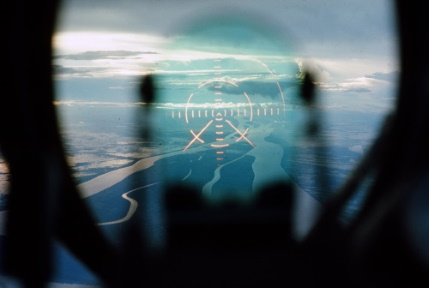 |
Coasting in to the Mekong Delta through an A4B gunsight. |
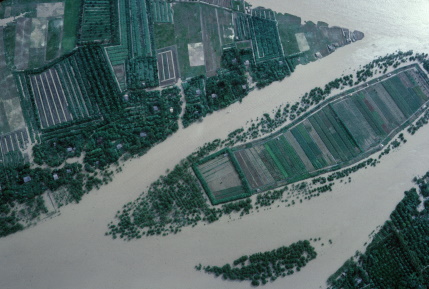 |
The Mekong Delta produces most of the rice crop consumed in South Vietnam. The rice paddies made movement through the terrain difficult for conventionally equipped army units. The Vietcong were comfortable in the delta and controlled large portions of the more inaccessible areas for most of the war. |
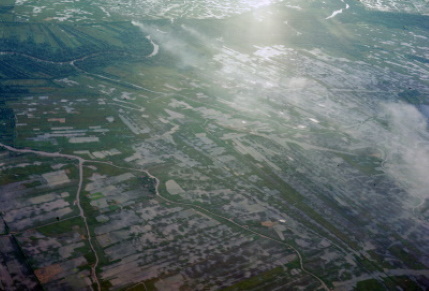 |
The division leader navigated to a rendezvous point with ordnance specified by the "frag" . The "frag" was published by US command forces in Saigon The rendezvous point was usually a bearing and range off a TACAN or a significant feature like the intersection of two rivers or a karst mountain (in the western delta) |
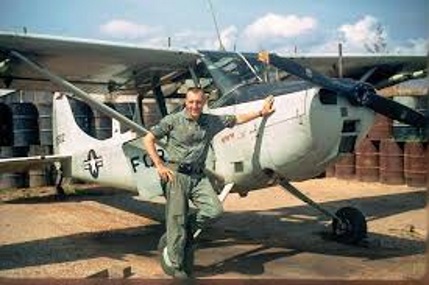 |
The FACs flew Piper Cubs which we called Bird Dogs. The FACs flew at a safe altitude above the target which depended on whther the target area was defended or not. Most targets in the southern part of South Vietnam were only defended by small arms fire from the Viet Cong (VC). The top of the FACs wing was usually painted red so the FAC could be seen more easily by the division lead who was normally flying at 8-10 thousand feet. |
 |
Once
the flight leader had the FAC in
sight, the FAC would fly to the target
area and mark the target with a flare
called a Willie Pete. The flare would
not only indicate the target but also
the surface wind direction. The flight would set up a circular bomb pattern to the left (jet pilots like to turn left for some reason). The flight leader would drop one bomb and pull back up into the pattern. The FAC would call a correction to the next pilot would drop one bomb. This would continue until the FAC considered the target destroyed and if the flight had more bombs, the FAC would move to another target. |
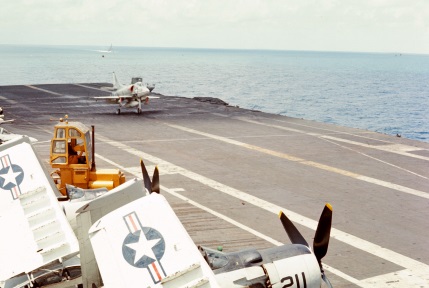 |
After
the mission, the flight would return
to the ship for recovery. It looks as if this A4 has engaged the target wire (the 3 wire) on centerline. The there four arresting wires on modern aircraft carriers. The Intrepid had five. If you look over the canopy of the landing A4, you can barely see the LSO platform. If you look over the LSO platform and a little to the left, you can see the wake of the Plane Guard destroyer which is positioned to come to the aide of an aircrew incase of a crash during flight operations or a man overboard during regular steaming. |
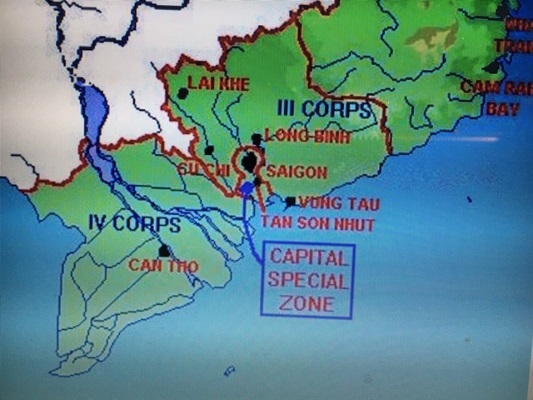 |
At the beginning, Dixie Station was about 75 miles off the coast of South Vietnam southeast of Saigon. Initially, most of our missions were in the Mekong Delta south of Saigon in support of US Army and South Vietnamese ground forces (ARVN) in the IV Corps area. We were assigned missions that were part of a general plan "frag" coordinated primarily by US Staff officers in Saigon. Toward the end of the line period, we began moving north flying some missions in the III Corps north of Saigon. |
My Large Scale
Combat Map of Flight Operations to the south of
Saigon in the Mekong Delta
Types of Missions and Tactics: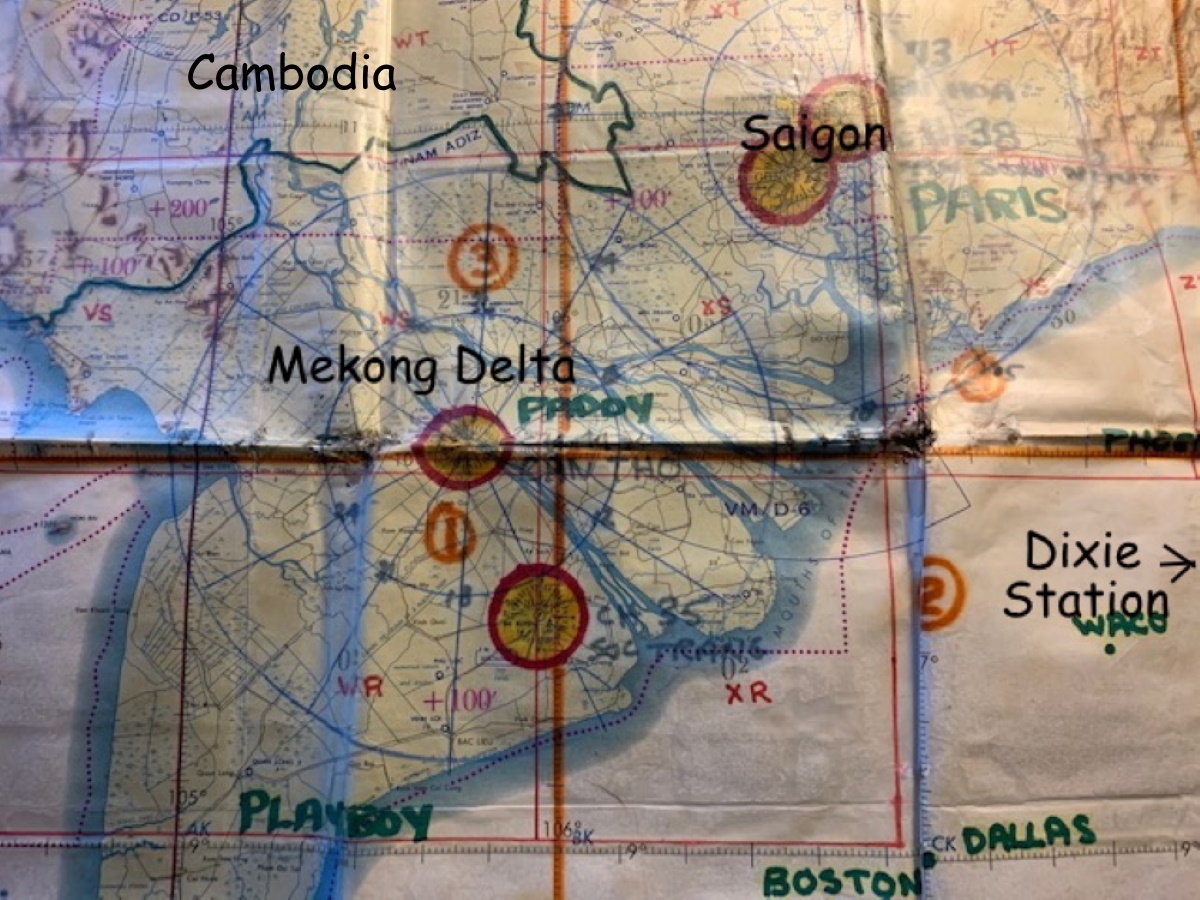 |
There were two kinds of missions in South Vietnam (Dixie Station):
Direct Air Support Missions- Basically, all the missions started out as Direct Air Support missions (DAS). The frag order directed the weapons load, a rendezvous position to meet the FAC, the FACs call sign and check in UHF radio frequency, and the time for check in. The normal weapons load was bombs, second 5" (LAU 10s) or 2.75 mm (LAU 7) rockets, and last napalm. If there no troops in contact assignment (close air support) missions, the FAC would designate a direct support target. Direct support targets consisted of suspected VC base camps, VC weapons caches, or transshipment points (trails or small bridges). We generally described them as bombing trees. Occasionally, we would get secondary explosions at the target indicating that we had hit a weapons cache or base camp. After the mission was complete, the FAC would give us a BDA (Bomb Damage Assessment) to report to the ships Air Intelligence Center (AIC) following landing.
Direct Air Support Tactics- As described previously, the FAC would fly to the target area and mark the target with a flare we called Willie Pete. The flare would not only indicate the target but also the surface wind direction. The flight would set up a circular bomb pattern to the left at about 10,000' with each aircraft in the flight about 90 degrees from each other. When each pilot indicated that they had the target (Willie Pete) and the FAC in sight, the flight leader would initiate a 30 degree angle bomb run, release one bomb at about 4,500', and initiate a 3-4 G pull-up back up into the pattern (minimum altitude 3,000' above ground level or AGL). The FAC would call a correction to the next pilot would drop one bomb. This would continue until the FAC considered the target destroyed. For 'bombing trees' type targets, we might begin dropping two bombs per run once we were on target. We seldom encountered any opposition for these type missions; at least none we could see. Occasionally, the FAC would report that he was taking fire and directed us to bomb the source of the ground fire. In this case, we knew that the target was a 'real target and not just 'bombing trees'!
Close Air Support Missions and Tactics- About 30% of the time, the FAC would have a close air support mission for us. Close air support missions (CAS) involve friendly troops on the ground in contact with Viet Cong (VC) troops. Friendly troops included US Army and Vietnamese Army (ARVN) forces. The US Marines were located in the northern part of South Vietnam. In CAS missions, the FAC would be in radio contact with the friendly force commander by radio (which we couldn't hear) and receive a description of what he needed. The friendly force would mark their position, usually with red flares, and describe the position of the VC forces. If we were carrying bombs, we would fly a similar pattern to DAS missions and drop one bomb at a time until the FAC told us we were on target. Then we would again drop a couple or the remaining bombs onboard the aircraft; whatever the FAC directed us to do. Again we seldom encountered any opposition for these type missions; at least none we could see. But on these CAS missions, the FAC would often report that he was taking fire and would move further away from the VC forces (toward the friendlies) while still keeping the target in sight. If the friendlies were US Army forces, we would press our attacks lower to increase our ability to see the target and have better bombing accuracy releasing the bomb at 3,000 ft AGL with a pull out altitude about 1,500' AGL or even lower if the friendlies were in danger of being over run by the VC.
The CAS tactics were different if we were carrying rockets or napalm. In this case, we would lower our roll in altitude and release the rockets or napalm from a 15 degree angle or so. For rockets, we would fire the rockets at 2,500' or so with a 1,000 ft AGL pull-out for US Army forces; a bit higher for the ARVN forces unless there was a US Army advisor with the ARVN unit who requested us to press out attacks. For napalm, we would release even lower in order to hit the VC if they were close to the friendlies. More details of how our napalm tactics evolved as we gained experience in just a minute.
Whether armed with bombs, rockets, or napalm, we would straffe the target with 20mm cannon if the troops were still in contact to keep the pressure on until the next flight checked in with the FAC. Our 20mm rounds were HEI (High Explosive Incendiary) rounds with a tracer round loaded every 20 rounds or so to enable us to correct our fire on to the target. CAS missions were exciting missions. The BDA included estimated VC weapons destroyed and number of VC KIA (killed in action). These CAS missions usually resulted in a great feeling that we had really accomplished something important.
Advanced Napalm Tactics:
We had reliability problems with our napalm fuses. The fuses were white phosphorus which were designed to ignite the napalm mixture. But these fuses were unreliable as they often shot away from the napalm rather than into it so all we delivered was a bunch of JP 5 jet fuel with some detergent mixed in which didn't go off. So, we developed delivery tactics to solve the problem. To make sure the napalm went off, the wingman of the delivery aircraft (a/c) would fly a combat spread position position on the delivery a/c and strafe the napalm when it hit. This meant a low pull out for the strafing aircraft. But the results were spectacular. When the strafing a/c pulled off the target, he became the section lead for the next run. This tactics was a challenge to execute but was a lot of fun to fly. We gave on heck of a great air show for both the friendlies and the VC but the VC had a much hotter time of it. We got very good at it after a few flights! I think our sister squadron, VA-95, adopted this tactic once they learned about it.
Medals and Ribbons
Most
of us started our the first Vietnam cruise
with with two or three ribbons on our
chests!
Everyone who was in active duty and was breathing wore the National Defense Service Medal.
 |
 |
 |
| The National Defense Service Medal | The Pistol Qualification Ribbon Expert | The Rifle Qualification Ribbon Expert |
Everyone who was in active duty and was breathing wore the National Defense Service Medal.
Some of the
pilots had completed pistol and rifle
qualification at the Naval Academy.
But, all the pilots were required to qualify expert with a 45 cal handgun in order to be qualified as the nuclear weapons loading officer.
But, all the pilots were required to qualify expert with a 45 cal handgun in order to be qualified as the nuclear weapons loading officer.
Significant Missions (War
Stories):
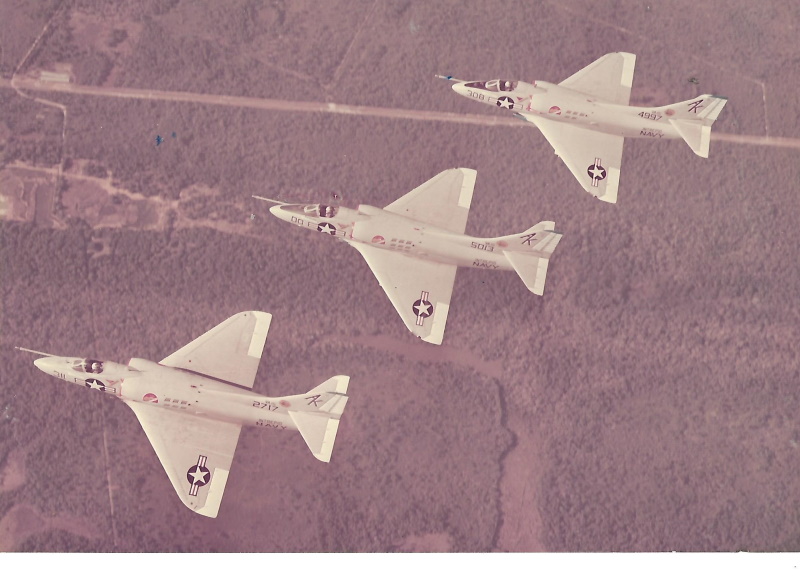 VA-15 A4Bs enroute
to the target
|
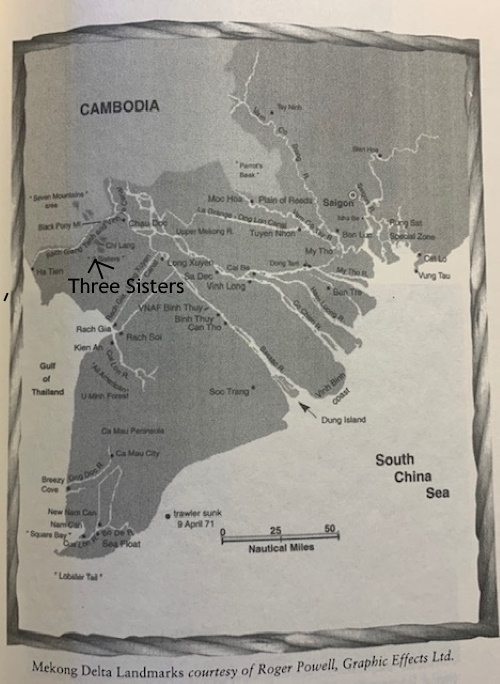 |
Saving a Village
under VC Attack:
One of my most memorable missions of the first line period was when Possum flight was tasked to meet a FAC across the Mekong Delta almost to the Gulf of Thailand (AKA Gulf of Siam) southwest of Can Tho. When we got there. the FAC was talking with someone on the ground inside a small hamlet. The hamlet was under attack by the VC from karst hills outside of the village. The villagers were running from the nearby rice paddies and farms to get inside of the gate of the hamlet. When the villagers were inside, the gate was locked and we were free to assume that anyone outside the gate were bad guys. We had the perfect weapons configuration for the mission, TERs with a combination of 500# Mk82 bombs and LAU 10 5" rockets (8 rockets and three bombs per aircraft). The VC were firing mortar rounds from the hills into the village. It was easy for the FAC to mark the mortar positions for us to bomb the positions one bomb at a time and follow up with very accurate 5" rockets. We were able to engage and destroy numerous mortar positions and strafe any VC running from our attacks. It was a very rewarding mission in that we knew that our flight saved the village from being overrun by the VC. |
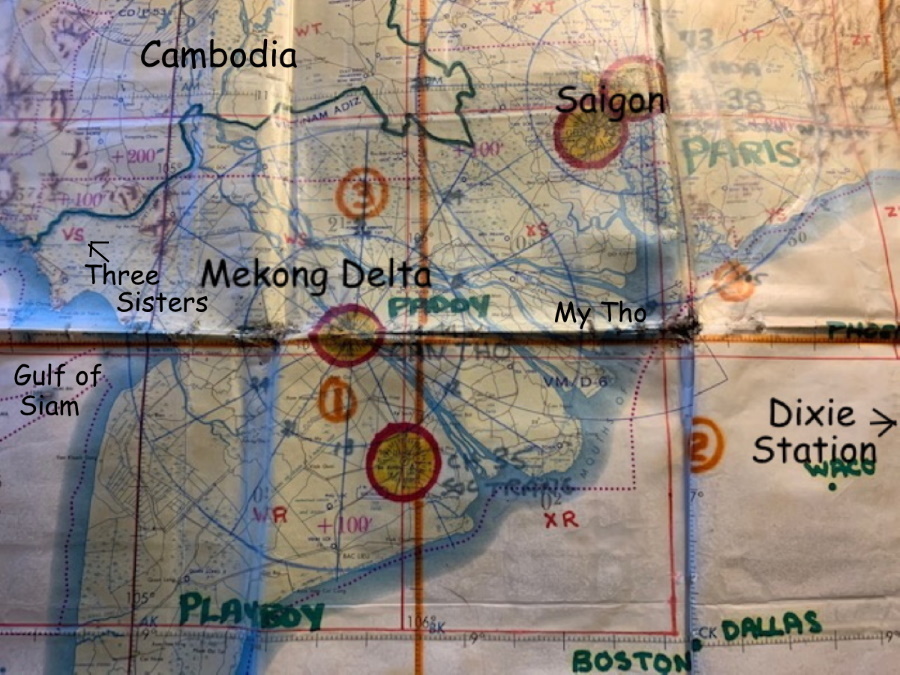
US Army APCs versus VC soldiers in "coolie hats" at My Tho:
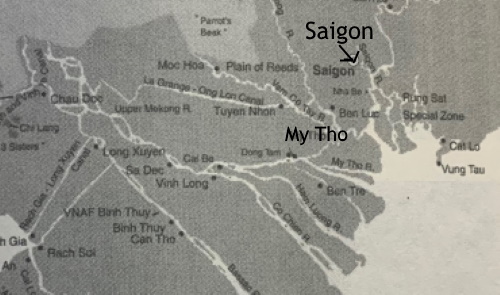 |
Another memorable mission of the first line period was when Possum flight was tasked to meet a FAC south of Saigon somewhere near My Tho. |
This was a very unusual CAS mission because the positions of the opposing forces were easy to identify. The US Army troops were maneuvering around in their APCs (Armored Personnel Carriers) and the VC were positioned behind a berm (a hill along the edge of a cultivated area). The VC were wearing black pajamas. This only happened early in the war when the VC were using more traditional tactics and still wore their traditional Vietnamese attire. Unfortunately for the VC, we were armed with napalm and rockets. They were difficult to engage from the ground behind the berm, but they were sitting ducks lined up behind the berm from our perspective. I don't recall what the KIA call was in the BDA but it was significant. This was a very unusual mission in that we never saw the VC in such an exposed position again. We didn't get these kind of opportunities very often.
Mud on the top of our
Wing:
This happened to both Dave Parsons and me while flying on Possum's wing. It usually occurred when one of us had a radio failure after arriving in the target area. The A4B had an ARC-27 radio which wasn't very reliable. Our Possum flight SOP (Standard Operating Procedure) was if you lost your radio in the target area, you would close on your leader and make section runs rather that individual runs. When the leader dropped a bomb, the wingman did. If the leader fired a rocket, the wingman did. Sometimes, when we were working on a DAS mission for a suspected VC weapons cache, we would get some secondaries and pressed the attack. The section deliveries worked well except there was a little delay in the wingman's pullup. If the pull up off the target was over a water area, the aircraft might fly through the muddy water thrown up by bomb blast or even if the pull op was close to the surface of the water, the pressure wave of the plane might displace some muddy surface water which could end up on the top of the wing. The maintenance guys on the flight deck went wild when one of us came back with muddy wings!
This happened to both Dave Parsons and me while flying on Possum's wing. It usually occurred when one of us had a radio failure after arriving in the target area. The A4B had an ARC-27 radio which wasn't very reliable. Our Possum flight SOP (Standard Operating Procedure) was if you lost your radio in the target area, you would close on your leader and make section runs rather that individual runs. When the leader dropped a bomb, the wingman did. If the leader fired a rocket, the wingman did. Sometimes, when we were working on a DAS mission for a suspected VC weapons cache, we would get some secondaries and pressed the attack. The section deliveries worked well except there was a little delay in the wingman's pullup. If the pull up off the target was over a water area, the aircraft might fly through the muddy water thrown up by bomb blast or even if the pull op was close to the surface of the water, the pressure wave of the plane might displace some muddy surface water which could end up on the top of the wing. The maintenance guys on the flight deck went wild when one of us came back with muddy wings!
This did not happen to me. This was John Newman's (Smeds) claim to fame. First, the A4 wing had slats on the front of the wing which would slide open to increase the camber of the wing during landing. Although not designed to do this, the pilot could snap the slats down if in a high G turn to increase his rate of turn or in a pull-up to decrease his altitude loss. The former was usually done intentionally. The pull up situation was usually initiated by pulling a littler harder to avoid hitting the ground. Smeds was in a flight that was involved in attacking any area in the vicinity of a small building (hooch) with a reddish brown ceramic tile roof. Somehow Smed's had to pop the slats to make the pull-out. The pressure wave of his aircraft caused the house to disintegrate sending tile flying. Some of the tile impacted his aircraft becoming stuck in the slats when Smeds relaxed the G on the aircraft. The FAC went wild! He screamed that he had never seen a pilot destroy the target by flying through it. The VALion legend began. Of course the flight deck guys were amazed. My Aircraft Division AMSs ((Aviation Structural Mechanics) were not as excited as they had to remove the slats and realign the slat tracks before the plane could fly again.
Let's
Destroy the Target with Drop Tank:
Possum flight was on a mission to hit some kind of a point target. I don't remember; probably a vehicle of some type. First of all, I want to point out that from 5,000 feet altitude a water buffalo and a jeep on a narrow road or path look alike if neither is moving. We bombed the heck out of a single dead water buffalo on numerous missions thinking it was a vehicle. On this flight, we were dropping one bomb at a time trying to hit a small target. The flight expended all its bombs without getting any results. Possum was frustrated. He decided to try to hit it by jettisoning his centerline drop tank on the target. The FAC reported that he had never seen anyone attempt to hit a target with a drop tank. The VALion legacy continued.
Possum flight was on a mission to hit some kind of a point target. I don't remember; probably a vehicle of some type. First of all, I want to point out that from 5,000 feet altitude a water buffalo and a jeep on a narrow road or path look alike if neither is moving. We bombed the heck out of a single dead water buffalo on numerous missions thinking it was a vehicle. On this flight, we were dropping one bomb at a time trying to hit a small target. The flight expended all its bombs without getting any results. Possum was frustrated. He decided to try to hit it by jettisoning his centerline drop tank on the target. The FAC reported that he had never seen anyone attempt to hit a target with a drop tank. The VALion legacy continued.
Flight
Integrity:
My initial job as a first tour combat pilot was as a wingman. Our squadron policy was that we would never loose section integrity. That meant that it was the wingman's responsibility to never loose his leader. Even more than that. If the leader wanted you in parade position such as in an echelon coming in to the break for a landing, you were expected to be in perfect position. If the lead wanted you in a maneuvering combat cruise position, that meant that you flew a few plane lenghts away with nose to tail clearance so that the leader could maneuver freely and you could stay with him.
After we first tour pilots gained experience, we were qualified to fly the section leader position. The section leader flew about 3000' abeam of the leader so that he could clear the leader's six o'clock position and watch for ground fire or later up North, AAA, SAMs, or MIGs coming from the opposite side. The leader was responsible for navigation and to clear the section leaders side ground fire and later on for AAA, SAM, or MIGS.
My initial job as a first tour combat pilot was as a wingman. Our squadron policy was that we would never loose section integrity. That meant that it was the wingman's responsibility to never loose his leader. Even more than that. If the leader wanted you in parade position such as in an echelon coming in to the break for a landing, you were expected to be in perfect position. If the lead wanted you in a maneuvering combat cruise position, that meant that you flew a few plane lenghts away with nose to tail clearance so that the leader could maneuver freely and you could stay with him.
After we first tour pilots gained experience, we were qualified to fly the section leader position. The section leader flew about 3000' abeam of the leader so that he could clear the leader's six o'clock position and watch for ground fire or later up North, AAA, SAMs, or MIGs coming from the opposite side. The leader was responsible for navigation and to clear the section leaders side ground fire and later on for AAA, SAM, or MIGS.
The Missions I flew during Our First Line Period
My
descriptions of what types of missions and
where we flew them is as accurate as I can
recall. I used my flight log book as a source
of most of the information. Combat entries are
green in color. The flight code reveals
whether the mission was a combat flight or a
combat support flight. I have listed my
individual missions because this is meant to
be a journal record for my family. It
also gives the casual reader an impression of
what is was like for a junior carrier pilot to
be flying combat missions from Dixie Station
in South Vietnam or from Yankee Station off
the coast of North Vietnam.
You will notice some patterns here. On most days we flew two combat flights each day. The flights usually lasted 1.7 or 1.8 hours which indicates that the flight deck was operating in a regular cycle pattern; which means that a group of aircraft would launch and go on a mission and come back to the ship and land after the next group launched on their missions. Each A4 squadron would launch two divisions (8 aircraft) on one cycle and one division (4 aircraft) on the subsequent cycle. Each squadron had 16 aircraft so at least 12 would be required to be available each day.
These missions were all flown in the Mekong Delta area south of Saigon (IV Corps) or north of Saigon in III Corps).
May 15th- 1.8 flight hours,
weapon load 4 ANM 81s (old "fat bombs")
and 150 rounds of 20 mm gun ammo
May 16th- 1.7, 4 MK 81s (new thermally coated 250 lb bombs) and 200 mm
May 16th- 1.7-,4 ANM 81s and 150 rnds of 20mm (I had one wet plug which means I got some fuel from the airborne tanker)
May 17th- I did not fly. Maybe I had the Squadron Duty Officer (SDO) watch in the Ready Room.
May 18th-1.7. No weapons listed as expended. But I had some actual instrument time so perhaps I landed with my 4 MK 81s
May 19th- 1.6, 2 Mk 81s and 2 Mk 82s (500 lb bombs) and 100 rnds of 20mm
May 19th- 1.6, 2 MK 82s and 2 Mk 81s and 150 rnds of 20mm. This was the kast cycle of the day; I had 0.7 hrs of night time and a night landing
May 20th- 1.7, 2 Lau 10 rocket pods (8 5" rockets) and 150 rnds of 20 mm
May 21st- 2.0, non combat tanker flight (carried an inflight refueling store and extra drop tanks) in the vicinity of the ship
May 21st- 1.5, 4 LAU 3 rocket pods (each pod had 19 2.75 rockets) and 75 rnds of 20mm
May 22nd- 1.6, 4 LAU 3 rocket pods
May 23rd- 1.8, 2 MK 81s and 2 Mk 82s and 100 rnds of 20 mm
This was my 10th combat mission (20 points). A pilot was awarded 2 points toward a strike flight Air Medal fo\pr each combat flight over Vietnam.
So, I received my First Strike Flight Air Medal with Combat V for this mission.
May 16th- 1.7, 4 MK 81s (new thermally coated 250 lb bombs) and 200 mm
May 16th- 1.7-,4 ANM 81s and 150 rnds of 20mm (I had one wet plug which means I got some fuel from the airborne tanker)
May 17th- I did not fly. Maybe I had the Squadron Duty Officer (SDO) watch in the Ready Room.
May 18th-1.7. No weapons listed as expended. But I had some actual instrument time so perhaps I landed with my 4 MK 81s
May 19th- 1.6, 2 Mk 81s and 2 Mk 82s (500 lb bombs) and 100 rnds of 20mm
May 19th- 1.6, 2 MK 82s and 2 Mk 81s and 150 rnds of 20mm. This was the kast cycle of the day; I had 0.7 hrs of night time and a night landing
May 20th- 1.7, 2 Lau 10 rocket pods (8 5" rockets) and 150 rnds of 20 mm
May 21st- 2.0, non combat tanker flight (carried an inflight refueling store and extra drop tanks) in the vicinity of the ship
May 21st- 1.5, 4 LAU 3 rocket pods (each pod had 19 2.75 rockets) and 75 rnds of 20mm
May 22nd- 1.6, 4 LAU 3 rocket pods
May 23rd- 1.8, 2 MK 81s and 2 Mk 82s and 100 rnds of 20 mm
This was my 10th combat mission (20 points). A pilot was awarded 2 points toward a strike flight Air Medal fo\pr each combat flight over Vietnam.
So, I received my First Strike Flight Air Medal with Combat V for this mission.
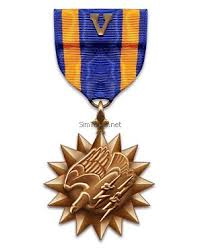 |
The Air
Medal can be awarded for exceptional
performance during a single flight or
for meritorious achievement in aerial
flight. If it awarded for a
combat mission or missions, it is worn
with a "V". During the Vietnam era, in addition to single flight awards, "Strike Flight Air Medals" were awarded based on points accumulated during combat related missions. Aircrew received one point for a combat support mission and two points for a combat mission "over the beach". A Strike Flight Air Medal was awarded for each twenty points achieved. |
 |
The Air
Medal with Combat V ribbon |
May 2th- 1.6, 4 Mk 81s and 150 rnds of 20mm
May 24th- 1.7, 2 Mk 81s and 2 Mk 82s and 150 rnds of 20mm
May 25th- 1.5, 1 Mk 82 and 50 rnds of 20mm. We must have brought bombs back; apparently not much to shoot at or poor weather
May 26th- 1.8, 3 LAU 10 Zuni rocker pods (12 5" rockets)
May 27th- 1.5 non combat flight, all night time, my second night carrier landing of the cruise
May 28th- 1.7, M<y log book say some kind of a strike, no ordnance listed
May 29th- 2.4, I flew an aircrfat to NAS Cubi Ppoint for some reason
May 30th- 2.5, I flew back aboard from Cubi
June 1st- 1.7, non combat proficiency flight, 3 wet plugs (a wet plug is when you use your inflight refueling probe to get fuel from another aircraft)
June 1st- 1.9, another non combat proficien0e flight 3 wet plugs
June 2nd- 1.8, another non combat flight around the boat (Intrepid). Perhaps we had a few days of bad weather.
Note: Navy pilots refer to the carrier as "the boat" rather than the more correct term of "the ship)
June 2nd- 1.8, 2 Mk 81s and 2 Mk 82s. The weather must have improved allowing the afternoon strikes to go
June 3rd-. 1.7, 2 MK 81s and 2 Mk 82s and 150 rnds of 20mm
June 3rd- 1.6, 3 LAU 10s, late afternoon strike with 0.4 night time and third night landing of the cruise
June 4th- 1.6, 2 Mk 82s and 2 MK 81s
June 5th- 1.7, 2 MK 77. The Mk 77 was one of the types of napalm we used usually on Close Air Support (CAS) missions
This was my 20th mission so I was awarded my 2nd Strike Flight Air Medal (40 points)
June
5th- 1.7, 2 MK 82s and 2 Mk 81s
June 6th- 1.8, 2 LAU 10 pods (8 Zuni 5" rockets)
June 6th- 1.7, 2 Mk 83 bombs, The Mk 83 was a 1000 lb bomb. They are carried on the parent racks instead of a Tripple Ejection Rack (TER)
Mk 83s are usually only used on an important target. Unfortunately, I have no indication of what it involved.
June 7th- I did not fly, I probobly had the SDO watch again
June 8th- 1.3, 2 ANM 81s (old "fat" bombs) and 2 MK 81s (new type bombs). They must be short of bombs.0.1 night time 4th night trap (pinky)
A "pinky" night landing is when it is officially after sunset but there is plenty of light. We was probably flew a regular day VFR patterrn
June 9th- 1.8, two more ANM 81s and 2 Mk 81s
June 9th- 1.5, 2 ANM 81s and 2 Mk 81s, 0.2 night time, my 5th night trap (another pinky but flown from a CCA (Carrier Controlled Approach)
June 10th- 1.8, 4 MK 81s
June 11th- 1.7, 4 MK 81s, 150 rnds of 20 mm. 0.4 night time, CCA, 6th night trap
June 12th- 1.8, 4 MK 81s and 100 rnds of 20 mm. This was also my 30th mission
June 12th- 1.7, 4 Mk 81s. I logged my 100th carrier landing (trap) on the Intrepid on this flight.
I was awarded my 3rd Strike Flight Air Medal for this mission (60 points)

June 13th- 2.1, non combat flight, 1 wet plug
June 13th- 1.6, non combat flight, 1 wet plug
June 14th- 1.9, 4 MK 81s. This was my final flight of the first line period
June 6th- 1.8, 2 LAU 10 pods (8 Zuni 5" rockets)
June 6th- 1.7, 2 Mk 83 bombs, The Mk 83 was a 1000 lb bomb. They are carried on the parent racks instead of a Tripple Ejection Rack (TER)
Mk 83s are usually only used on an important target. Unfortunately, I have no indication of what it involved.
June 7th- I did not fly, I probobly had the SDO watch again
June 8th- 1.3, 2 ANM 81s (old "fat" bombs) and 2 MK 81s (new type bombs). They must be short of bombs.0.1 night time 4th night trap (pinky)
A "pinky" night landing is when it is officially after sunset but there is plenty of light. We was probably flew a regular day VFR patterrn
June 9th- 1.8, two more ANM 81s and 2 Mk 81s
June 9th- 1.5, 2 ANM 81s and 2 Mk 81s, 0.2 night time, my 5th night trap (another pinky but flown from a CCA (Carrier Controlled Approach)
June 10th- 1.8, 4 MK 81s
June 11th- 1.7, 4 MK 81s, 150 rnds of 20 mm. 0.4 night time, CCA, 6th night trap
June 12th- 1.8, 4 MK 81s and 100 rnds of 20 mm. This was also my 30th mission
June 12th- 1.7, 4 Mk 81s. I logged my 100th carrier landing (trap) on the Intrepid on this flight.
I was awarded my 3rd Strike Flight Air Medal for this mission (60 points)
June 13th- 2.1, non combat flight, 1 wet plug
June 13th- 1.6, non combat flight, 1 wet plug
June 14th- 1.9, 4 MK 81s. This was my final flight of the first line period
Our First Line Period Ended on June 14th (30 days)
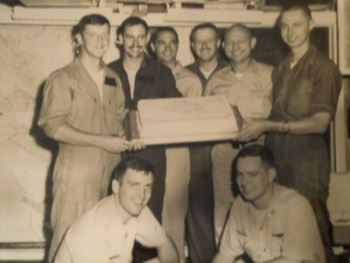 |
I logged my 100th
trap (landing) on Intrepid on
June12th. It is traditional to have a ceremonial cake for each 100 traps. This cake was probably presented in the ready room during the transit from the first line period to Yokosuka. Left to right: P.C. Craig, me, Bob Hamel, John Newman, LCDR Possum Terrell, Lee Cole Bottom Row: Dave Parsons, Dave Thornhill |
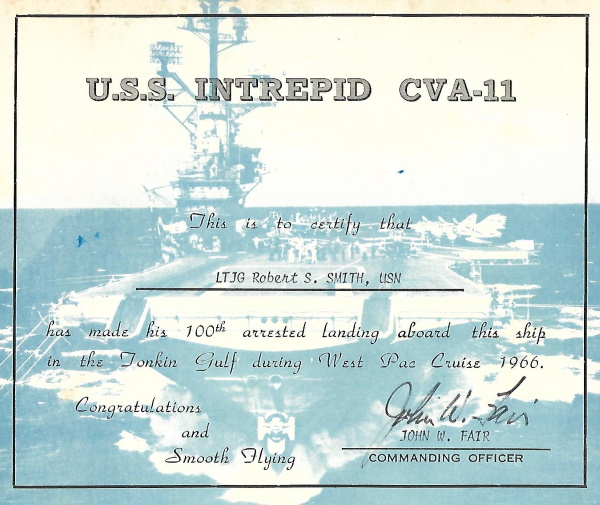
End of the Line Parties
Alcohol
was prohibited onboard navy ships in 1966
except in cases where a flight surgeon
determined that an alcoholoc drink was
appropriate for a pilot after experiencing
a "harowing experience". Flight surgeons
had a supply of small bottlles of whisky
for this purpose. It was detrmined at some
level that flying combat operations
qualified as a "harrowing experience". Or,
at least they ignored the regulation and
allowed "End of the Line Parties" for
squadrons as long they were held in the
squadron's ready room. On Intrepid,
security watches were posted on hangar
bays to ensure the safety of pilots (make
sure one didn't fall overboard) on the
trip from the ready room to the
staterooms.
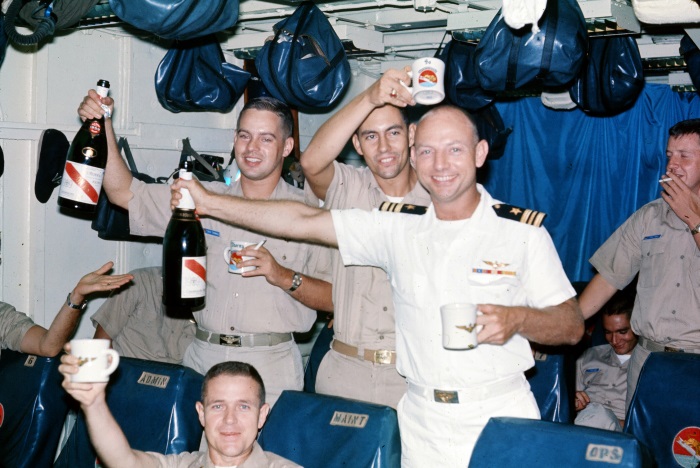 Our first "End of the Line Party" held in our ready room was limited to champagne toasts appropriate for squadrons of Air Wing Ten, The "Champagne" air wing. |
Our First Port Visit: Yokosuka, Japan- about
June 20th to June 30th
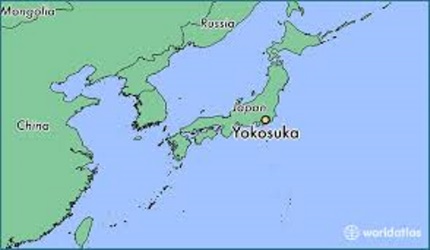 Yokosuka is on the Japanese island of Honshu and is close to Tokyo and Mount Fugi |
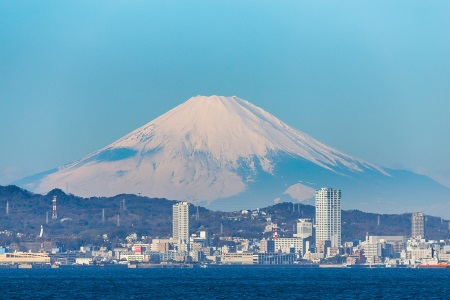 Mount Fugi
(Connie Detrick climbed to the top of Mt. Fuji on July 15th) |
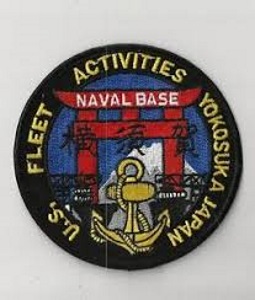 |
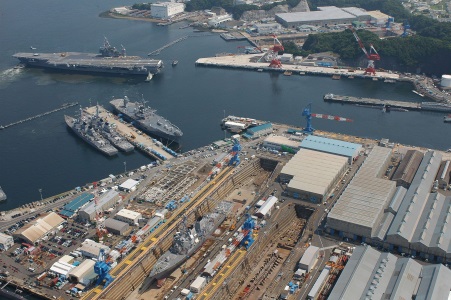 |
While we were in Yokosuka, the wood flight deck forward in the catapult area was replaced with teak wood planks
because the A4 landing gear tore up the old wood during catapult shots.
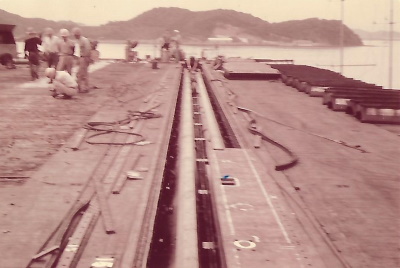 |
The Japanese workers completed the job in one week; incredible. |
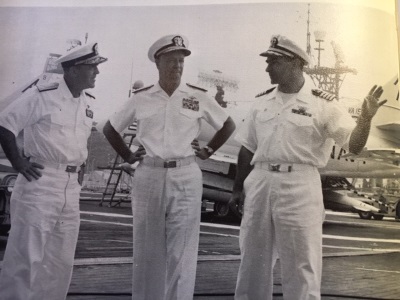 |
Admiral (ADM) Roy Johnson, Commander in Chief of the Pacific Fleet (CICPACFLT) came to town from Hawaii, and Vice Admiral (VADM) John Hyland, Commander of the Seventh Fleet (COMSEVENTHFLT) (homeported in Ypkosuka) with Captain Macri onboard Intrepid in Yokosuka on June 25th. They most likely discussed the progress of the flight deck repairs as well as Dixie Station operations. |
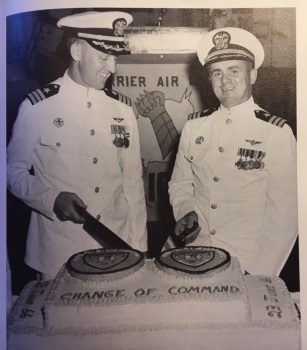 |
Cag Hayward was relieved by Cdr Burrows on June 23rd in Yokosuka. |
CAG Hayward would go on after commanding the Champagne Air Wing to be as
the Commander of the 7th Fleet from 1975 to 1976 and CINCPACFLT from 1977 to 1978.
His next assignment would be as the Chief of Naval Operations from 1978 to !982.
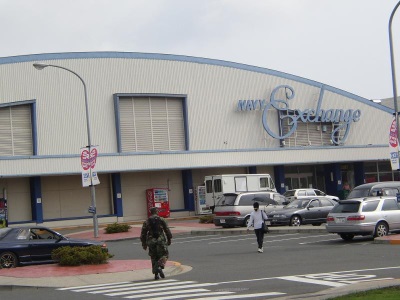 One of the first
places nearly everyone visited was
the Navy Exchange where we
purchased reelto reel tape
players, turn tables, speakers,
Seiko watches and cameras.
|
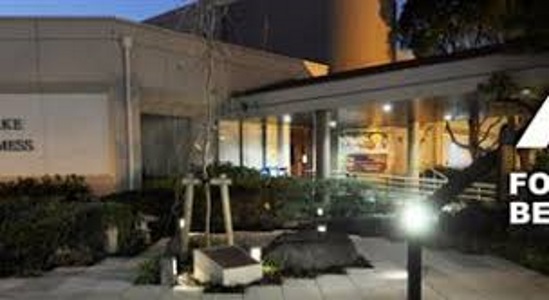 The Officer's Club
was also popular of course.
CAG Hayward hosted a champagne reception here after he was relieved by Commander Burrows as the new CAG 10. So, Dave Thornhill, VA-15's dsignated CAG wingman had a new leader for the next line period. |
Our First USO Show- June 23rd
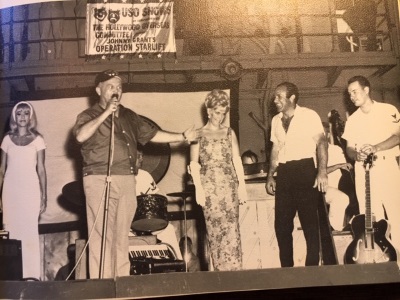 |
Johnny Grant's
Operation Starlift
|
Out in Town
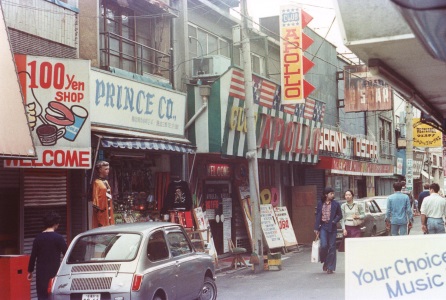 |
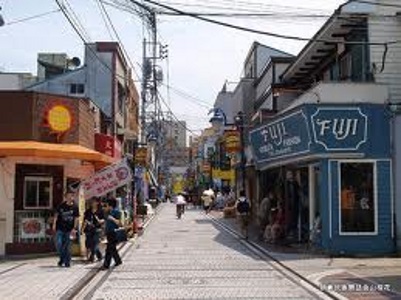 |
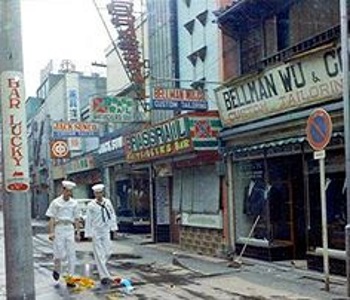 |
These are typical views of downtown Yokosuka. The most popular places we visited were restaurants and bars. Some of the VALions visited a place called the Candy Club. One of my favorites was the New Dream Japan Bar which was on a street similar to the one on the left.
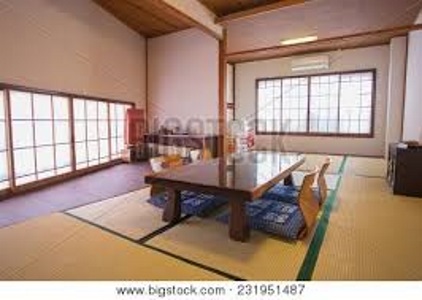 |
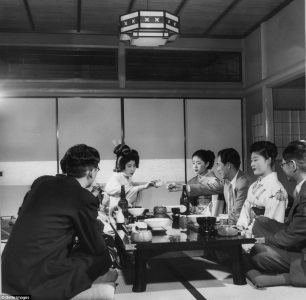 |
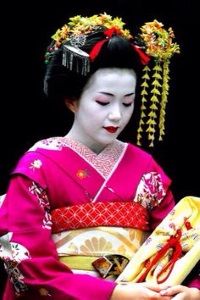 |
We had
a squadron wardroom (officers) dinner
party in downtown Yokosuka at one of the
local restaurants. The room was similar to
the image on the left; low table and
tatami mats around a large rectangular
table. The walls featured rice paper and
wood sliding doors for not only entering
and leaving but also for the serving the
food which was typical japanese such a
tempura, rice, and beer. I think there
were a couple of rounds of saki in there
somewhere. Our servers were dressed in
traditional Geisha dress. They served our
food, poured our drinks and even
entertained us with traditional japanese
music during dinner. There were about four
or five servers for our group of about
twenty. Toward the end of the party,
(after we few drinks) we played strip
'rock paper scissors' with our Geisha
servers. The Geisha traditional dress (on
the right) consists of many layers. It
wasn't long before the Geishas' look
hadn't changed much but we were all
sitting g there in our "skivies". It was a
great time; nothing improper!
Dixie Station- Our Second
Line Period- July 4th - August 8th, 1966
We had two significant Events right at the start of our Second Line Period:
Secretary of the Navy
Paul H. Nitze came onboard July 14th.
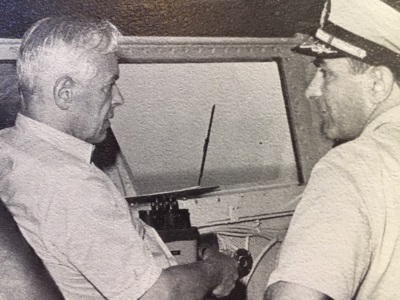 SECNAV
with
Capt. Macri on the bridge
|
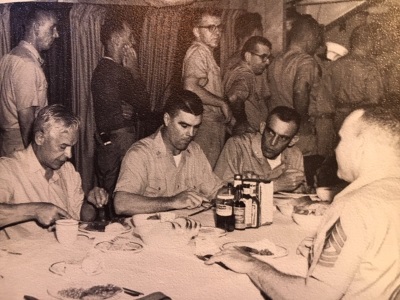 SECNAV
having
dinner in the CPO Mess
|
Captain John Fair
relieved Captain Macri as the Commanding
Officer of the Intrepid on July 15th.
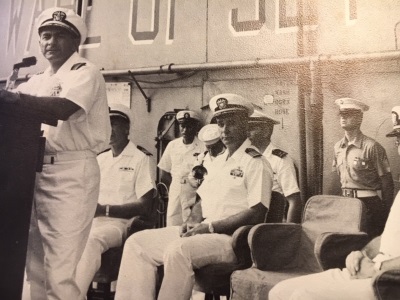 Ding
Ding Ding Ding; Intrepid
Departing
|
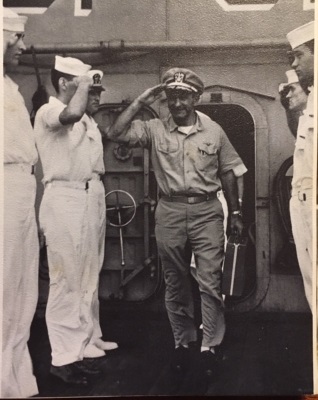 |
Our
Second USO Show- July 17th
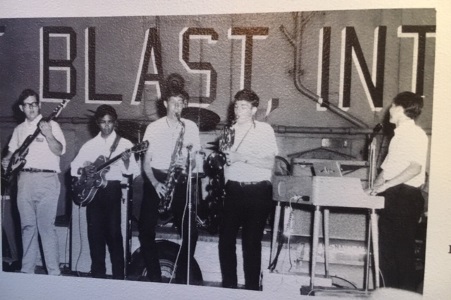 |
Louis and the Seven Days (night on the flight deck) |
Our
Third USO Show- July 24th
Our Fourth USO Show- July 27th
An Entertainment Group from South Vietnam
(performed at night on the flight deck)
Our Fifth USO Show- August 1st
Our Sixth USO Show- August 6st
All of these USO events occurred at night after flight opperations including the Entertainment Group from South Vietnam.
The picture appears to have been taken in the daytime. But, I flew two combat missions that day so the performance had to be after flight
operations probably about 1930 (7:30pm) or so!
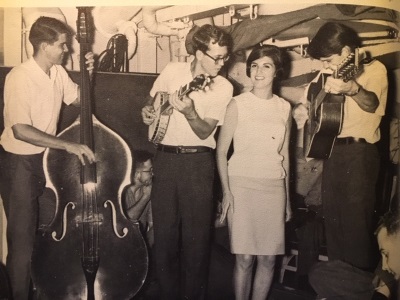 |
The Four of Us
(on the crew's mess decks) |
Our Fourth USO Show- July 27th
An Entertainment Group from South Vietnam
(performed at night on the flight deck)
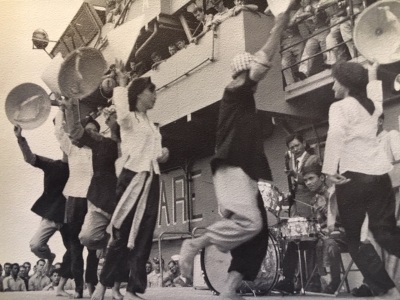 |
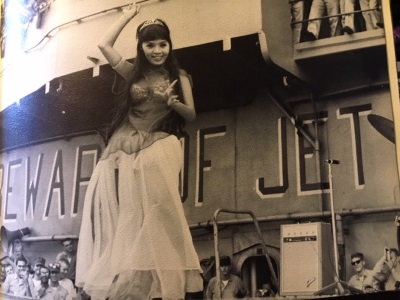 |
Our Fifth USO Show- August 1st
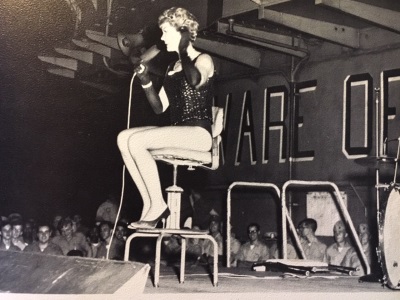 |
Stateside Capers
(at night on the flight deck) |
Our Sixth USO Show- August 6st
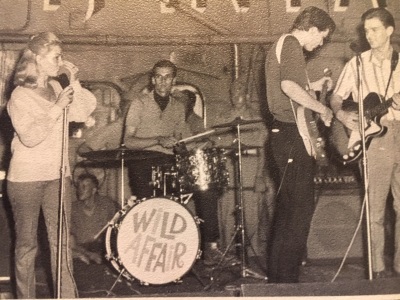 |
Wild Affair (at night on the flight deck) |
All of these USO events occurred at night after flight opperations including the Entertainment Group from South Vietnam.
The picture appears to have been taken in the daytime. But, I flew two combat missions that day so the performance had to be after flight
operations probably about 1930 (7:30pm) or so!
Back to Business
I
flew 40 combat
missions and 5 tanker flights.
At the end of the line period, I had 72 combat missions and 7 strike/flight air medals.
At the end of the line period, I had 72 combat missions and 7 strike/flight air medals.
 |
At
the beginning of the line period, we
resumed missions in the Mekong Delta
and in III Corps. Our mission load was normally six MK 81 250# bombs or four MK 82 500# bombs or a mixture of Mk 81s and 82s. But, we did carry four Lau 3 pods (4 runs with 19 rockets each run), and MK 77 napalm on some missions. I carried 2 MK 83 (1000# bombs) on four missions. I also carried six Mk 81 snakeyes on one mission. Snakeye bombs are designed for low altitude low angle delivery most likely in a close air support situation. We mostly flew Direct Air Support missions to the northwest of Saigon in an area called "Zone D". This area used to be Michelin Rubber Company property and was a prime area for VC base camps. It was likely that we had more Close Air Support missions in the eastern part of III Corps from Long Bin toward the coast as that was here the US Army was primarily operating. Vong Tau is where the US Army had their famous R&R beach facility complete with surfing. |
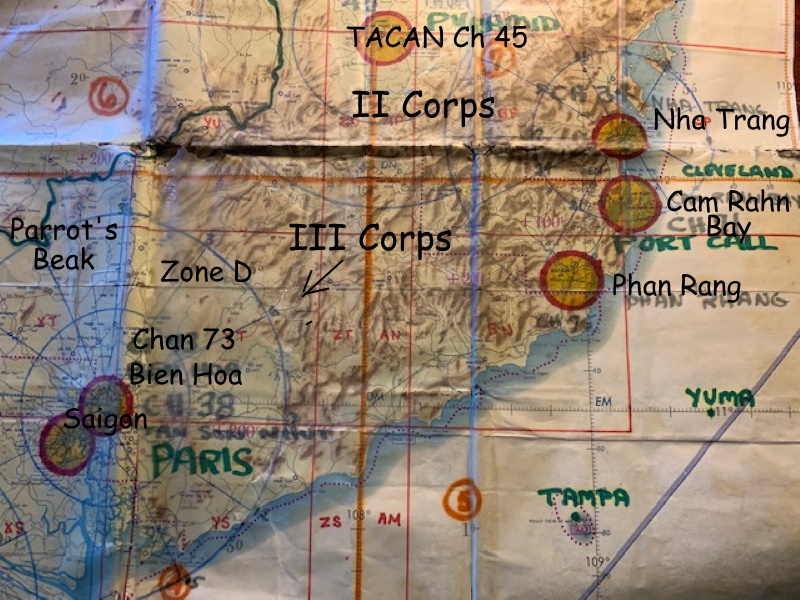
Every once in awhile after the last aircraft has landed in a recovery, the Air Boss will call out to the flight deck crew to "Rig the barricade". The crew responds in a clockwork like performance to see if they can rig it properly in a faster time than during the last drill. After the barricade is rigged, the Air Boss will make a call like "Great job, bravo zulu 1 minute and 57 seconds". Or perhaps, "Airman Jones, what were you thinking of when you ....."
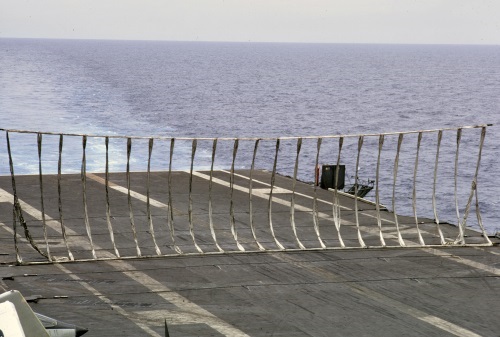 |
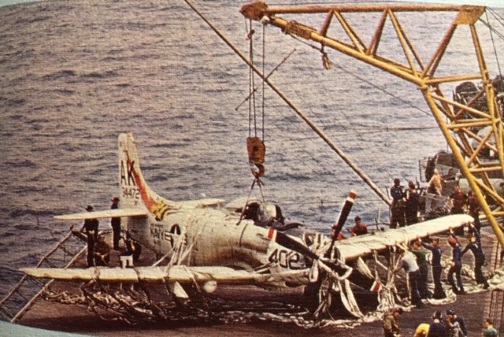 |
However, occasionally, it is not a drill. One day, LCDR Leo Cook (the Maintenance Officer of VA-176 402 could not not lower his main landing gear. If he had been able to get only one main landing gear down, the Air Boss would have directed him to ditch eject alongside of the ship because it was too dangerous to try to make a trap or to use the barricade. But, in this case, with no gear at all, it was safe to use the barricade. When using the barricade, the pilot made a normal carrier approach only instead of getting a wire, the aircraft is brought to a stop with the barricade. The only difference is that you cannot wave off in close because being snagged by the top of the barricade could be disastrous.
I would like to thank Dave Vanhoven from VA-176 for these pictures of Lcdr Cook's barricade arrestment.
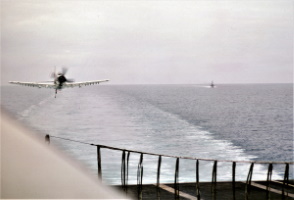 |
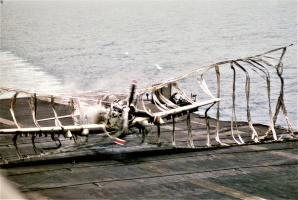 |
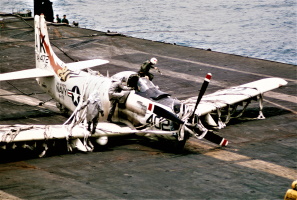 |
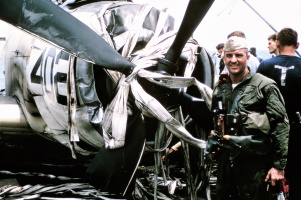 |
But as the line period progressed, we moved north flying missions in I Corps and II Corps
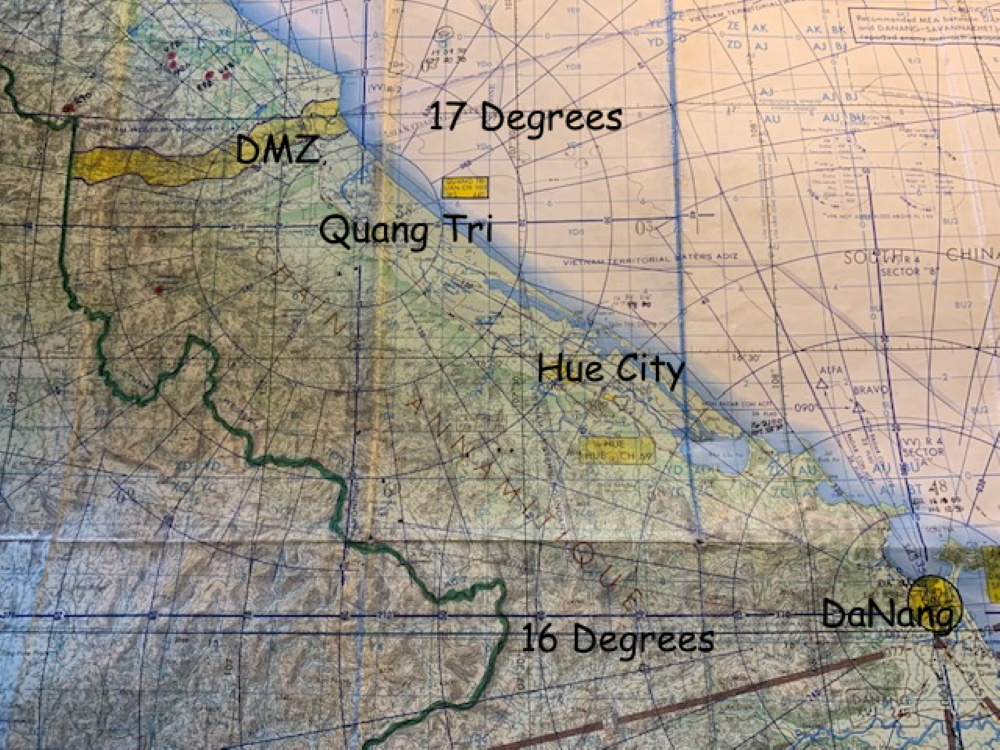 |
This map shows the infiltration supply routes into South Vietnam from North Vietnam via the Ho Chi Minh Trail (in red) and from Cambodia (in Green). Notice the concentration of these infiltration routes from just north of the DMZ and into I Corps west of Da Nang and in to II Corps north and west of Pleiku. As North Vietnam was increasing it's troop strength in South Vietnam and logistics support along the Ho Chi Minh Trail, President Johnson decided to prosecute the war in Vietnam more aggressively which resulted in increases in US troops. As US Army and Marine Corps troops were increased in the northern portion of South Vietnam. |
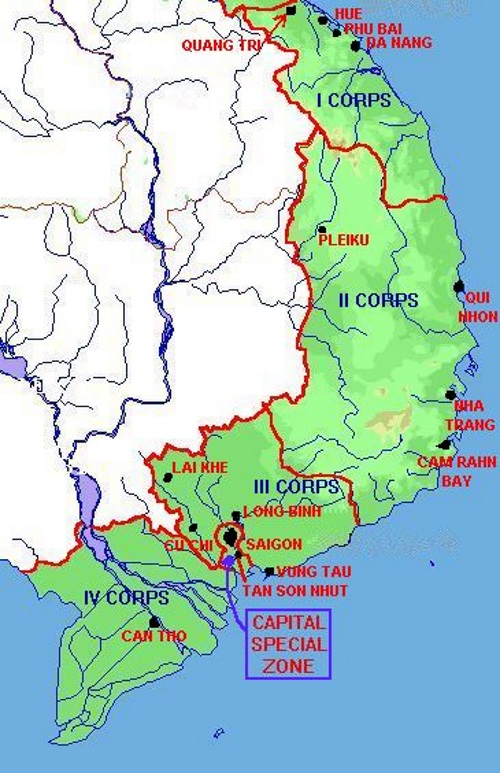 |
As the North Vietnamese Army (NVN) threat increased, Dixie Station moved north. We flew missions in I Corps in support of US Army and Marines who were in contact with North Vietnamese forces. (around Da Nang, Hue, and Quang Tri). These were exciting missions. Each mission resulted in a feeling that we were making a difference, saving US Army and Marine Corps lives in battles with the North Vietnamese. We also flew some missions in II Corps in support of the US Army especially in the northern area around Pleiku. The Air Force and Army flew most of the missions in the southern portion of II Corps. However, these missions brought with them higher threat from the NVN ground forces. The had infrared surface to air missiles and improved tactics. Logistics aircraft flying into Da Nang had to use steep approach paths to limit their exposure to these weapons. They had more heavy machine guns that they could direct at aircraft attacking their positions. And, they were not only better at setting up ground ambushes than the VC, but they also set up ambushes for aircraft. Helos approaching the position of downed pilots were shot down while attempting rescues. |
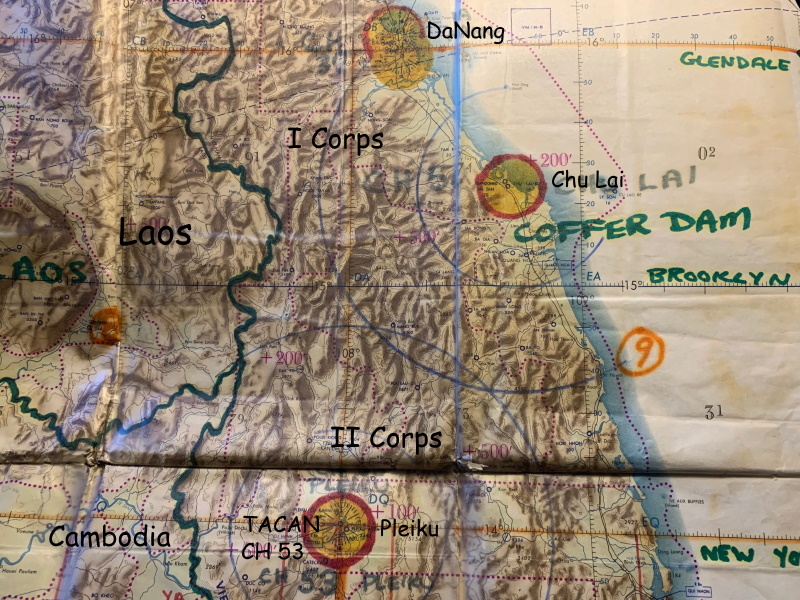 |
Donnie McCLoughlin Story
One
particularly
personal event
involved a friend I
had met in flight
training. Don
McCloughlin was a
Naval Academy
graduate Class of
'63. He was an
All American center
mid fielder for the
Annapolis Lacrosse
team. My
roommate in my
fraternity at
Cornell, Dick Gibson
was also an All
American mid fielder
on the Big Red
Lacrosse team.
Donnie was an A4 pilot from another carrier who was shot down on a mission near Da Nang. He was killed during the ejection or during his capture by VC or NVN forces. They positioned his body a clear area where it could be discovered by aircraft looking for him after he was shot down. When the helo arrived supported by A1 Spad Rescap aircraft, the VC/NVN opened up with machine guns downing the helo and hitting a Spad or two.
This changed the ground rules for me. One, I would kill NVN/VC forces whenever given the opportunity. And two, I knew we had to be very careful in Rescap situations because we knew the VC/NVN were looking to bag more helos and Rescap aircraft.
A practice Lacrosse fied atg the Naval Academy is now names after Donnie.
Lance Corporal Randy Finn Story
Another
story that occurred
during this time
involved a Close Air
support mission in
was on to support
Marines in contact
at the Khe Sanh base
west of Da Nang. The
NVN were trying to
isolate the base and
then over run it.
The Marine C-130
logistics aircraft
were getting the job
done but were taking
a lot of casualties.
The NVN would probe
the base defenses
and then pull
back. There
were constant
intense fire
fights. Our
mission took place
during one of these
fire fights. We took
a lot of fire from
the NVN
forces. But,
we delivered
effective support
for the
Marines. It
was an exciting
mission>
A couple of years later when I was on Air Force Exchange orders as an F-105 instructor pilot, I had a visit from my cousin, Randy Finn, an ex-Marine During a discussion about his time in Vietnam, we discovered that Randy was a 105 machine gunner at Khe Sanh on the date of that mission.
My flight log entries for July and Early August (through August 4th)
Donnie was an A4 pilot from another carrier who was shot down on a mission near Da Nang. He was killed during the ejection or during his capture by VC or NVN forces. They positioned his body a clear area where it could be discovered by aircraft looking for him after he was shot down. When the helo arrived supported by A1 Spad Rescap aircraft, the VC/NVN opened up with machine guns downing the helo and hitting a Spad or two.
This changed the ground rules for me. One, I would kill NVN/VC forces whenever given the opportunity. And two, I knew we had to be very careful in Rescap situations because we knew the VC/NVN were looking to bag more helos and Rescap aircraft.
A practice Lacrosse fied atg the Naval Academy is now names after Donnie.
Lance Corporal Randy Finn Story
A couple of years later when I was on Air Force Exchange orders as an F-105 instructor pilot, I had a visit from my cousin, Randy Finn, an ex-Marine During a discussion about his time in Vietnam, we discovered that Randy was a 105 machine gunner at Khe Sanh on the date of that mission.
My flight log entries for July and Early August (through August 4th)
July 4th- 2.0, non combat flight around Intrepid
July 6th- 1.8, another non combat flight
July 8th- 1.8, 2 MK 83 (1,000 lb bombs)
July 8th- 1.5, 2 ANM 81 "fat bombs" and 2 Mk 82s, 0.3 night time, 8th night trap
July 9th- 2.2,3 LAU 3 rocket pods. 0.1 actual inst time, 1 CCA. I suspect there was bad weather at the ship on return
July 9th- 1.8, 4 ANM 81 fat bombs
July 10th- 2.1. non combat flight around Intrepid
July 10th- 1.9, a second non combat flight around the ship, 1 wet plug
July 11th- 1.7, 2 MK 77 napalm
July 12th- 1.9, 3 MK 81s, 0.5 actual inst time, 1 CCA, bad weather at the ship on return
July 13th- 1.7, 2 MK 83 1000 lb bombs
July 14th- 1.7, 4 MK 81s, This was my 40th combat mission
July 15th- 1.9, 4 MK 81s, 1 wet plug.
I was awarded my 4th Strike Flight Air Medal (80 points)
July
16th- I did not
fly July 16th.
SDO watch?
July 17th- 1.3, no weapons logged, 0.1 night time, 9th night trap (pinkie)
July 18th- 1.8, no weapons logged, 1.1 actual instrument time. Probably landed with 4 MK 81s due to bad weather at the target and ship.
July 19th- 1.8, 2 Mk 81s and 2 Mk 82s
July 20th- 1.7, 2 MK 77 napalm
July 20th- 1.8, no weapons load logged
July 21st- 1.7, 2 MK 81s and 2 Mk 82s
July 21st- 1.8, 6 MK 81 Snakeyes
July 22nd- 1.7, non combat flight around the ship, 1 wet plug
July 22nd- 1.8, another non combat flight around the ship, 2 wet plugs
July 23rd- 1.6, 4 MK 81s, 0.5 night time, 1 CCA, 10th night trap (not a pinkie)
July 24th- 1.7, 4 MK 81s, 50th combat mission
July 25th- 1.7, 6 Mk 81s
July 26th- 1.7, 4 LAU 3 2.75" rocket pods (19 rockets per pod)
I was awarded my 5th Strike Flight Air Medal for this flight (100 points)

July 26th- 1.7, 3 MK 82s, 0.8 actual instrument time, 0.5 night time, bad weather 11th night trap
July 27th- 1.7, 3 MK 83s, 0.5 actual instrument time, 0.6 night time, more bad weather, 12th night trap
July 27th- 1.7, 4 MK 82s, 0.4 hours of actual instrument time
It is so hot and humid in the Gulf of Tonkin in July that the Captain tried to stay close to thunderstorms so that he could duck in to them betweeen the recovery of aircraft and the next launch while the flight deck was being prepared for the next launch. This was refreshing for the flight deck guys and kept the ship a little cooler. Sometimes, he didn't get clear of the clouds soon enough resulting in the launch and recovery being in instrument conditions.
July 28th- I did not fly on the 28th. SDO?
July 29th- 1.8, 2 MK 83s, 0.2 hours of actual instruments, 1 CCA, bdf weather during the recovery
July 29th- 1.6, 2 MK 77 napalm, 0.5 actual instruments, 0.5 night time, 12th night trap
July 30th- 1.7, 4 MK 82s, 0.1 actual instruments, 1 CCA, more thunderstorms in the Gulf of Tonkin for the recovery
July 30th- 1.7, 4 LAU 3 2.75 rocket pods (19 rockets per pod)
July 31st- 1.8, 6 MK 81s. This was my 60th combat mission.
A few of the missions are only 1 point missions so the Strike Flight points do not line up with the number of missions.
July 31st- 1.8, 4 MK 82s.
August 1st- 1.6, 2 Mk 81s and 2 MK 82s.
I was awarded my 6th Strike Flight Air Medal as of this flight because I had accumulated 120 points (62nd combat mission).

August
1st- 1.7, non
combat flight
August 2nd- 1.8, 3 MK 81s, 0.3 hours of actual instruments
Sometimes poor weather overland or the lack of a suitable target resulted in our bringing back a partial load of bombs
August 2nd- 1.7, 2 MK 81s
August 3rd- 1.7, 4 MK 81s
August 4th- 1.7, 4 MK 81s
August 4th- 1.7, 2 Mk 77 napalm
July 17th- 1.3, no weapons logged, 0.1 night time, 9th night trap (pinkie)
July 18th- 1.8, no weapons logged, 1.1 actual instrument time. Probably landed with 4 MK 81s due to bad weather at the target and ship.
July 19th- 1.8, 2 Mk 81s and 2 Mk 82s
July 20th- 1.7, 2 MK 77 napalm
July 20th- 1.8, no weapons load logged
July 21st- 1.7, 2 MK 81s and 2 Mk 82s
July 21st- 1.8, 6 MK 81 Snakeyes
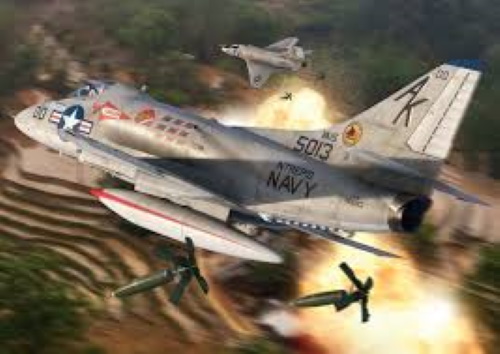 |
| Snakeyes
are any MK 80
series bombs
(81s, 82, or
83s) that have
tail fins that
open up on
release. They
are an
excellent
weapon for
Close Air
Support as
pictured here |
July 22nd- 1.7, non combat flight around the ship, 1 wet plug
July 22nd- 1.8, another non combat flight around the ship, 2 wet plugs
July 23rd- 1.6, 4 MK 81s, 0.5 night time, 1 CCA, 10th night trap (not a pinkie)
July 24th- 1.7, 4 MK 81s, 50th combat mission
July 25th- 1.7, 6 Mk 81s
July 26th- 1.7, 4 LAU 3 2.75" rocket pods (19 rockets per pod)
I was awarded my 5th Strike Flight Air Medal for this flight (100 points)
July 26th- 1.7, 3 MK 82s, 0.8 actual instrument time, 0.5 night time, bad weather 11th night trap
July 27th- 1.7, 3 MK 83s, 0.5 actual instrument time, 0.6 night time, more bad weather, 12th night trap
July 27th- 1.7, 4 MK 82s, 0.4 hours of actual instrument time
It is so hot and humid in the Gulf of Tonkin in July that the Captain tried to stay close to thunderstorms so that he could duck in to them betweeen the recovery of aircraft and the next launch while the flight deck was being prepared for the next launch. This was refreshing for the flight deck guys and kept the ship a little cooler. Sometimes, he didn't get clear of the clouds soon enough resulting in the launch and recovery being in instrument conditions.
July 28th- I did not fly on the 28th. SDO?
July 29th- 1.8, 2 MK 83s, 0.2 hours of actual instruments, 1 CCA, bdf weather during the recovery
July 29th- 1.6, 2 MK 77 napalm, 0.5 actual instruments, 0.5 night time, 12th night trap
July 30th- 1.7, 4 MK 82s, 0.1 actual instruments, 1 CCA, more thunderstorms in the Gulf of Tonkin for the recovery
July 30th- 1.7, 4 LAU 3 2.75 rocket pods (19 rockets per pod)
July 31st- 1.8, 6 MK 81s. This was my 60th combat mission.
A few of the missions are only 1 point missions so the Strike Flight points do not line up with the number of missions.
July 31st- 1.8, 4 MK 82s.
August 1st- 1.6, 2 Mk 81s and 2 MK 82s.
I was awarded my 6th Strike Flight Air Medal as of this flight because I had accumulated 120 points (62nd combat mission).
August 2nd- 1.8, 3 MK 81s, 0.3 hours of actual instruments
Sometimes poor weather overland or the lack of a suitable target resulted in our bringing back a partial load of bombs
August 2nd- 1.7, 2 MK 81s
August 3rd- 1.7, 4 MK 81s
August 4th- 1.7, 4 MK 81s
August 4th- 1.7, 2 Mk 77 napalm
August
4th was our last Day
on Dixie Station
Things changed big time August 5th. During the night of August 4th, the Intrepid moved north and we began flying Rolling Thunder missions from Yankee Station!
A decision had
been made in Washington that we
needed more sorties in North Vietnam
from Yankee Station. The Air Force
and Army had increased the number of
aircraft in South Vietnam. So, the
decision was made that the Intrepid
would move to Yankee Station and
Participate in Operation Rolling
Thunder.
Rolling Thunder was the name for Air Force and Navy air operations over North Vietnam from 1965 through early 1968. The strategic plan (or lack of it) came from a weekly lunch on Tuesday of each week which were attended by President Johnson, his Secretary of Defense, Robert MacNamara, and various aids and staffers. No military officers from the Department of Defense or Joint Chiefs of Staff were permitted to attend these meetings. The types of targets, and Rules of Engagement were determined at these meetings. Major specific targets were put on a list. These targets became known as Alpha list targets or eventually Alpha Strikes. Johnson and MacNamara were very concerned that the Russians or Chinese would enter the war if we went too far. So they established a 30 mile no fly zone along the Chinese border, no bomb (safe) zones around Hanoi and Haiphong and prohibited hitting any Russian or Chinese ships in port even if they were unloading war supplies. They didn't allow bombing of airfield or SAM sites under construction because of the chance that Russian or Chinese advisors might be there. Some of these restrictions proved to be very dangerous for USAF and Navy aircraft.
1. USAF F-105 pilots flying from northwest of Hanoi along Thud Ridge could be attacked by MIGs which could find a safe haven just a few miles to the north in the 30 Chinese border buffer zone.
2. MIG airfields such as Kep and Phuc Yen near Hanoi could not be attacked for fear of Russian advisor casualties who were training the North Vietnamese pilots. F4 Phantoms and F-05 Thud pilots often flew over these airfields with MIGs on the ground. But, they could not attack the base or aircraft on the ground. The MIGs were fair game only when they were off the ground.
3. SAM sites under construction could not be attacked because of the fear that Russian advisors who were there monitoring the construction and training the North Vietnamese missile crews might be killed if the sites were attacked. USAF and Navy pilots often flew over these sites as they were being completed and observed SA 2 Guideline missiles at the sites but could not attack them.
Some of these pilots were shot down by the sites they could have eliminated if they had been authorized to attack these sites. Apparently, Russian and Chinese lives were more important than American pilot lives in the minds of President Johnson and Robert MacNamara.
Non military targets; schools, churches, hospitals, and dikes dividing rice paddies were off limits. Pilots had to adjust their dive bomb direction so that no school, church, or hospital was long or short of the target. Of course the North Vietnamese became aware of these limitations, so positioned AAA and SAM sites close to hospitals, churches, and schools.
Rolling Thunder was the name for Air Force and Navy air operations over North Vietnam from 1965 through early 1968. The strategic plan (or lack of it) came from a weekly lunch on Tuesday of each week which were attended by President Johnson, his Secretary of Defense, Robert MacNamara, and various aids and staffers. No military officers from the Department of Defense or Joint Chiefs of Staff were permitted to attend these meetings. The types of targets, and Rules of Engagement were determined at these meetings. Major specific targets were put on a list. These targets became known as Alpha list targets or eventually Alpha Strikes. Johnson and MacNamara were very concerned that the Russians or Chinese would enter the war if we went too far. So they established a 30 mile no fly zone along the Chinese border, no bomb (safe) zones around Hanoi and Haiphong and prohibited hitting any Russian or Chinese ships in port even if they were unloading war supplies. They didn't allow bombing of airfield or SAM sites under construction because of the chance that Russian or Chinese advisors might be there. Some of these restrictions proved to be very dangerous for USAF and Navy aircraft.
1. USAF F-105 pilots flying from northwest of Hanoi along Thud Ridge could be attacked by MIGs which could find a safe haven just a few miles to the north in the 30 Chinese border buffer zone.
2. MIG airfields such as Kep and Phuc Yen near Hanoi could not be attacked for fear of Russian advisor casualties who were training the North Vietnamese pilots. F4 Phantoms and F-05 Thud pilots often flew over these airfields with MIGs on the ground. But, they could not attack the base or aircraft on the ground. The MIGs were fair game only when they were off the ground.
3. SAM sites under construction could not be attacked because of the fear that Russian advisors who were there monitoring the construction and training the North Vietnamese missile crews might be killed if the sites were attacked. USAF and Navy pilots often flew over these sites as they were being completed and observed SA 2 Guideline missiles at the sites but could not attack them.
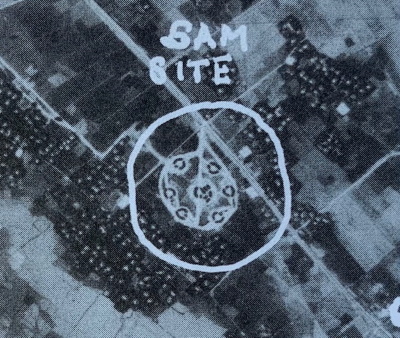 SAM
site under construction
|
Some of these pilots were shot down by the sites they could have eliminated if they had been authorized to attack these sites. Apparently, Russian and Chinese lives were more important than American pilot lives in the minds of President Johnson and Robert MacNamara.
Non military targets; schools, churches, hospitals, and dikes dividing rice paddies were off limits. Pilots had to adjust their dive bomb direction so that no school, church, or hospital was long or short of the target. Of course the North Vietnamese became aware of these limitations, so positioned AAA and SAM sites close to hospitals, churches, and schools.
We
joined the fray during Rolling
Thunder 51 (July 9th to November
11th). Road reconnaissance
missions were permitted everywhere
in the North except in the Hanoi
and Haiphong safe zones. The
primary targets were trucks on the
roads, small bridges, and boats on
the rivers. Again, if you spotted
a SAM site under construction, you
were expected to report it but not
attack it. Major railroad and
highway bridges were limited to
the ones on the Alpha list. Major
industrial targets in the
northeastern portion of North
Vietnam, and specific POL
(Petroleum Storage Facilities)
were added to the Alpha list just
prior to our arrival.
Our A4B's were not equipped to fly in the high threat AAA, SAM, and MIG environment of North Vietnam. The A4B primary flight indicator (ADI) was the old black over black type which made bombing at night ineffective. We had no electronic equipment to detect the search and fire control radars associated with some 57 mm and all 85 mm AAA guns or SA-2 Surface to Air Missile batteries. We had only the capability to detect when an SA-2 SAM was airborne and we were the target. We had no fighter aircraft, electronic warfare support aircraft, or airborne early warning and control aircraft in our airwing. So, we had to rely on these support services from other carriers or were relegated to targets close to the coast.
Yankee Station
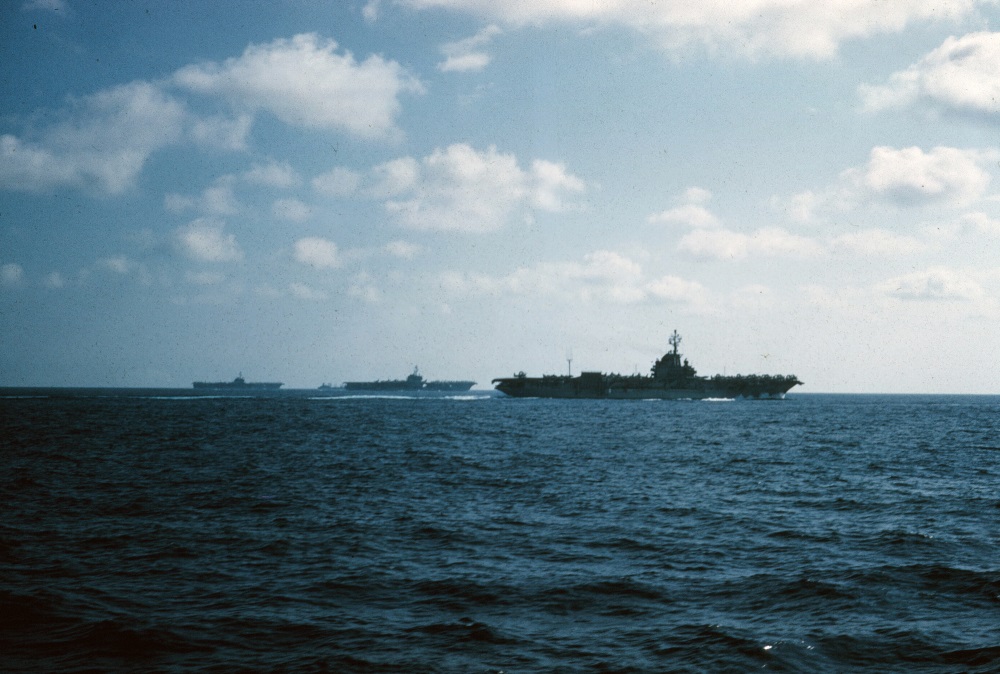 |
| Yankee Station normally consisted of three aircraft carriers, a cruiser which was the air defense control ship (PIRAZ) for the Tonkin Gulf and various other destroyers and frigates (AKA "small boys"). |
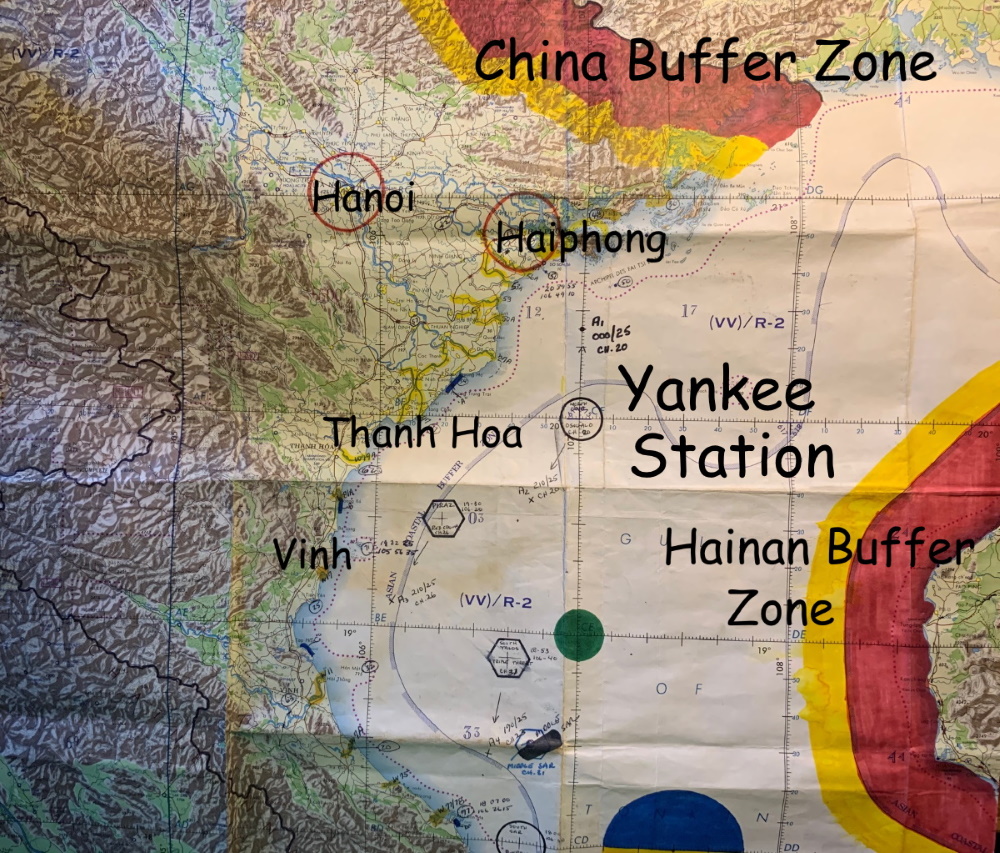 |
| Combat chart of North
Vietnam showing the no fly zones
including the no fly circles
around Hanoi and Haiphong. |
Operation Rolling Thunder
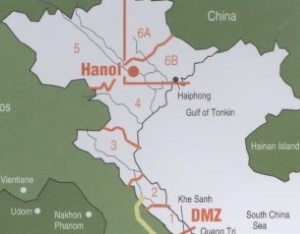 |
This map shows the Rolling
Thunder Route Packages assigned
to the Navy and Air Force during
Operation Rolling Thunder. The Air Force was responsible for bombing operations in Route Package 1 in the southern portion of North Vietnam and Route Packages 5 (west of Hanoi) and Route Package 6A north of Hanoi to the Chinese border. The Air Force flew F- 105 and F-4D aircraft from Thailand for these missions. The Navy was responsible for Route Packages 2,3, 4, 5, and 6B. The aircraft carriers from Yankee Station flew these missions. Hanoi missions were flown by both Air Force and Navy aircraft in large coordinated strikes. |
We arrived on Yankee Station during Rolling Thunder 51. The two primary major target categories during this time were the entire POL (oil) system and and major industries. Road reconnaissance flights were authorized all over North Vietnam except in the restricted zones around Haiphong and Hanoi.
There were only two "Cardinal Rules" involved with flying in the high threat AAA environment of North Vietnam in 1966.
1. Never fly below 3,500' AGL!- Below that, you can be hit by the massive amount of small arms fire up to 50 cal (14.5 mm).
That being said, many air wing anti SAM tactics in 1966 involved avoiding the SAM by getting below 3.000' thought to be the lowest altitude that a SAM could be effective. Result; They didn't get hit by a SAM but they were hit by low caliber AAA, a much bigger threat than the SAMs!
2. Never make a second attack run on the same target!- If they didn't get you on the first run, they probably will on the second!
But due to our restricted deck load (no fighters) inexperience up north, we flew all our missions in August were road reconnaissance (road Recce) missions in Route Package 2 south of Vinh.
I flew four combat missions and one combat support mission (Tanker) from August 5th through August 8th.
It turned out to be a nice warm up for the next line period which would be mostly missions over North Vietnam.
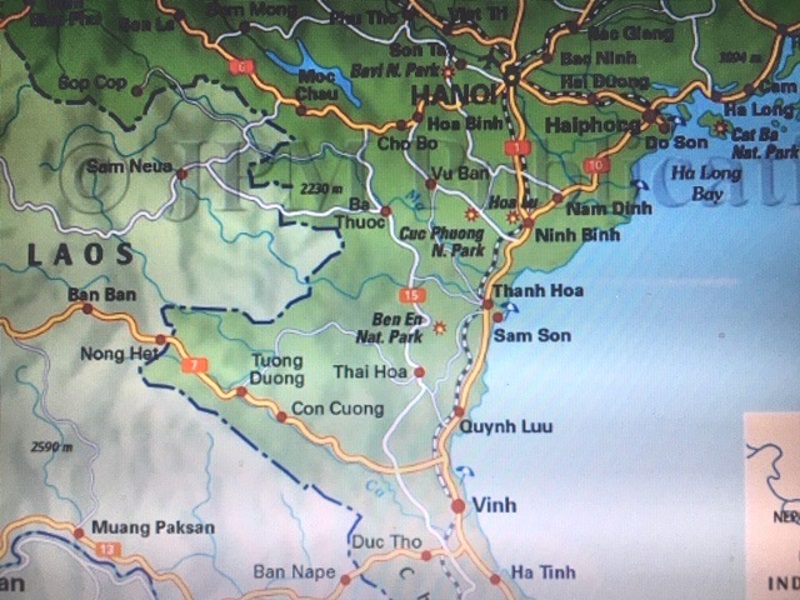 |
| We were only on Yankee
Station for a few days in
August. |
Note: I
discovered during the
research process of writing
this journal that you could
differentiate missions in
South Vietnam from missions
over South Vietnam by the
flight code entered in the
log book. South
missions used the code
1S12. North missions
used the code T12.
Combat support missions
(Tankers- 1 point for Strike
Flight Air Medals) used the
Code 1M1.
August 5th- 1.6, 6 MK 81s
August 6th- 1.9, combat tanker mission (1 point), 3 dry plugs (check out the off going tanker)
August 7th- 1.7, 5 MK 81s. 70 combat missions
August 8th- 1.7, 3 Mk 82s
August 8th- 1,6- 3 MK 82s
We
Lost One Pilot On the First
Deployment: (It was a non-combat
loss)August 5th- 1.6, 6 MK 81s
August 6th- 1.9, combat tanker mission (1 point), 3 dry plugs (check out the off going tanker)
August 7th- 1.7, 5 MK 81s. 70 combat missions
August 8th- 1.7, 3 Mk 82s
August 8th- 1,6- 3 MK 82s
LCDR Moose Moran was a Spad pilot prior to flying with us. He did his jet transition in VA-44 and then came to the squadron. On August 7th, 1966 he lost control of his aircraft during his approach turn about halfway from the 180 position to rolling on final. The aircraft is closest to a stall during that turn. He crashed behind the ship in the wake. Neither he or any part of the aircraft were recovered.
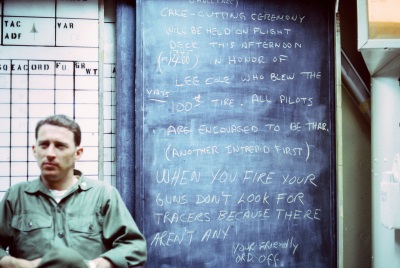 |
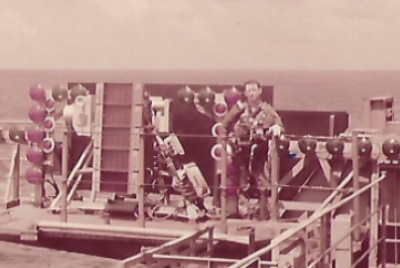 |
LCDR Moose Moran- RIP
May you have fair winds and following seas!
Life
on Dixie Station was quite a bit
different than it became on Yankee
Station. We normally flew two missions a
day. The DAS and CAS missions were fun
to fly and there wasn't much of a threat
to be shot down We flew daylight only.
Flight deck operations usually were over
before sunset. So, we junior
officers could meet on the flight deck
after the 1700 junior officer sitting in
the Second Deck Officers Mess and then
go to the ready room for ytherevening
movie when the "heavies" finished their
sitting in the officer's mess.
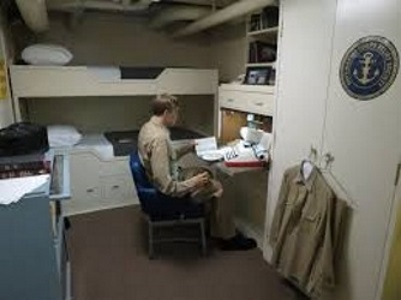 The CO and XO lived in single
staterooms. LCDRs usually lived
in a two man stateroom. Lts and
the more senior LTjgs usually
lived in a four man stateroom.
The more junior JOs lived
in the JO Bunkroom (8 officers).
|
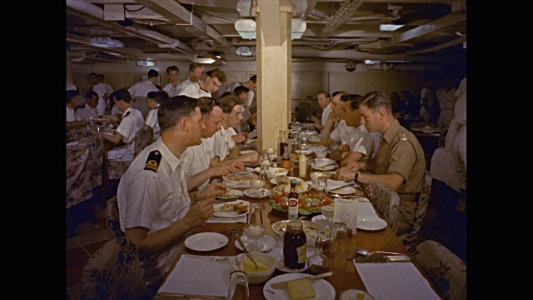 The day started early as the first launch was about daylight. If you were on the flight schedule and were in flight gear, you ate in the "dirty shirt" informal mess on the 03 level. If you were able to be in you khakis and lived on the 2nd deck like I did and you ate in the Officers Mess on the 2nd Deck. (This picture is actually a
Royal Navy Officers Mess)
|
The Officers Mess on the 2nd Deck of the Intrepid was actually less formal than the Royal Navy mess pictured here. We got our food from the chow line. We had personalized sterling silver napkin rings that were kept in a rack. After getting our food, we would select a place to sit that was appropriate for our rank. We had white linen table cloths, official US Navy ceramic plates and, cups etc. and sterling silverware, salt and pepper shakers, and coffee pots.
During the day, we would play bridge in the mess when we could. Poker was normally played in staterooms. There was an area in the Mess that had comfortable chairs for reading and Cribbage and Ace Duce boards (similar to Backgammon). Ace Duce and Cribbage have been traditional games in Navies for centuries. We also had Ace Duce and Cribbage boards in the ready room. It was very popular.
In the evening, there were two sittings for dinner; 1700 (5:00pm) for LTjgs and below) and 1830 (6:30pm) for the Heavies (LCDRs and CDRs). Unless you were still in flight gear, most of us JOs ate in the 2nd Deck Mess as a group.
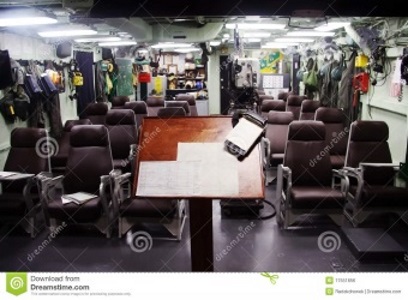 Typical Ready Room
|
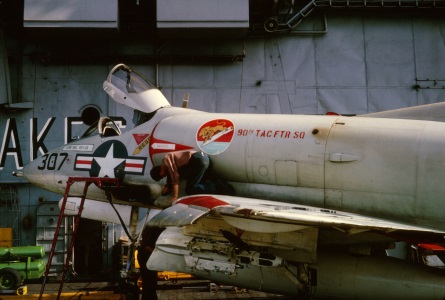 Maintenance Division
Officer workspace
|
Our home away from home was our squadron ready room. Our flight gear was hanging on racks at the back of the ready room. We had a peg board with our squadron coffee cups by rocket numbers (CO and XO on the top and on down descending according to seniority).
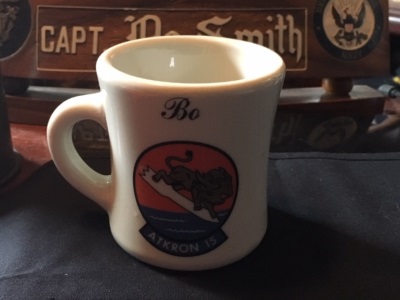 |
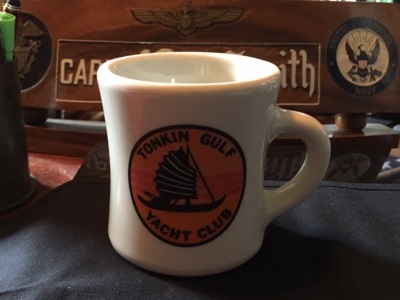 |
We had a coffee pot on at all times and a cooler spray type machine that had lemonade or something similar. There were plexiglass boards with the flight schedule and our trap (landing grades) "tote boards" for all to see. The flight leaders would conduct their flight briefings from a podium in the front of the room with the other members of the flight in the seats in the front row. LSO debriefs were conducted in the front of the ready room unless there was a briefing in progress in which case they would conduct the debrief in the back of the room. Pilots not involved in the briefing sat quietly in the rear seats being careful not to disturb the brief. Otherwise, the ready room was our lounge. Ground Officers would come by as often as possible. Morris E Shepherd (Shep) the Maintenance Control Officer and Bob Cheyne (Avionics/Weapons) stopped by when they could. Dave "Quack" MacMillan, our squadron Flight Surgeon, was in the ready room a lot ensuring we were fit for duty.
The
Squadron Duty Officer (SDO):
The Squadron Duty Officer (SDO) had a desk in the front of the room where he had a phone and a "bitch box" to use to communicate with our squadron Maintenance Control and other ready rooms. The SDO had an ASDO (Assistant Squadron Duty Officer), who was a petty officer and assisted the SDO. Running out of coffee or cold drinks was an unforgivable sin for the SDO/ASDO! We rotated the SDO duty among the JO pilots. So, we had the "duty" about every ten days. We did not fly on those days and stood the duty from before the first pre flight briefing of the day (about 0400 (4:00am) through the movie in the evening, about 2200 (10:00pm). A Petty Officer manned the ready room duty desk at night.
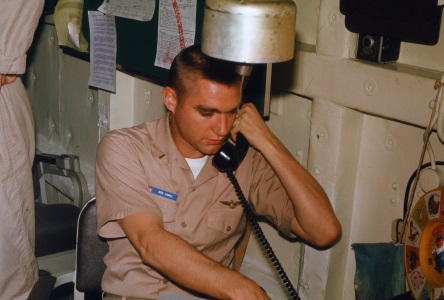 Bob Hamel SDO
|
In addition to the SDO watch, there were two other watches which were associated with underway aircraft carrier flight operations; the CATCC (Carrier Air Traffic Control Center) and PriFly (Primary Flight Control) watches. The CATCC watch is only manned during night or actual IFR (Instrument Flight Rules) conditions when the aircraft are arriving at the carrier and landing using a Carrier Controlled Approach. As we didn't fly at night, this watch was rarely required. But the PriFly watch was. The PriFly watch required that there be one pilot for each aircraft type available with appropriate emergency procedures references present in PriFly in case the Air Boss needed information when an aircraft of that type was being recovered with an emergency condition.
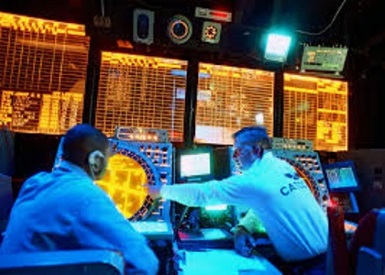 CATCC
|
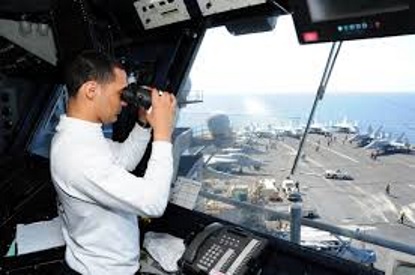 PriFly
|
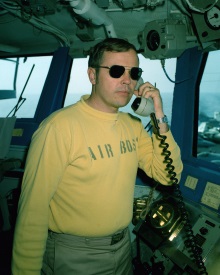 Air Boss in PriFly
|
Those of us who were interested in standing ship watches such as OOD, (Officer of the Deck) AOOD (Assistant Officer of the Deck), or EOOW (Engineering Officer of the Watch) were unable to do so as we were too busy while on the line. But, we could do so during transits to and from liberty ports if we desired to do so.
Operations
and Administrative Officers had
offices on the 03 level (same level as
the ready room). Maintenance Division
Officers spent time in their shops and
observing maintenance activity on the
flight and hangar decks. As the
Aircraft Division Officer, I spent
time in the Power Plants, Hydraulics,
Structural Repair, Ejection Seat and
A/C shops on the hangar deck and with
the parachute riggers in their shop on
the 02 level. I made time to
observe engine and engine fuel control
changes, structural repairs and
scheduled maintenance. Not that I
didn''t trust the First Class and
Chief Petty Officers who ran their
shops but I wanted to learn and to
show interest. One thing about being a
carrier pilot, you had the respect of
the sailors unless you screwed it up
in some way. They appreciated
our interest and we got to know them
and their problems.
Working
with the "troops" was a very rewarding
experience for me!Flight
Organization:
One of the important factors in our combat success (combat effectiveness with low loss rate) was the fact that we established a fixed flight organization during our work-up training and maintained it through the early line periods. This meant that we got to know the good and not so good tendencies of our flight members and we were able to establish work arounds of weak points and take advantage of strong points. As a result, we steadily improved our flying skills and flight integrity during our early Dixie Station operations where the the environment was reasonably low threat. We got better and better with each line period. By the time we started flying in higher threat environments, our exceptional flight integrity was a major contributor to our low loss rate. As we became more experienced, the division organization became more flexible. We still maintained our section integrity most of the time.
The
"Blue Shoes" and the "JO Mafia":
When
we unpacked the green cruise boxes
from a previous era of VA-15 (Spads),
we discovered a plaque with a pair of
golf shoes painted green attached to
the plaque with a plate that stated
that this award is given to the
officer who had stomped on it the most
during the previous month. So, the
legend of the Blue Shoes was born.
Blue Shoes vice green shoes
because we promptly painted the golf
shoes blue, our squadron colors as the
300 series squadron in Airwing Ten.
I don't remember us doing much about awarding the Blue Shoes during work ups as we were working on working primarily on developing our ability to fly as a squadron and hadn't established much of an identity yet. But, if we had, Ike Jones would have been a perfect selection of the award during our Atlantic/Med/Suez/Indian Ocean transit for trying to unsuccessfully squash the dinner proposal of Jake and Flossi Segal for dinner at the Jack Tar Hotel in the Bahamas prior to deployment.
But as we got to know each other better and situations occurred either during an eventful mission or some liberty event, awarding the Blue Shoes became necessary. As time progressed, our group of JOs who entered the squadron together as a group realized that we had political power as far as the Blue Shoes are concerned.
After the first line period, there were only eight pilots senior to our JO group; The CO, XO, Pete Schoeffel, Jerry Tuttle, Possum Terrell, Moon Moreau, Dave North, and Lee Cole. LCDR Butler (Bolter) had been transferred to Saigon (see note 1). We had eleven JOs in our group (Detrick, Thornhill, Parsons, P.C. Craig, Smith, Bob Cole, Dixie Culler, Nolte, Hamel, Newman, and Gene Atkinson. So, if we JOs wanted a particular heavy (senior officer) to get the Blue Shoes and we voted as a block (the term mafia came later), all we needed to do was to convince Dave North, Lee Cole or one of the ground officers to join us in the vote and it was a slam dunk. We could control the process!
JO evening chow on the 2nd deck was over about 1800. On most days, the bow of the flight deck was clear of aircraft following the final recovery of the day. So, we JOs would meet on the flight deck during the senior officer dinner and meet in the ready room afterwards for the evening movie.
These meetings a chance to relax and joke around with our peers after most of us flying two combat missions that day. It also provided us an opportunity to hold strategy sessions on what senior officer should get the Blue Shoes and to formulate a plan on how to get the votes required to make it happen. We would also discuss how to conduct the nomination and if a skit were appropriate to make plans for that.
The Blue Shoes were awarded during a ceremony in the ready room usually after leaving the line either to or from a liberty port. The procedure was that after nominations were given (often using a skit of some kind) followed by a vote. Each wardroom officer had one vote in deciding who would have the honor of receiving the Blue Shoes.
There were four non pilot wardroom officers; Shep Shephard (Maintenance Control), Doc MacMillan (Quack) (Flight Surgeon), Bob Cheyne (Ordnance Officer). and Ensign Dave Moyer (AI). Quack and Bob Cheyne spent lots of time in the ready room and were enthusiastic participants, occasionally siding with the JOs on Blue Shoes votes. Shep was present a lot and was very gregarious but watched the goings on with a reserved smile most of the time. He rarely took sides in a Blue Shoes deliberations. Dave Moyer was in the ready room when he could be and was a JO block regular for the Blue Shoes as he should be as the junior man and only Ensign in the squadron. You can see that in the picture above, Dave North and Bolter (before he left for Saigon) joined the JO block and participated in the nomination skit.
Notes:
1. The Navy discovered that LCDR Bill Butler (Bolter) had worked in OPNAV (The Office of Naval Operations) in Washington and had classified knowledge about what we knew about the SA-2 Guideline Surface to Air Missile System in North Vietnam. They did not want him to fly combat missions in the event that if were shot down and captured, it would be a national security risk. So they sent him to Saigon with work with MACV (Military Assistance Command Vietnam). So Bolter was sent from "out of the frying pan" and into the fire". Go figure!
2. Doc MacMillan was also temporarily assigned to the airwing when underway on deployment. However, he made it a point of being in the ready room often as an active participant.
Two
of my Favorite Personal Photos Onboard
IntrepidI don't remember us doing much about awarding the Blue Shoes during work ups as we were working on working primarily on developing our ability to fly as a squadron and hadn't established much of an identity yet. But, if we had, Ike Jones would have been a perfect selection of the award during our Atlantic/Med/Suez/Indian Ocean transit for trying to unsuccessfully squash the dinner proposal of Jake and Flossi Segal for dinner at the Jack Tar Hotel in the Bahamas prior to deployment.
But as we got to know each other better and situations occurred either during an eventful mission or some liberty event, awarding the Blue Shoes became necessary. As time progressed, our group of JOs who entered the squadron together as a group realized that we had political power as far as the Blue Shoes are concerned.
After the first line period, there were only eight pilots senior to our JO group; The CO, XO, Pete Schoeffel, Jerry Tuttle, Possum Terrell, Moon Moreau, Dave North, and Lee Cole. LCDR Butler (Bolter) had been transferred to Saigon (see note 1). We had eleven JOs in our group (Detrick, Thornhill, Parsons, P.C. Craig, Smith, Bob Cole, Dixie Culler, Nolte, Hamel, Newman, and Gene Atkinson. So, if we JOs wanted a particular heavy (senior officer) to get the Blue Shoes and we voted as a block (the term mafia came later), all we needed to do was to convince Dave North, Lee Cole or one of the ground officers to join us in the vote and it was a slam dunk. We could control the process!
JOs on the Flight Deck
after JO dinner:
JO evening chow on the 2nd deck was over about 1800. On most days, the bow of the flight deck was clear of aircraft following the final recovery of the day. So, we JOs would meet on the flight deck during the senior officer dinner and meet in the ready room afterwards for the evening movie.
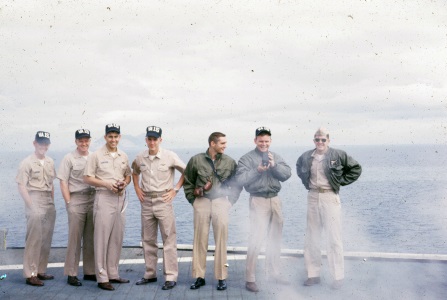 |
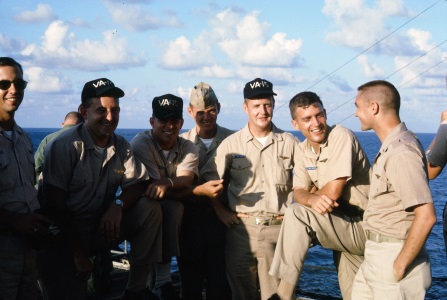 |
These meetings a chance to relax and joke around with our peers after most of us flying two combat missions that day. It also provided us an opportunity to hold strategy sessions on what senior officer should get the Blue Shoes and to formulate a plan on how to get the votes required to make it happen. We would also discuss how to conduct the nomination and if a skit were appropriate to make plans for that.
The Blue Shoes were awarded during a ceremony in the ready room usually after leaving the line either to or from a liberty port. The procedure was that after nominations were given (often using a skit of some kind) followed by a vote. Each wardroom officer had one vote in deciding who would have the honor of receiving the Blue Shoes.
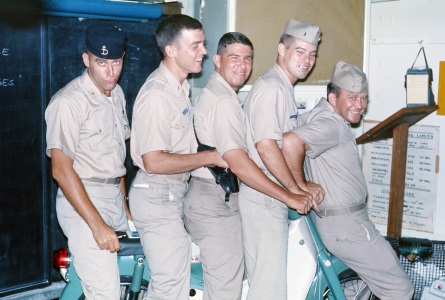 Blue Shoes
nomination skit
LT. Dave North, Dave Parsons, Dixie Culler, Dave Thornhill, LCDR Bill Butler (Bolter) |
There were four non pilot wardroom officers; Shep Shephard (Maintenance Control), Doc MacMillan (Quack) (Flight Surgeon), Bob Cheyne (Ordnance Officer). and Ensign Dave Moyer (AI). Quack and Bob Cheyne spent lots of time in the ready room and were enthusiastic participants, occasionally siding with the JOs on Blue Shoes votes. Shep was present a lot and was very gregarious but watched the goings on with a reserved smile most of the time. He rarely took sides in a Blue Shoes deliberations. Dave Moyer was in the ready room when he could be and was a JO block regular for the Blue Shoes as he should be as the junior man and only Ensign in the squadron. You can see that in the picture above, Dave North and Bolter (before he left for Saigon) joined the JO block and participated in the nomination skit.
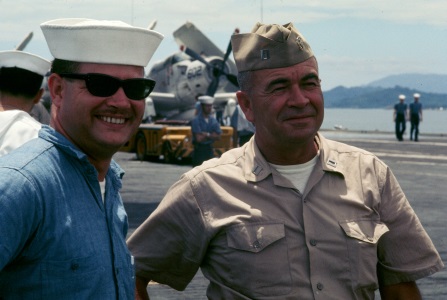 Shep
Shephard-VALion shipmate
Maintenance Control Officer- None Finer |
Notes:
1. The Navy discovered that LCDR Bill Butler (Bolter) had worked in OPNAV (The Office of Naval Operations) in Washington and had classified knowledge about what we knew about the SA-2 Guideline Surface to Air Missile System in North Vietnam. They did not want him to fly combat missions in the event that if were shot down and captured, it would be a national security risk. So they sent him to Saigon with work with MACV (Military Assistance Command Vietnam). So Bolter was sent from "out of the frying pan" and into the fire". Go figure!
2. Doc MacMillan was also temporarily assigned to the airwing when underway on deployment. However, he made it a point of being in the ready room often as an active participant.
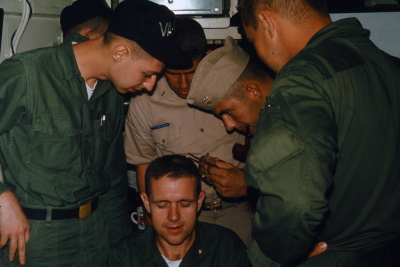 |
During preflight of an aircraft one day, Jerry Tuttle cut his head on a TER rack. He asked Doc MacMillan to stitch him up on the spot so that he could go on the flight. A few weeks later, Doc let us JOs remove the stitches one at a time in the ready room prior to the movie. I got the honors for one of the stitches (Note the pipe) |
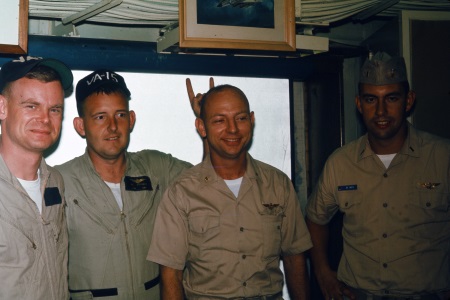 Left to
right: Bob Cole, Gene
Atkinson, Possum, me
|
We normally had a movie starting about 1930 (7:30pm) This picture was apparently taken just before the movie was about to start. (Note movie screen down) |
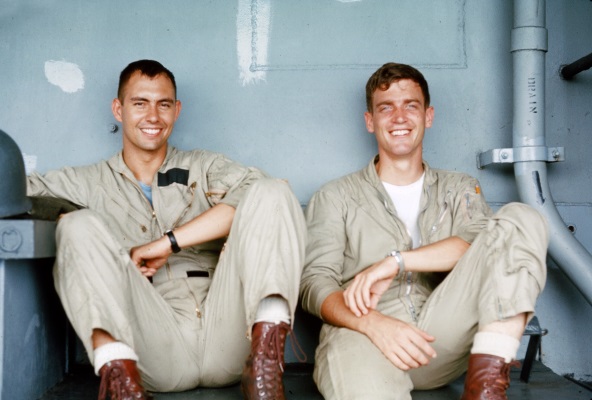 Me with my friend and
fellow Possum flight member,
Dave Parsons
Note the tan flight suits and shiny brown flight boots. |
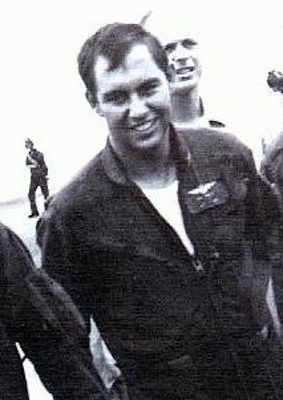 Me with Pete Schoeffel
Note the nomex flight suit. |
Our Second Port Visit Period:
Sasebo Japan (About August 12th- and August 25th)
Hong Kong (August 27th-August 30th)
(Miller Detrick flew to Hong Kong to meet Connie August 13th and met the ship when it came in to Hong Kong August 27th for four days)
Sasebo Japan (About August 12th- and August 25th)
Hong Kong (August 27th-August 30th)
(Miller Detrick flew to Hong Kong to meet Connie August 13th and met the ship when it came in to Hong Kong August 27th for four days)
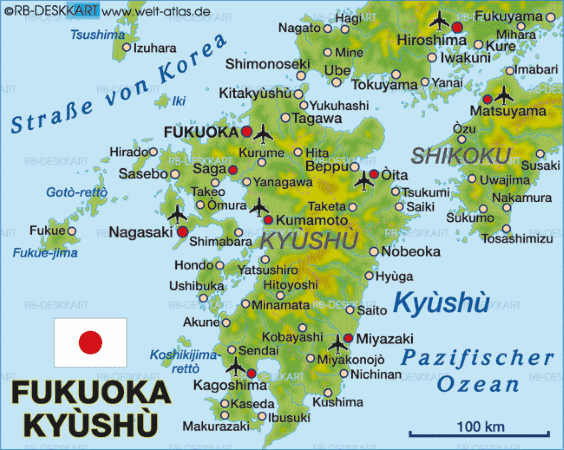 Sasebo is one of the pink
dots on the far left (west) on
the Island of Kyushu. Nagasaki
is south of Sasbo. Imari (not
identified) is northeast, and
Beppu is to the east.
|
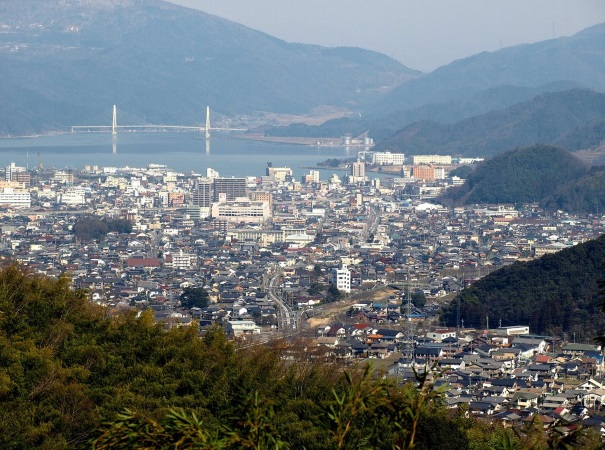 The Island of Kyushu is
very hilly with lots of islands.
The center of the island
consists of active volcanoes
with numerous hot springs
such as at the resort area of
Beppu.
|
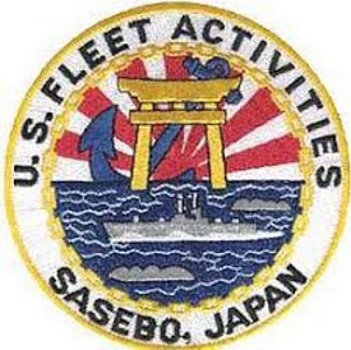 |
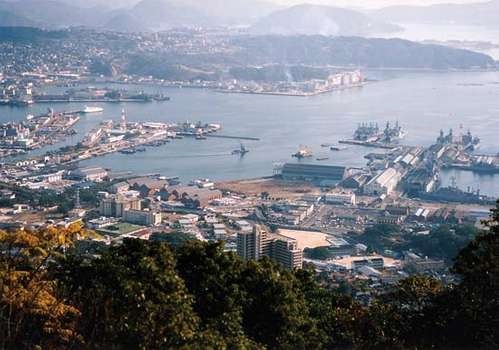 |
Fleet
Activities Sasebo has an excellent ship
repair facility including a dry dock.
Intrepid had some work done on one of her four massive screws either on this port visit or during our Sasebo visit next cruise.
Intrepid had some work done on one of her four massive screws either on this port visit or during our Sasebo visit next cruise.
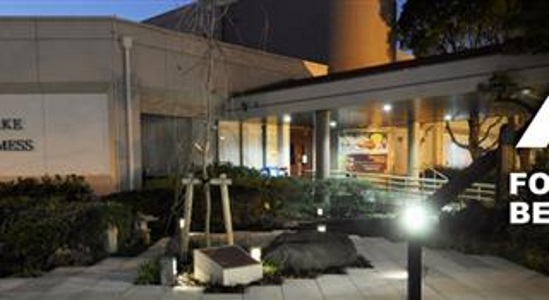 The Officer's Club at
Sasebo has especially good food.
|
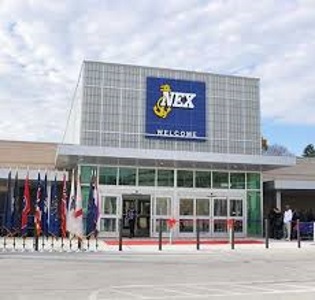 The Navy Exchange (NEX)
|
The
Navy Exchange has an excellent selection
of Imari china. The town of Imari is
located on Kyshu just to the north of
Sasebo.
Imari
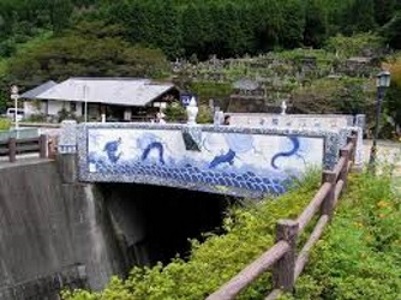 Porcelain china bridge at
Imari
|
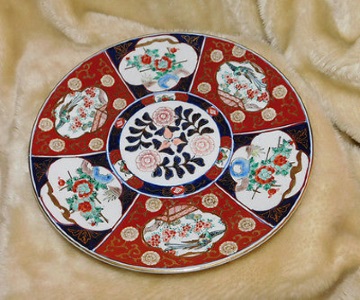 Imari Gold hand painted
dinner plate
|
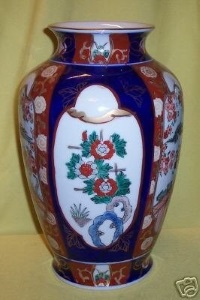 Imari Gold Vase
|
I didn't buy any Imari china on this cruise or the next.
But when I had my two year tour of duty in Japan (my last active duty assignment), my wife (second wife Cathy) and I purchased
eight place sittings of Imari Gold china (center picture) and numerous other Imari pieces including the Imari Gold Vase pictured on the right)
Beaches and Fishing near Sasebo
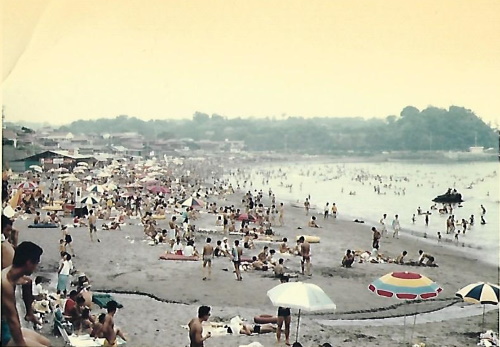 |
 |
| The beaches
were crowded near
Sasebo in August |
Most
fishing was accomplished
using large nets |
Beppu
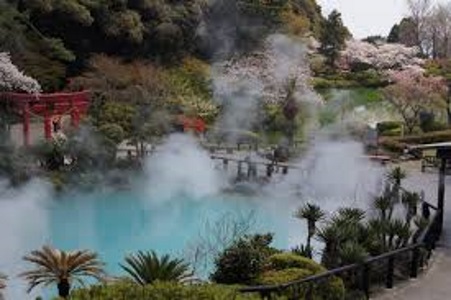 There are lots of hot
springs at Bepppu
|
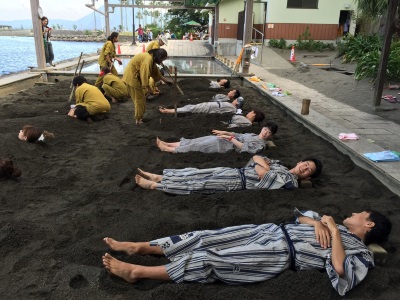 Go local and try at hot
lava sand soak at Beppu
|
Nagasaki
Take
the train from Sasebo to Nagasaki. It's
a beautiful ride.
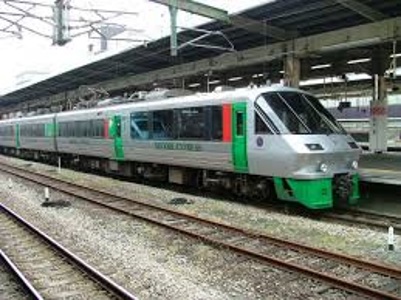 |
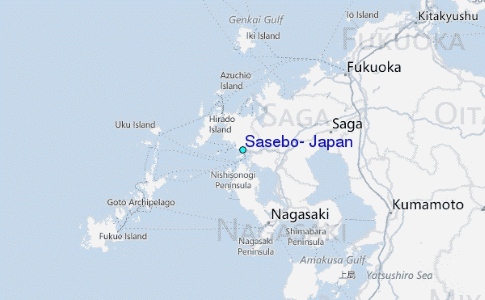 |
Of
course there are lots of tours and
museums documenting the damage,
death, and horific injuries
suffered at Nagasaki.
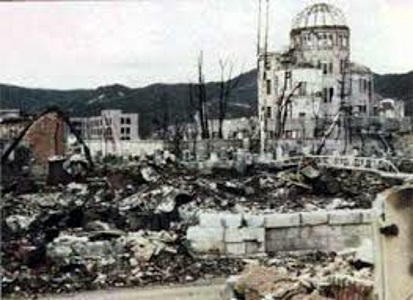 Ground Zero at Nagasaki (From Google) |
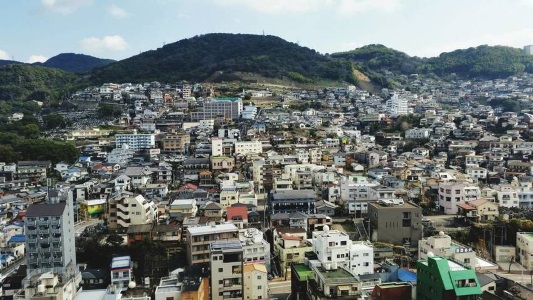 Nagasaki today
|
Gene
Atkinson, Dave Moyer, and I took the
train from Sasebo to Nagasaki and
visited the various museums and
landmarks there.
The Japanese had preserved places where you could actually still see the shadows in the concrete made where bodies had been burned by the blast.
As horrific as this loss of life in one explosion was and the after effects of radiation poisoning with those who survived, it is important to understand that there would have been a much larger loss of Japanese lives and unacceptable loss of American lives had the Emperor not decided to surrender and ground attack on Japan be required.
After visiting Nagasaki, we took the train back toward Sasebo. But, we stopped at a resort hotel in the mountains of the Nishosongi Peninsula.
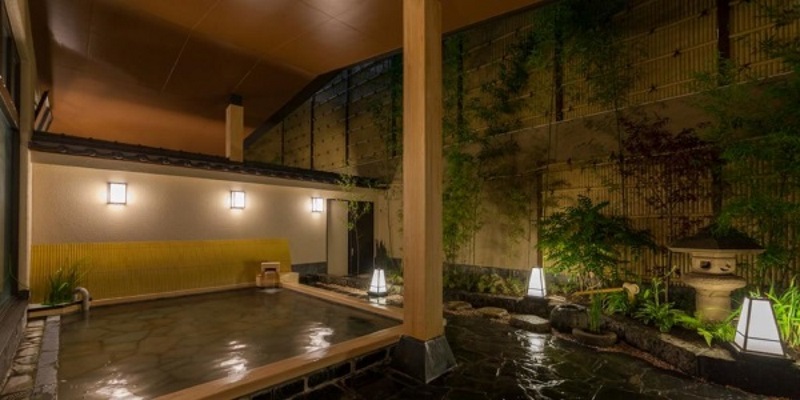
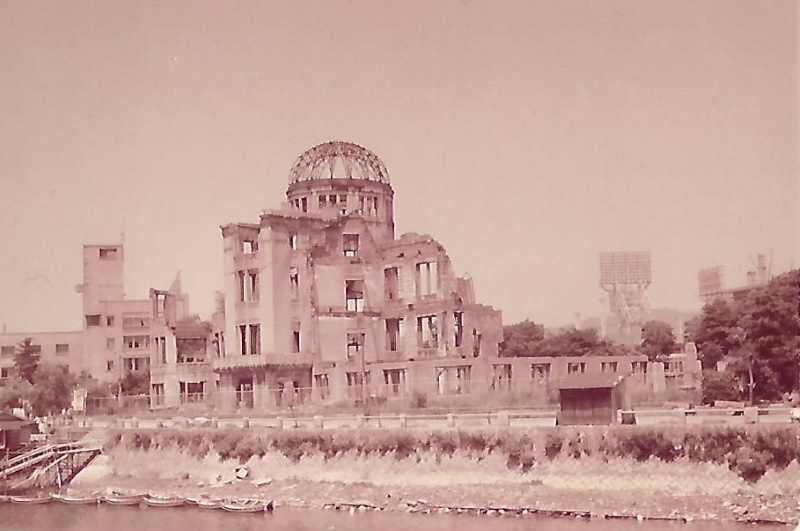 |
| This is my photo of "ground
zero" at Nagasaki taken on our
trip. |
The Japanese had preserved places where you could actually still see the shadows in the concrete made where bodies had been burned by the blast.
As horrific as this loss of life in one explosion was and the after effects of radiation poisoning with those who survived, it is important to understand that there would have been a much larger loss of Japanese lives and unacceptable loss of American lives had the Emperor not decided to surrender and ground attack on Japan be required.
After visiting Nagasaki, we took the train back toward Sasebo. But, we stopped at a resort hotel in the mountains of the Nishosongi Peninsula.

I don't remember the name of the resort hotel. But, it was Japanese, not western. We had a very nice spacious room with low tables and tatami mats. Our beds consisted of thick embroidered mats that were rolled up when not in use. We ate our meals in the restaurant at western style table I think. Dave Moyer was a big guy, about 6' 3" and about 220 lbs. He would have had a difficult time sitting cross legged at a typical Japanese low table. I don't recall anything about the food. I suspect we had tempura or something similar.
What I do remember very clearly was our session in the hot spring pool and shower! The resort had an indoor hot spring pool which was divided by a translucent barrier between the male and female portions of the pool. There were locker room and showers for each side of the pool. The procedure was that the hotel guest went to the locker room, put his or her closes in a locker and then went in the hot spring pool naked. Imagine this about 10 Japanese guys in the male side of the pool with us with the indistinct images of an equal number of naked women on the other side of the pool divider. Even stranger is what occurred in the shower room after we got out of the hot spring pool. Dave Moyer's physique looked similar to Michelangelo's "David" in Florence. Dave was tall, well muscled, had a narrow waist, and had long muscular legs. Most of the Japanese guys in the shower starred at him checking out all of his physical features.
After getting dressed in the locker room, we returned to our room where I had arranged for individual massages. When we opened the door to our room we were greeted by three attractive young Japanese girls. Each girl had a message mat that she rolled out. So there they were three girls with three mats in a row. I told Gene and Dave to strip naked and pick mat and lie down on it. As our skivvies came off, the girls shaded their eyes with a one of their hands and giggled. They quickly put a towel over our privates with their free hand.
It was a great trip! I knew Gene pretty well before the trip. But, it was a great opportunity to get acquainted with Dave Moyer as he spent most of his time onboard the ship in CVIC.
Hong
Kong (August 27th-August 30th)
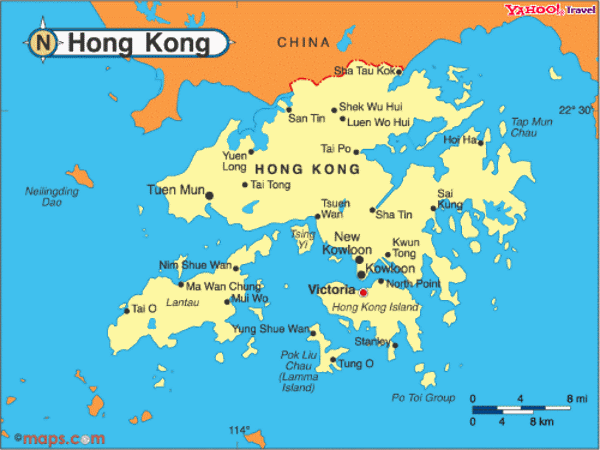
Hong Kong in 1966 was
under British Control.
The UK controlled Victoria
Island and Kowloon on the
mainland of China. Where
the map is labelled Hong Kong
south of the Chinese border
was known then as the New
Territories.
|
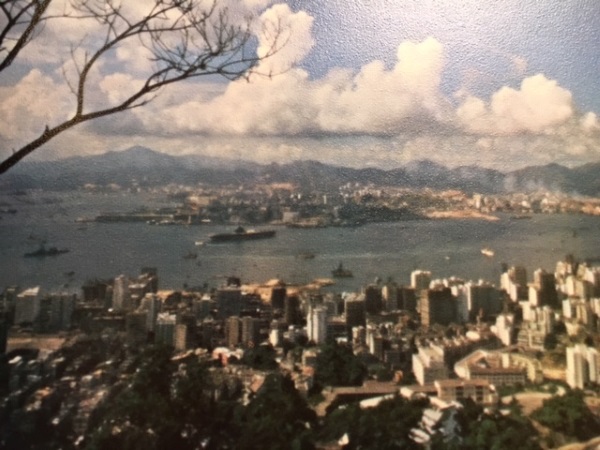
This picture is from the 1966 Intrepid cruise book. Intrepid is anchored between Victoria Island and Kowloon. |
I took these pictures
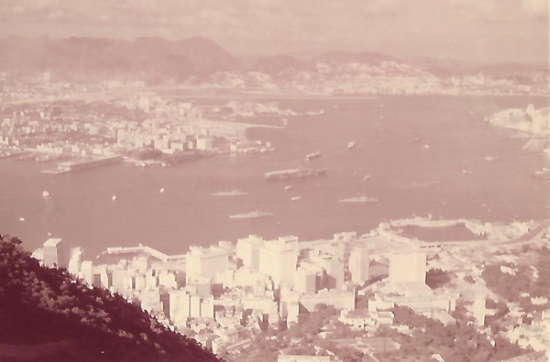 |
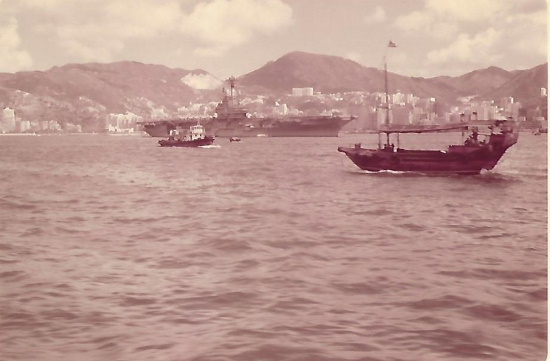 |
| It was kind of hazy from
Victoria Peak |
Intrepid from the Star
Ferry heading toward Kowloon |
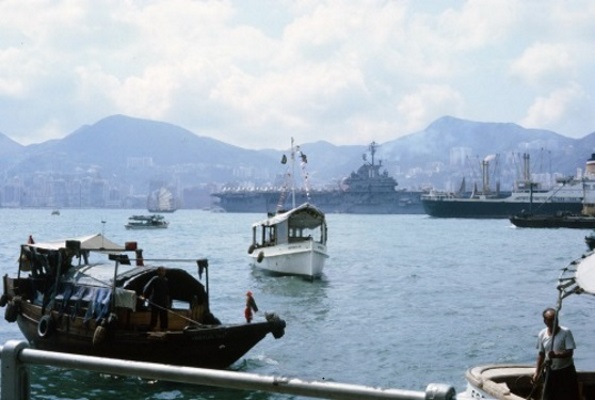
USS Intrepid inport Hong Kong (note the 11 on the island). This picture was taken from Kowloon toward Victoria Island. Intrepid's liberty boats went from the ship to fleet landing on Victoria Island. |
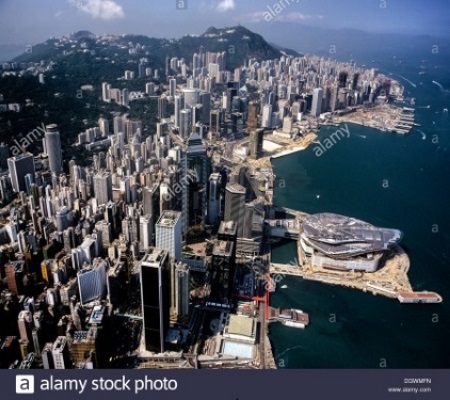
Victoria island was more modern than Kowloon and had nice restaurants and hotels. If you wanted to go to Kowloon, you had to take the famous Hong Kong ferry from Victoria to Kowloon. |
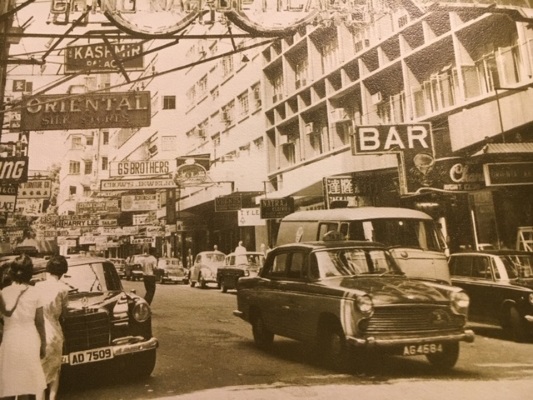
Kowloon had
great Chinese restaurants
and lots of entertainment.
It was also known for its
famous tailors.
Most of us had
suits and monogrammed shirts
made there. |
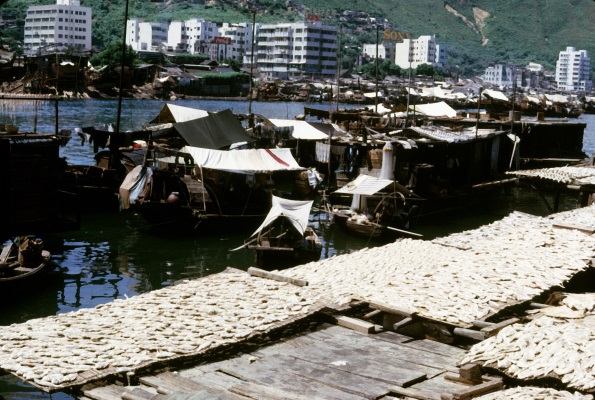
This one of Kowloon's
famous fishing villages. Not
only did they dry the fish on
the flat areas shown above but
also strung from the rigging
of the boats.
|
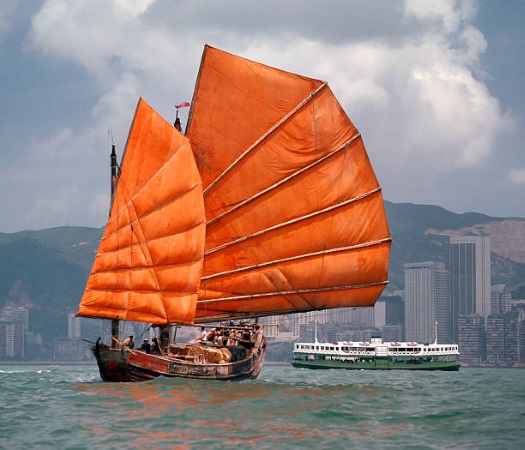
This one of of Hong
Kong's famous red sailed
junks.
Note the Hong Kong ferry in the background |
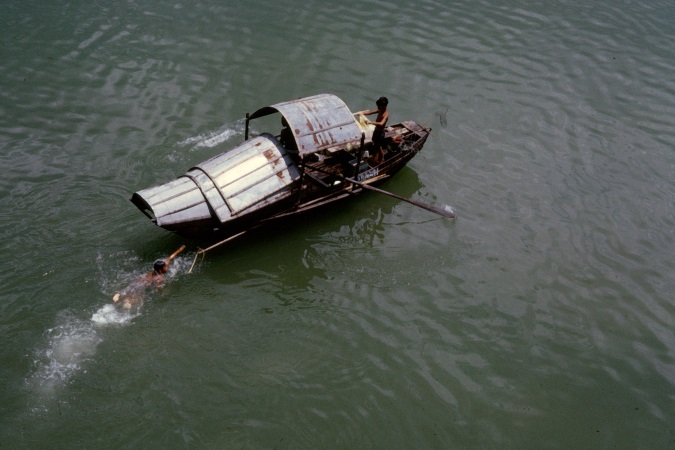
Young boys would come out
to the ship to dive for
whatever sailors would through
in the water from the ship.
|
Our Third Line Period- September 1st - September 23rd, 1966- Yankee Station
 |
| We flew most of our combat
missions during our Third Line
Period in Route package 2 (from
Ha Tinh to north of Vinh)
and in Route Packages 3 and
4 (from south of Thanh Hoa
to north of Nam Dinh) reasonably
close to the coast. |
Because of our lack of electronic warfare (EW) equipment, most of our combat missions were road reconnaissance (recce) flights that were designed to avoid high threat AAA or SAM defenses. As we gained experience, we began flying division level strikes against targets in medium level threat environments. At some point, we flew strikes in the AAA/SAM environment at Vinh and in larger strikes against the Thanh Hoa bridge. Because of our lack of EW equipment we had to keep our enroute altidudes low so that we could dive toward the ground if attacked by a SAM. That wasn't a problem for road recces which were flown at about 4,000 feet. But, for division strikes against targets defended by 37/57 mm AAA, we used an enroute altitude about 12,000 feet made us vulnerable to 37/57 mm barrage fire in the well defended major target areas. We were most vulnerable to SAMs and radar controlled AAA enroute to the target and then everything during our bomb run.
However, we we not the only airwing that was using low altitude tactics during the summer of 1966. CAG 16 onboard the USS Oriskany (CVA-34)
USS Oriskany/CAG 16 deckload
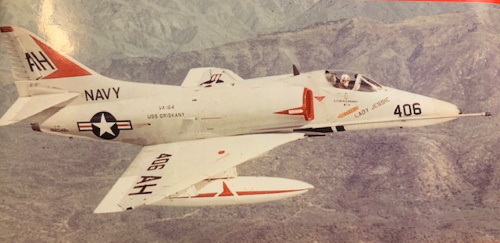 |
| Airwing
Sixteen consisted of the following
aircraft: Two A4E squadrons: VA-163 and
VA-164 (VA- 164 A4E pictured here)
One A3B Heavy Attack squadron: VAH-4 One Spad squadron: VA-152 Two Crusader fighter squadrons: VF-111 (F8Cs) and F-162 (F8Es) Note: F8C were fighters only, F8E had a bombing capability |
 |
Peter Fay's well
researched book "Bloody Sixteeen"
details the performance of USS
Oriskany and CAG 16 team during three
Vietnam deployments; 1965, 1966, and
1967. I will compare some aspects of the CAG 16 experience during the summer of 1966 with ours onboard Intrepid. CAG 16 had more combat experienced pilots than we had. They came to Yankee Station in 1966 after a few weeks of warmup in South Vietnam. We were new to the game. But, we had two line periods on Dixie Station to develop our bombing and flight integrity skills. |
Even though the CAG 16
aircraft were configured with
the APR- 25 and APR-27
electronic warfare (EW)
equipment, they chose to fly
at low to medium altitudes.
They didn't have much
confidence that their EW
systems would protect them
against the SAMs so wanted to
be able to execute an anti SAM
maneuver to get to low
altitude as soon as possible.
Of course this meant that they
would be flying in the
37/57/85mm AAA envelopes when
enroutre to a well defended
target, at the target roll in
point and bombing run, and
during their egress from the
target to the coast. Because
the Oriskany was a complete
air wing with experience, thy
were assigned most of the high
risk targets during this
period.
During our two line
periods when we were on
station with the
Oriskany (September 1st
through October 19th), CAG 16
did not loose an aircraft or
pilot due to ground fire but
had 22 aircraft damaged from
combat; 16A4Es damaged by
ground fire (mostly on road
recces missions), one F8C from
VF-111 damaged by gun fire
from a MIG 17, and 5 Spads
damaged by ground fire.
None of these aircraft was
damaged by a SAM missile. One
of the Spads was hit by 14.5
automatic machine gun fire
(low altitude) during a Thanh
Hoa bridge strike. Most of
this damage can be attributed
to the low to medium altitude
tactics used by CAG-16.
Note: In 1966, we thought that the lowest effective range of the SA-2 was 3,000' AGL (above ground level). So, our objective when avoiding a SAM was to get below 3,000' as soon as possible. However, study of a captured SA2 Guideline missile system revealed that the effective minimum range of the SA 2 was 1,000 to 1,500 feet. This meant that anti SAM maneuvers should be executed at medium to high altitude by turning in to the SAM not by heading for low altitude where small caliber (50 cal) machine gun fire could be lethal. We were not aware of this during our 1966 deployment but would change our tactics for the 1967 deployment. The Oriskany and CAG 16 continued to use lower altitude tactic which would prove to be costly in more planes damaged by ground fire and lost pilots and aircraft. ("Bloody Sixteen", Peter Fey, page 183)
Note: In 1966, we thought that the lowest effective range of the SA-2 was 3,000' AGL (above ground level). So, our objective when avoiding a SAM was to get below 3,000' as soon as possible. However, study of a captured SA2 Guideline missile system revealed that the effective minimum range of the SA 2 was 1,000 to 1,500 feet. This meant that anti SAM maneuvers should be executed at medium to high altitude by turning in to the SAM not by heading for low altitude where small caliber (50 cal) machine gun fire could be lethal. We were not aware of this during our 1966 deployment but would change our tactics for the 1967 deployment. The Oriskany and CAG 16 continued to use lower altitude tactic which would prove to be costly in more planes damaged by ground fire and lost pilots and aircraft. ("Bloody Sixteen", Peter Fey, page 183)
The third line period lasted only about 23 days. But, it was a busy and challenging time as we learned to operate in the high threat environment of North Vietnam. I flew 25 combat missions during that line period (97 total) (9 strike/flight Air Medals). All of my missions had the 1T1 or 1T2 flight codes (north Vietnam) except for two 1 point green entries for combat support (tanker) missions.
These
are details of some
of the missions I
flew.
Vinh Close Call
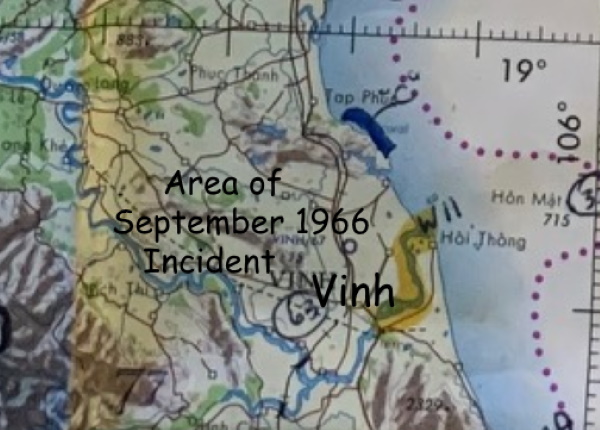 |
On
one of my early road recce missions, I
was flying in a section with Miller
Detrick. I recall that we were
flying west of Vinh in perfectly clear
weather at about 8,000
feet. Miller was flying my wing
in a combat cruise position about
1,000 feet away from me. Without
any warning, my aircraft was
completely enveloped in gray to dark
gray AAA (flak) bursts. This had
to be very accurate radar controlled
AAA, either 57mm or 85mm. We had
no EW equipment, so we had no warning
that I was being tracked.
From Miller's prospective, my aircraft disappeared in numerous puffs of well aimed AAA. We had not experienced very much flak so far in Route Package 2 road recces so we weren't experienced in determining the difference between the dark gray 57mm from the black 85 mm. This well aimed fire probably came from Vinh.
From my perspective, I lost control of my aircraft as it flipped inverted and tumbled out of control. The aircraft recovered itself and it flew out nose down and I regained control.
Miller checked my aircraft for damage or any leaking red hydraulic fluid or fuel but found no problems. We returned to the ship and made a normal recovery. When the maintenance guys checked my aircraft back on deck, they found no holes. Amazing. I guess the AAA bursts temporarily disturbed the air around my plane so it went out of control for a second or two.
Someone was looking out for me on this mission! Perhaps God was flying with us!
From Miller's prospective, my aircraft disappeared in numerous puffs of well aimed AAA. We had not experienced very much flak so far in Route Package 2 road recces so we weren't experienced in determining the difference between the dark gray 57mm from the black 85 mm. This well aimed fire probably came from Vinh.
From my perspective, I lost control of my aircraft as it flipped inverted and tumbled out of control. The aircraft recovered itself and it flew out nose down and I regained control.
Miller checked my aircraft for damage or any leaking red hydraulic fluid or fuel but found no problems. We returned to the ship and made a normal recovery. When the maintenance guys checked my aircraft back on deck, they found no holes. Amazing. I guess the AAA bursts temporarily disturbed the air around my plane so it went out of control for a second or two.
Someone was looking out for me on this mission! Perhaps God was flying with us!
We learned that it was wise to give Vinh a wide berth. Vinh had a very good SAM and AAA defense system. Vinh became known as a location where you didn't get much warning before a SAM launch or very accurate aimed AAA. It seems that they used acquisition raiders which were hard to detect before using fire control radars to take a shot. I was very lucky to have survived that day.
Thanh Hoa Road Recce
As we got a few missions under our belt, we began flying missions in Route Packages 3 and 4 from Thanh Hoa to Nam Dinh.
We confined our missions at first to road recces along Routes 10 and the coast as we had no fighter cover.
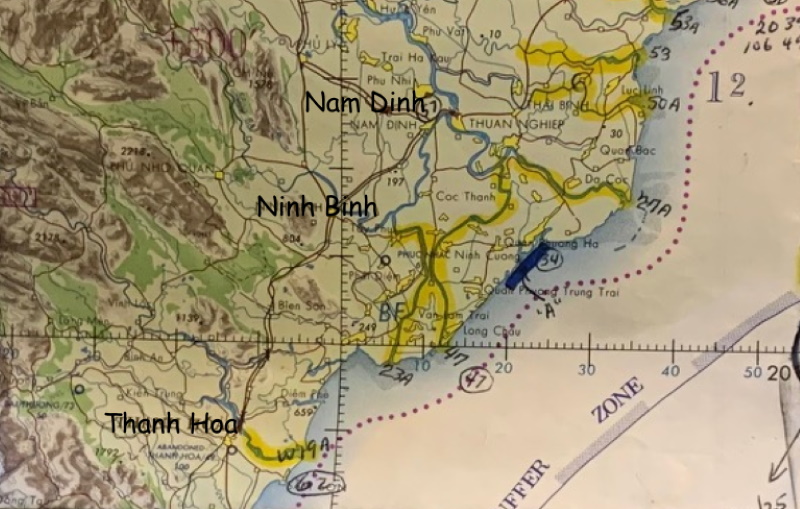 |
On
one such mission, I was flying with
Possum Terrell as the lead with Dave
Parsons and I both flying section
positions on either side.
We started our recce a few miles south of Nam Dinh being careful to avoid AAA positioned there. The flight proceeded southwest along Route 10 to Ninh Binh. Dave's and my job on both sides was to look out for MIGS (unlikely) and watch for any AAA fire and Surface to Air missile launches fire (more likely) while watching the road for prospective targets if we had a chance. Possum's job was navigating and looking out for potential targets such as trucks and small bridges; anything we could destroy or inhibit their ability to move stuff south.
Dave and I flew a figure eight pattern so that Possum could watch us in his mirrors. We did not see any AAA as we progressed south. I assume we found something worth dropping bombs on but we had bombs left when we began taking fire from ahead from the area of a large bridge. Possum turned hard left toward the coast to avoid the fire. Apparently, we overflew Ninh Binh but didn't realize it and continued southwest along Route 10 toward Thanh Hoa. I think we continued our left turn back toward Ninh Binh to find something worth bombing before returning to the ship. I
I'm sure that the AIs (Air Intelligence officers) found it amusing that we had just flown a road reece to the Thanh Hoa bridge. The Thanh Hoa bridge was one of the most infamous targets of the war. About a hundred aircraft we were lost in the Thanh Hoa area until the bridge was finally destroyed in 1972.
We started our recce a few miles south of Nam Dinh being careful to avoid AAA positioned there. The flight proceeded southwest along Route 10 to Ninh Binh. Dave's and my job on both sides was to look out for MIGS (unlikely) and watch for any AAA fire and Surface to Air missile launches fire (more likely) while watching the road for prospective targets if we had a chance. Possum's job was navigating and looking out for potential targets such as trucks and small bridges; anything we could destroy or inhibit their ability to move stuff south.
Dave and I flew a figure eight pattern so that Possum could watch us in his mirrors. We did not see any AAA as we progressed south. I assume we found something worth dropping bombs on but we had bombs left when we began taking fire from ahead from the area of a large bridge. Possum turned hard left toward the coast to avoid the fire. Apparently, we overflew Ninh Binh but didn't realize it and continued southwest along Route 10 toward Thanh Hoa. I think we continued our left turn back toward Ninh Binh to find something worth bombing before returning to the ship. I
I'm sure that the AIs (Air Intelligence officers) found it amusing that we had just flown a road reece to the Thanh Hoa bridge. The Thanh Hoa bridge was one of the most infamous targets of the war. About a hundred aircraft we were lost in the Thanh Hoa area until the bridge was finally destroyed in 1972.
Thanh Hoa Bridge Strikes
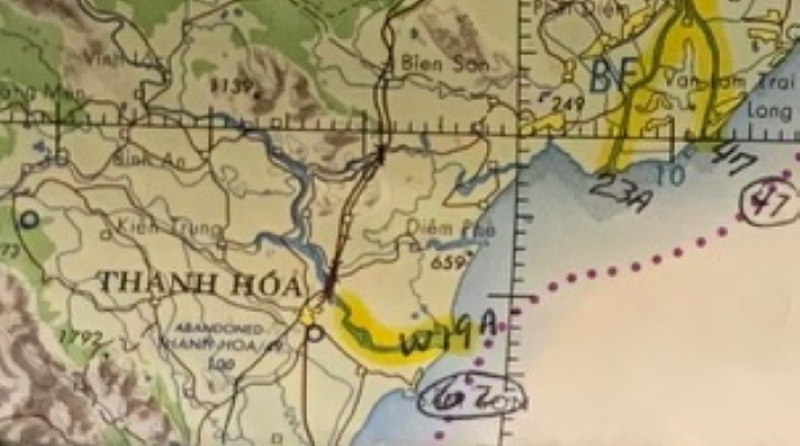 |
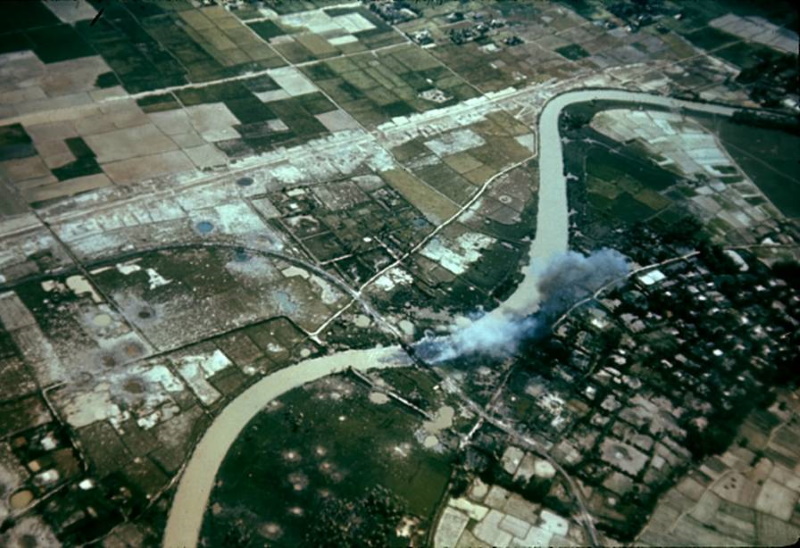 |
| The Thanh Hoa bridge was the "hottest" target in Route Package 4 but it was close enough to the coast that we were considered capable of handling it. |
The chance of MIGs coming
down to Thanh Hoa was
slight. And, even though
there were lots of SAM and
radar controlled AAA (57 and
85mm) in the area, we only had
a short time enroute to the
target and our egress from the
target at 550 kts or so would
be quick. Our biggest
threat was diving through the
37/57 mm non radar controlled
barrage fire in the target
area itself.
These were the biggest strike of our third line period. We had BARCAP (Barrier Combat Air Patrol)flown by F4s from another carrier, Iron Hand (Anti-SAM) support from another carrier, EW support from another carrier, and photo recon BDA from another carrier.
However, Intrepid had the best RESCAP capability at Yankee Station with our two A1 Spad squadrons (Oriskany had one Spad squadron, VA-152). The Spads had a great forward firing weapons capability with their rockets and guns but were too slow to participate in a strike in a high threat area like Thanh Hoa.
All we could provide was Flak suppressors and bombers. Flak suppressors were normally loaded with four Zuni rocket pods and sometimes with VT fused bombs. Their job was to fire at AAA sites that were firing from the ground. They were not hard to find. In 1966, the North Vietnamese were still using classically circular AAA site with the radar in the middle. And, there were lots of flashes on the ground from 37/57 guns.
Our main mission was to put as many bombs on the bridge as we could. So our job was to get to the bridge, get in our bomb run, make a good run and put our bombs on target. Our squadron tactics required that we maintain section integrity. So, we wingmen stayed close (combat cruise) to our leaders right up to the roll in position. Then our job was to make as good a bomb run as possible putting our bombs on target. Our job off the target was to join on our leader fly to a combat spread and fly through his mirrors so that he could know that we were with him during the egress to the coast. The flight leaders were supposed to give us about 1% of power to work with and then make a gradual turn in our direction on egress so that we could catch up.
Note: Shep (Maintenance Control officer) and I (Aircraft/Power Plants Division Officer) helped the wingmen by ensuring that the aircraft flown by the wingmen had a little more power at 100% than the flight leader aircraft. So, when in the hreat of the strike, if the leaders forgot to give the 1%, the wingman had enough power to catch up. If the flight leader know this, they didn't complan. After all, Jerry Tuttle wa the Maintenance Officer and he and Shep probably thought this plan up!
These were the biggest strike of our third line period. We had BARCAP (Barrier Combat Air Patrol)flown by F4s from another carrier, Iron Hand (Anti-SAM) support from another carrier, EW support from another carrier, and photo recon BDA from another carrier.
However, Intrepid had the best RESCAP capability at Yankee Station with our two A1 Spad squadrons (Oriskany had one Spad squadron, VA-152). The Spads had a great forward firing weapons capability with their rockets and guns but were too slow to participate in a strike in a high threat area like Thanh Hoa.
All we could provide was Flak suppressors and bombers. Flak suppressors were normally loaded with four Zuni rocket pods and sometimes with VT fused bombs. Their job was to fire at AAA sites that were firing from the ground. They were not hard to find. In 1966, the North Vietnamese were still using classically circular AAA site with the radar in the middle. And, there were lots of flashes on the ground from 37/57 guns.
Our main mission was to put as many bombs on the bridge as we could. So our job was to get to the bridge, get in our bomb run, make a good run and put our bombs on target. Our squadron tactics required that we maintain section integrity. So, we wingmen stayed close (combat cruise) to our leaders right up to the roll in position. Then our job was to make as good a bomb run as possible putting our bombs on target. Our job off the target was to join on our leader fly to a combat spread and fly through his mirrors so that he could know that we were with him during the egress to the coast. The flight leaders were supposed to give us about 1% of power to work with and then make a gradual turn in our direction on egress so that we could catch up.
Note: Shep (Maintenance Control officer) and I (Aircraft/Power Plants Division Officer) helped the wingmen by ensuring that the aircraft flown by the wingmen had a little more power at 100% than the flight leader aircraft. So, when in the hreat of the strike, if the leaders forgot to give the 1%, the wingman had enough power to catch up. If the flight leader know this, they didn't complan. After all, Jerry Tuttle wa the Maintenance Officer and he and Shep probably thought this plan up!
My
flight log entries for the
Third Line Period
(September 1st through
September 23rd)
September
1st- 1.8, combat
support tanker
mission (1M1), 1.0
actual instruments,
1 CCA( this mission
gave me 140 points)
So, I received my 7th Strike Flight Air Medal at this point.

So, I received my 7th Strike Flight Air Medal at this point.
September 2nd- I did not fly September 2nd. SDO
September 3rd- 1.9, combat support tanker mission (1M1)0.5 actual instruments, 0.8 night time, 1 CCA, 13th night trap
Great start so far up north for me! Three days on Yankee Station and all I have to show for it is two tanker hops (flights) and the SDO.
The
combat Support
Tanker was an
Important
Mission on
Yankee Station
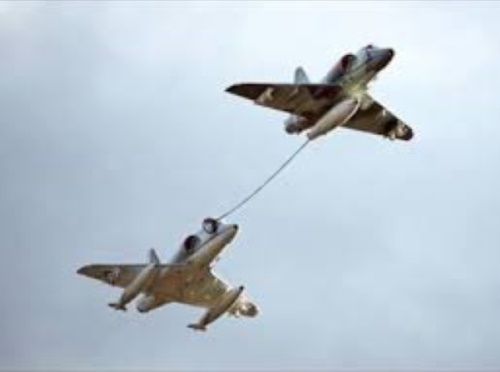 |
Fuel
was critical
on every
mission.
In order to be
effective on
these
missions,
pilots had to
use as much as
they could on
the mission
but still have
enough to
return to the
ship and land
safely.
If a pilot
returned too
low on fuel,
he had to get
to "the duty
tanker" and
get fuel
expeditiously.
However, we JOs had with flying these "duty tanker" tanker flights. The "decision makers" wanted us to take as much fuel as possible on these flights. The squadron had gigantic fuel tanks (capacilty of 3000 pounds of fuel) that could be carried on the centerline station available for these missions. The problem was that if we used this tank on the centerline stations and a full load of fuel in the inflight refueling store (Buddy Store) (2000 pounds) and the normal 2000 pound fuel tank on the other wing, we would be right at the maximum gross take off weight for the catapult (cat) shot. At this gross gross weight, the pilot had to raise the nose of the A4 to exactly the correct number of degrees above the horizon to make a successful cat shot. Too much nose attitude, you went in the water; too little you're in the drink.
The only chance you had, if you began to loose altitude (settle) of the cat was to eject or to jettison the Buddy Store and the wing fuel tank. After a pilot or two did the jettison thing, the "decision makers" reduced the amount of fuel in the main tank to give us a better margin for error off the catapult.
If we had ejected, it might not have as much impact as jettisoning a Buddy Store. Buddy Stores were a critical item and we didn't have many available.
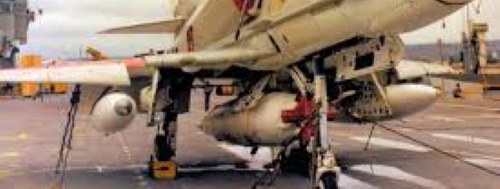 |
| Douglas
Buddy Store on
centerline of
an A4 Skyhawk |
September 4th- 1.7, 6 MK 81s, (My 75th combat mission of the cruise)
September 5th- 1.3, combat support tanker mission (code 1M1- 1 point), 3 wet plugs
September 5th- 1.1, 2 LAU 10 pods (four 5" rockets each)
Note: the 1.3 and 1.1 flight times indicate that the ship was not operating in the regular cyclic deck ops. We were probably flying division strike packages to an important target; perhaps the Thanh Hoa bridge.
September 6th- 0.9, 4 LAU 10; Flak suppressor mission to the Thanh Hoa bridge?
September 6th- 1.6, 4 MK 82s, back to cyclic ops in the afternoon. This is a road recce bomb load
September 7th- Stand down. We did not fly. WE had a USO show on the flight deck on September 7th
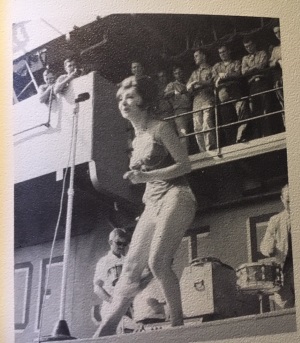 |
Our USO show consisted of a group of Miss America contestants who performed on the flight deck and on the enlisted mess decks |
September 8th- I did not fly. SDO (two days wihtout flying was very very unusual
September 9th- 1.8, 4 Mk 82s, road recce. This was my 80th mission.
September 9th- 1.6, 4 Mk 82s, road recce
September 10th- 1.7, combat support tanker, (1M1 code-1 point), 3 wet plugs
September 10th- 1.7, 6 Mk 81s
Note: September 9th and 10th were cyclic ops days. Many of us flew two missions a day
September 11th and 12th were flex deck short cycle days; launch a strike package, recover the strike package and respot the deck for another strike package
September 11th- 1.0, 7 Mk 82s and 1 Mk 81. This bomb load could only be accomplished by removing the centerline fuel tank and configuring the aircraft with three TERs. The only fuel available would be the 5400 #s of main fuel. This was a flex deck large strike of some kind.
September 12th- 1.1, 7 MK 82s ans 1 Mk 81. This was another flex deck strike package. I accumulated 160 points with this mission.
I was awarded my 8th Strike Flight Air Medal with this mission.
September 13th- 1.7, 6 Mk81s. This was a 3T2 flight purpose code. . But, I don't know what the 3T indicates. Perhaps a night north mission.
I logged 0.6 actual instrument time and 0.9 night time with my 14th night trap of the cruise.
September 14th- 1.5, 4 MK 82s
September 15th- 1.7, another combat tanker mission
September 16th- 1.7, 6 Mk 81s
September 17th- I did not fly. SDO
September 18th- 1.7, 4 Mk 82s, classic road recce bomb load my 90th mission
September 18th- 1.7, 4 Mk 82s, my second road recce flight of the day
Note: I was leading the section road recce flight at this point
September 19th- 1.7, 4 MK 82s
September 20th- 1.5, My log book says two MK 4 gun pods. The gun pod was an excellent road recce weapon for shooting at trucks
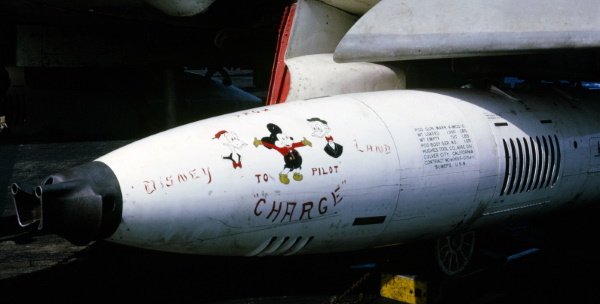 |
| MK 4 gun pod |
September
20th and 21st-
Flex deck
operations:
September 21st- 0.9, 7 Mk 82s and 1 Mk81. I was a section leader for a major strike on the Thanh Hoa bridge on this mission.
I was awarded my first Navy Commendation Medal with Combat "V" for this mission.
There were two kinds of individual medals that us JOs were awarded during the first cruise;
The Navy Achievement Medal (normally wingmen) and the Navy Commendation medal (normally section leaders)
September 22nd- 1.0, 7 MK 82s and 1 Mk 81. This was another flex deck major strike. I was probably a section leader.
September 22nd- 1.7, 2 LAU 3 pods, 1 Mk 81 & 1 MK 82, and 4 flares. This was a night road reconnaissance mission!
My 9th Strike Flight Air Medal was recorded after this mission. I was awarded my 9th Strike Flight Air Medal for this mission.
After returning to Lemoore, California (Lemoore was the home base of western Navy light attack aircraft), Cdr Leue briefed the pilots of one of the A4 squadrons training to deploy to Yankee Station about the success VA-153 had experienced with night road reconnaissance bombing below the flares. The Commanding Officer of that squadron "wanted no part in it". (page 54)
"As in any profession, not all air wings were equal in the task of air combat-putting bombs on target, and survival-and the differences more often that not could be traced to leadership"
Our Third Port Visit:
Back to Cubi Point/Subic Bay/Olongopo (September 24th to September 30th)
September 21st- 0.9, 7 Mk 82s and 1 Mk81. I was a section leader for a major strike on the Thanh Hoa bridge on this mission.
I was awarded my first Navy Commendation Medal with Combat "V" for this mission.
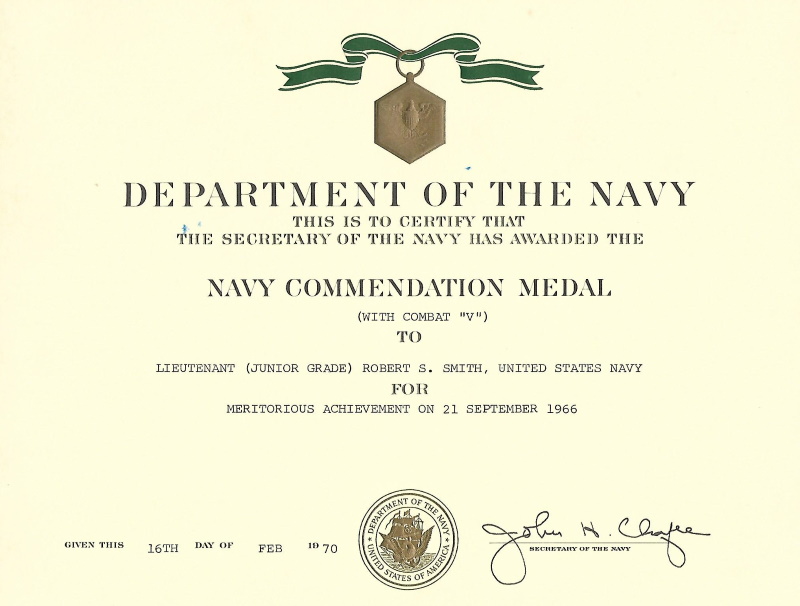 |
|
My first Navy
Commendation
Medal with
Combat "V" |
There were two kinds of individual medals that us JOs were awarded during the first cruise;
The Navy Achievement Medal (normally wingmen) and the Navy Commendation medal (normally section leaders)
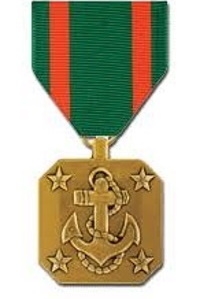 |
The Navy Achievement Medal (NAM) was intended to recognize the contributions of junior officers and enlisted personnel who were not eligible to receive higher awards. If it was awarded for a combat mission, it is worn with a "V". Additional NAMs are indicated by gold or silver stars to the ribbon. One gold star for each additional NAM. A silver star indicates five NAMs. |
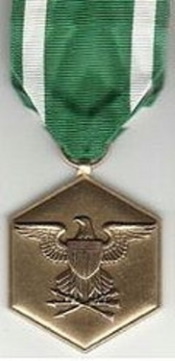 |
The Navy Commendation Medal (NCM) is a mid-level decoration which is presented for sustained acts of bravery or meritorious service. If it awarded for a combat mission, it is worn with a "V". Additional NCMs are indicated by adding gold or silver stars to the ribbon. Each gold star indicates one additional NCM. A silver star indicate five NCMs. A mid-level medal medal means that it is intended for combat missions primarily for section leaders and wingmen. While the division leaders (LCDRs) are usually put in for DFCs or individual air medals for particularly exciting missions, the best the wingman could expect was an NCM. |
| NAM with Combat "V"
ribbon |
NCM with Combat "V"
ribbon |
September 22nd- 1.0, 7 MK 82s and 1 Mk 81. This was another flex deck major strike. I was probably a section leader.
September 22nd- 1.7, 2 LAU 3 pods, 1 Mk 81 & 1 MK 82, and 4 flares. This was a night road reconnaissance mission!
My 9th Strike Flight Air Medal was recorded after this mission. I was awarded my 9th Strike Flight Air Medal for this mission.
I
must have been
the section
leader
(flares), I
logged 1.0
instrument
time, and 1.7
night time
with my 15th
night trap.
The
Night Road Reconnaissance Mission
We didn't do many
of these missions because our A4B
instruments were inadequate for night
bombing. Night
reconnaissance was conducted to
identify the primary target; trucks
on the move at night. The secondary
target was bridges outside of
populated areas when the flight
could not find any trucks. These
missions were flown by two aircraft
(usually A4C or A4E aircraft. One
aircraft would drop a flare over an
area and the second aircraft would
bomb any trucks he could see
illuminated by the flare. Most air
wings found that they almost never
saw any trucks and that they had to
bomb a secondary bridge target. This
was because the bomber aircraft
would be above the flare and had
little chance to see anything due to
the haze above the flare.
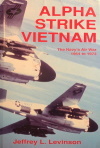 |
"As in any
profession, not all air
wings were equal in the task
of air combat-putting bombs
on target, and survival-and
the differences more often
that not could be traced to
leadership" Jeffrey L. Levinson, "Alpha Strike Vietnam, The Navy's Air War 1964 to 1973, page 58. |
But at least one squadron had great
success in in finding trucks during
night reconnaissance 1965 and 1966.
That was because their tactic was for
the bomber to be below the flare at
low altitude!
In Chapter Six of "Alpha Strike Vietnam" titled "Under the Flares" (pages 50-54), Cdr David Leue, Commanding Officer of the VA-153 "Blue Tails" onboard the USS Constellation during the summer of 1966 describes how their squadron was exceptionally effective at finding and destroying trucks by bombing at low altitude under the flare and using low level lay down ordnance such as rockets, MK 82 Snakeyes and guns.
In Chapter Six of "Alpha Strike Vietnam" titled "Under the Flares" (pages 50-54), Cdr David Leue, Commanding Officer of the VA-153 "Blue Tails" onboard the USS Constellation during the summer of 1966 describes how their squadron was exceptionally effective at finding and destroying trucks by bombing at low altitude under the flare and using low level lay down ordnance such as rockets, MK 82 Snakeyes and guns.
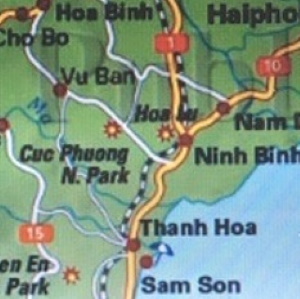 |
On page 53, Cdr Leue He describes his most significant mission where his section discovered two miles of trucks with their lights on probably on Route One between Thanh Hoa and Ninh Binh. Cdr Leue managed to get some trucks burning using guns. His wingman, Riley Harrell "jumped in there and got some good hits". Cdr Bud Ingley, CO of VA-155 and his wingman came over to "join the party" from the vicinity of Thanh Hoa where they had unintentionally stirred op a AAA hornet's nest by getting too close the "The Bridge". After the four aircraft were through, the area was IFR (instrument conditions) due to the smoke from the burning trucks. They called in the next cycle of aircraft to finish them off. Note: they didn't need flares to find the burning trucks! |
After returning to Lemoore, California (Lemoore was the home base of western Navy light attack aircraft), Cdr Leue briefed the pilots of one of the A4 squadrons training to deploy to Yankee Station about the success VA-153 had experienced with night road reconnaissance bombing below the flares. The Commanding Officer of that squadron "wanted no part in it". (page 54)
"As in any profession, not all air wings were equal in the task of air combat-putting bombs on target, and survival-and the differences more often that not could be traced to leadership"
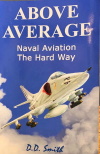 |
D.D.Smith
describes his experience with
night reconnaissance under
flares as a member of VA-72
onboard the USS Independence
in his book, "Above Average,
Naval Aviation the Hard Way".
His book is an excellent read
for anyone interested in
getting an excellent
perspective from an
experienced test pilot
adapting to the challenges of
combat operations in the high
threat environment in North
Vietnam. You can get a glimpse of his thoughts about attacking trucks at night with flares on pages 69 through 71 in Jeffrey Levinson's book, "Alpha Strike Vietnam"! |
My
last two
flights of the
Third Line
Period
September
23rd- 1.1, 4
LAU 3 pods,
Flex
deck. I
was probable a
Flak
suppressor
section lead
for a strike.
September 24th- 2.2. This was our fly off from Intrepid to NAS Cubi Point at the end of the line period
September 24th- 2.2. This was our fly off from Intrepid to NAS Cubi Point at the end of the line period
Our Third Port Visit:
Back to Cubi Point/Subic Bay/Olongopo (September 24th to September 30th)
 |
 |
 Back for More Cubi
Specials at the Cubi O'Club
|
 Back for More Fun in Olonmgapo |
| This is a great color shot
of the bridge from the Olongopo
gate over to the Marmont Hotel
and restaurant with the ever
present boats with divers under
the bridge. Note the sailors returning from liberty helping a shipmate to the gate in the daytime! |
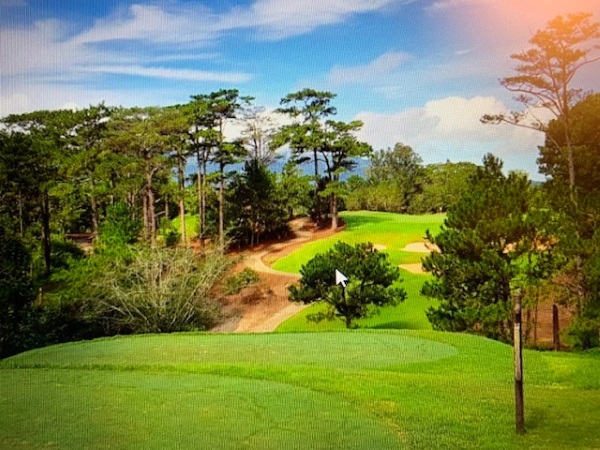 One thing we did more of
the second time around was
play golf on the beautiful
jungle course at Subic Bay. We
were required to each have a
local caddy who would go
locate our golf ball after our
drive (probably improving our
lie in the process) and
occasionally actually go into
the jungle rough to find a
ball (sometimes ours)
|
Our Last Line Period-
October 2nd - October 19th, 1966:
YANKEE STATION
We had the experience of one complete line period flying misssion over North Vietnam behind us. Despite our lack of fighter, Iron Hand, EW, or Photo RECON, we were very valuable working with other air wings/carriers on major strikes because we had two squadrons of A4s and the best RESCAP capability at Yankee Station with our two spad squadrons.
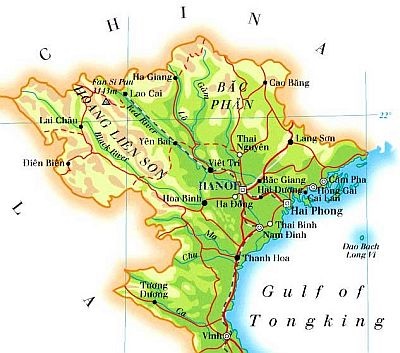 |
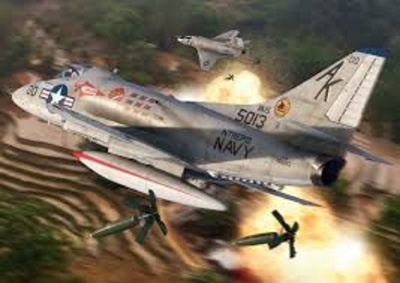 This line period would be
the most chalenging yet !
|
Intrepid's aircraft were not equipped to fly in the high AAA (Anti Aircraft Artillery) and SAM (Surface to Air Missile) Environment of North Vietnam!
VA-165 and VA-176's A1 Skyraiders (Spads) were exceptionally well equipped as bombers. But, they were too slow to fly in the dense AAA and SAM environment deployed around the high value targets of North Vietnam. As a result, they were limited to strikes along the coast in lower threat areas and as RESCAP (Rescue Combat Air Patrol) aircraft to protect pilots who were shot down on the coast or in the water off the coast during the resce process.
VA-15 and VA-95's A4B aircraft had the speed to be effective in a high threat environment. But, the only electronic warfare equipment equipment we had was a SAM launch warning alarm system. We did not have the electronic warfare receivers and processors or chaff systems possessed by the other Yankee Station aircraft.
There are two types of AAA gun systems; radar controlled and non radar controlled gun systems of various calibers.
There were large numbers of non radar controlled 37 and 57mm guns deployed throughout the Route packages from Vinh in northern Route Package 2 to the Chinese border. Route Package 1 and Route Package 2 south of Vinh were less densely defended. Electronic warfare systems are not effective against non radar controlled guns. Non radar controlled guns were manually aimed and had a difficult time hitting targets flying faster than 400 knots. Spads were easier targets for these guns. But the non radar controlled guns could be fired in barrages with fuses fixed to explode at a specific altitude. There were many of these guns at high value targets and expected routes to high value targets. The North Vietnamese used a tactic to help determine the altitude of incoming aircraft developed by the Germans World War Two. This tactic was to deploy large balloons (about the size of a Chevy van) with a cable to a known altitude (confirmed with a radar). Once they knew the altitude , they could set their 37mm/57mm shells to destruct setting at that altitude. In that way, their barrage fire could be more effective. As a flight leader, you could counter this tactic by ensuring that you increased the enroute altitude above the altitude of any balloons you observed.
The non radar controlled 37mm/57mm guns could be countered by flying enroute to the target above their effective altitudes (12,000 feet).
However, radar controlled 57mm, 85mm, and 100mm could deliver accurate fire at high speed targets. Also, the 85mm/100mm guns were effective at altitudes up to about 16,000 feet. Electronic countermeasures could be effective against these threats. Unfortunately, our A4Bs did not have these countermeasures.
If the flight flew enroute to the target area at 18,000', the only viable threats were SAMs and Migs.
When the flight entered the target area, every bomber aircraft was very vulnerable to AAA fire in the bomb run and during recovery. Keeping the minimum pullout altitude above 4,000 feet kept the aircraft safe from ground based rifle and machine gun fire but not from 37mm/57mm/85mm AAA fire. The majority of aircraft losses were in the target area during bomb runs due to AAA.
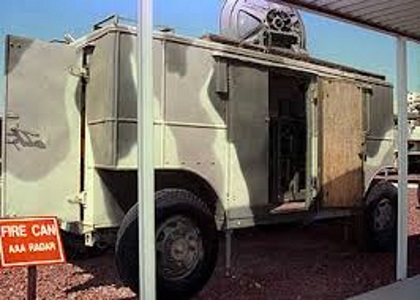 Howeve
a conical scan Firecan portable
AAA radar.
|
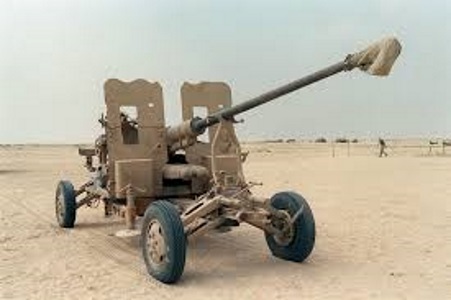 This
is a portable AAA gun (probably
about 85mm)
|
An effective tactic for North Vietnamese defense officers was to mix radar controlled 57mm/85mm aimed fire in with non radar controlled 37mm/57mm barrage fire in the target area.
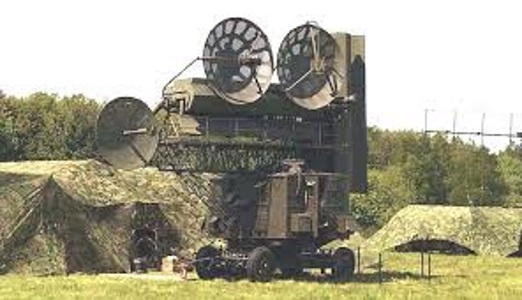 This
is a portable S Band raster scan
Fansong SA-2 radar
|
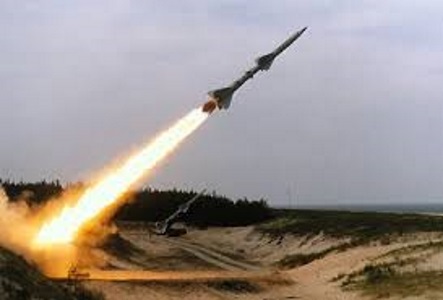 This
is a SA-2 Guideline Surface to
Air Missile (SAM)
|
The North Vietnamese deployed their SAM in both fixed sites with about six missiles and one Fansong van and in better concealed positions. The only EW equipment our A4Bs had was the APR-27 SAM warning system which told us when a SA2 was in the air and being guided.
Our only defense against the SAMs was to out maneuver the missile once we had it in sight. We could also maneuver close to the ground to defeat the missile. Our lack of countermeasures against both the conical scan AA radars (Firecans, Flapwheels etc) and the Fansong SA2 radars forced us to use enroute altitudes that permitted to outmaneuver the SAMs (10,000-12,000 feet). This made us more vulnerable to non radar controlled 37mm/57mm non radar controlled guns and the radar controlled aimed 57mm/85mm guns. It was not an ideal situation!!
 We still flew most of our
combat missions from Intrepid
from Vinh in Route package 2 and
in Route Packages 3 and 4
(from south of Thanh Hoa to
north of Nam Dinh) reasonably
close to the coast. We did
continue to participate in major
strikes against the Thanh Hoa
bridge and other important
targets in Route Pack 4.
|
We did not fly any
missions to Haiphong or Hanoi but
did particiapte in a major strike
to Phu Ly which is northwest of
Nam Dinh and south of Hanoi.
The
Increased role of CVIC (Carrier
Intelligence Center) in Yankee
Station Operations
The
role of CVIC changed drastically
when we began flying in North
Vietnam. Unlike on Dixie Station
where CVIC just provided a rendezvous
point with the FAC and the check in
radio frequency, every mission in the
north required a CVIC brief on a
threat analysis on the target area
and photo imagery of the
target area if a specific target
was planned. The mission division or
section leader received a CVIC brief
before conducting the flight brief in
the ready room.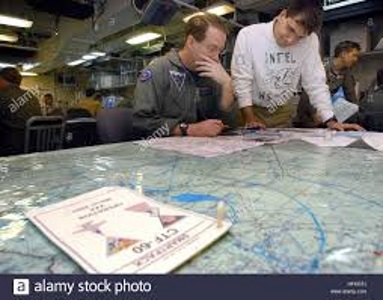 CVIC- MIssion
Planning
|
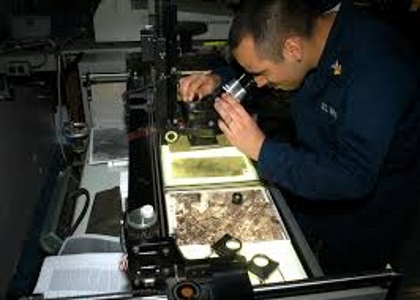 Target
Intelligence and Bomb Damage
Assessment
|
Alpha
Strikes
Alpha
Strikes were multi carrier strikes
against major targets in urban areas
where civilian collateral damage was
likely. These strikes were
specifically approved by President
Johnson and Robert McNamara, the
Secretary of Defense. These targets
were on a list called the Alpha list.
Alpha Strikes were conducted by two or all three of the carriers on Yankee Station and consisted of 80 to 100 aircraft including bombers, SAM opposition aircraft called Iron Hand aircraft, flack supressors who targeted AAA sites in the target area, BARCAP (Barrier Combat Air Patrol), and TARCAP (Target Combat Air Patrol) fighters, ECM aircraft, Airborne Early Warning aircraft (AEW), and RESCAP (Rescue Combat Air Control) aircraft.
There were other targets that were not on the Alpha list but were tasked tasked by Commander Seventh Fleet (CTF 77) and the Commander in Chief Pacific. These strikes also usually involved one carrier to execute. These targets were normally well defended by SAMs and AAA and sometimes included a signigficant MIG threat.
My flight log entries for the Fourth Line Period (October 2nd through October 19th)
October 2nd- 1.7, 2 MK 83s. The flight time indicates cyclic operations. But the MK 83 (1000 lb bombs indicate an important target).
October 3rd- 1.3, 3 LAU 3, Flex deck ops, flak suppressor mission
October 4th- 1.1, 7 MK 82s & 1 Mk 81, Flex deck, strike mission (my 100th combat mission)
I didn't fly October 5th, 6th, and 7th-
This is a photograph taken of the Vinh area on October 5th, 1966
Image courtesy of the
Lawson Collection, Emil Buehler
Library, National Naval Aviation
Museum, NAS Pensacola, Florida
VA-165/VA-176 Spad RESCAP Alpha Strike Support
Both VA-165 and VA-176 flew RESCAP support for the October 9th Alpha Strikes that day. Because of the fuel endurance of the Spad, they we not limited by the short Alpha Strike cycles of the flight deck. Their missions were double or tripple cycle missions. Their RESCAP orbit position was off shore of the strike group ingress and egress route and nearby the destroyer with had a SAR (Search and Rescue) helo that was positioned on deck to respond to a rescue mission.
VA-176 Spad MIG Killers
VA-176 launched a flight of four Spads for RESCAP about mid morning on October 9th. When arriving on station, they were directed to support a rescue attempt for an Coral Sea F4 Phantom that was shot down on the first Ph Ly strike.
The Thunderbolt (VA--176) flight lead was LCDR Leo Cook and his wingman, Ltjg Jim Wiley departed for the rescue scene leaving behind the Section Leader Lt Pete Russell and his wingman, Lt Jg Tom Patton to stay with the SAR helo.
Note: The standard procedure in a shoot down situation is that the strike leader or someone designated by him that had more fuel would take command of the scene and coordinate the rescue. In this case, all the strike aircraft had to depart due to fuel considerations giving a description of the location of the downed pilots to LCDR Cook.
LCDR approached the scene looking for signs of the downed pilots such as a chute when his wingman, Ltjg Wiley reported tracers coming not from the ground up but from the air down to the ground (A MIG firing on them) and called for LCDR Cook to break right into the attack. The MIGs overshot and Ltjg Wiley achieved a firing position on one of the MIGs firing all four of his guns. Ltjg Riley observed pieces coming from the MIG. At this point the MIGs "bugged out" to the north steaming fuel and smoke. Ltjg Riley lost sight of LCDR Cook during his encounter with the two MIGs. CDR Cook had sought refuge at very low level flying below ridge lines in the area. As a result, he lost radio contact for a time.
Meanwhile, when Lt. Russel and his wingman Ltg Patton arrived with the helo and he saw two additional MIGs about to attack Ltjg Wiley. Lt Russel and Ltjg Patton engaged these MIGs and in the process Ltjg Patton shot down one of the MIGs (observed an ejection with a good parachute). After a turn or two one of the MIGs made an attack on Lt Russel but overshot which enable Lt Russel to pull lead (get a good sunsight solution). Lt Patton fired all his guns and some rockets at point blank range. Although that MIG was not observed to hit the ground or the pilot eject, that engagement was not documented but most observers consider it was probably a kill.
Lt Russel and Ltjg Wiley (one confirmed kill and one probable) found the helo and escorted it across the coastline where they encountered considerable AAA mostly directed toward the helo. The helo was very low on fuel but managed to land on the destroyer with 50#s of fuel remaining (fumes).
LCDR Cook and Ltjg Wiley joined and Lt Patton and Ltjg Patton and they returned to Intrepid low on fuel but undamaged. There is a code word used by the PIRAZ ship (the Yankee Station Air Defense cruiser) for beware MIGs in the area. It is said that after this flight, the North Vietnamese began using the Code Word Thunderbolt for "beware Spads in the area".
Note: The reports I have do not include what type of MIGs were involved. But, in 1966 they were probably two sections of MIG 17s. The final result we one MIG 17 confirmed kill, one MIG 17 damaged, and one MIG 17 probable.
The Spad MIG Killers experienced quite a bit of AAA when crossing the coast coming and going on their famous MIG Killer mission. They were lucky that day.
October 9th- 0.9, 10 MK 82s. Flex deck strike. I was not on on the Alpha Strike.
I did not fly October 10th
October 11th- 0.8, 12 MK 81s, Flex deck major strike bomb load
October 12th- 1.9, 2 AGM 12 Bullpup missiles expended
October 12th- 1.7, combat tanker (1 point 1M flight), 1 wet plug
October 13th- 1.7, 2 MK 83s
October 14th- 1.8, 4 Mk 82s, This was my 109th mission. I hjad accumulated 200 points with ths mission
I ws awarded my 10th Strike Flight Air Medal with this mission

October 15th- 2.3, no weapons load logged, 0.5 actual ionstrument time, 0.1 night time, my 16th night trap (pinky)
I did not fly October 16th, 17th, 18th- Bad weather??
October 19th- 1.8, I flew off to Cubi Point.
Alpha Strikes were conducted by two or all three of the carriers on Yankee Station and consisted of 80 to 100 aircraft including bombers, SAM opposition aircraft called Iron Hand aircraft, flack supressors who targeted AAA sites in the target area, BARCAP (Barrier Combat Air Patrol), and TARCAP (Target Combat Air Patrol) fighters, ECM aircraft, Airborne Early Warning aircraft (AEW), and RESCAP (Rescue Combat Air Control) aircraft.
There were other targets that were not on the Alpha list but were tasked tasked by Commander Seventh Fleet (CTF 77) and the Commander in Chief Pacific. These strikes also usually involved one carrier to execute. These targets were normally well defended by SAMs and AAA and sometimes included a signigficant MIG threat.
My flight log entries for the Fourth Line Period (October 2nd through October 19th)
There
was no fly on. They must of
craned our aircraft back aboard in
Cubi before we left port.
October 2nd- 1.7, 2 MK 83s. The flight time indicates cyclic operations. But the MK 83 (1000 lb bombs indicate an important target).
October 3rd- 1.3, 3 LAU 3, Flex deck ops, flak suppressor mission
October 4th- 1.1, 7 MK 82s & 1 Mk 81, Flex deck, strike mission (my 100th combat mission)
I didn't fly October 5th, 6th, and 7th-
This is a photograph taken of the Vinh area on October 5th, 1966
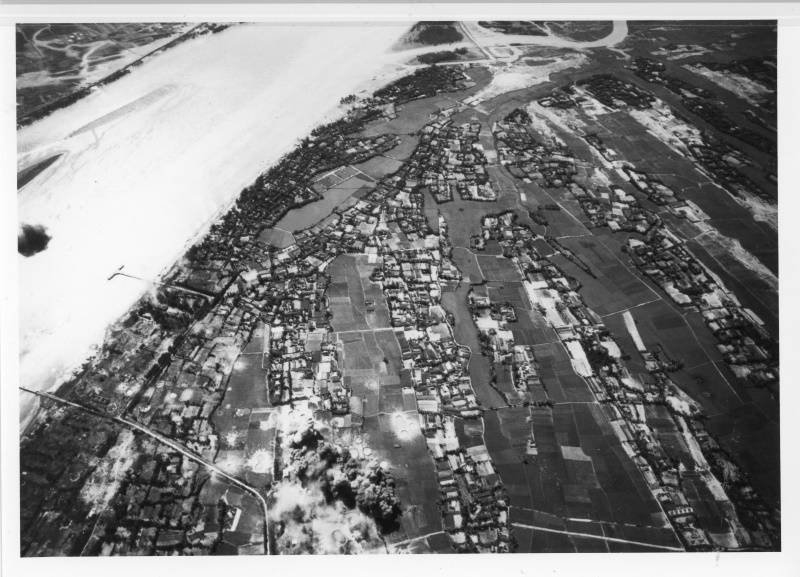 |
This
is a photograph taken of a strike on
a bridge in October, 1966
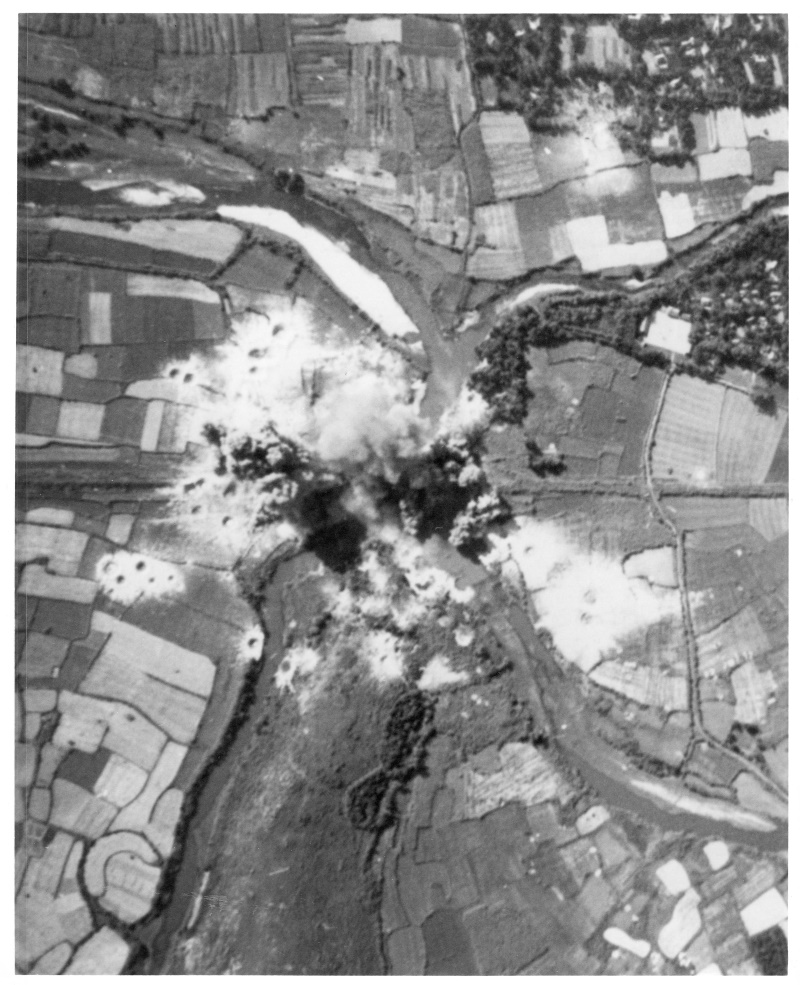 |
Image
courtesy of the Lawson
Collection, Emil Buehler
Library, National Naval
Aviation Museum, NAS
Pensacola, Florida
October 8th- 1.6, 6 MK 81s and 3 WP
(Willie Pete) rockets, road recce with
marking with Willie Petes October 9th,
1966
Our first Alpha Strike was tasked against the Phu Ly Railroad Yard
All Intrepid and Oriskany aircraft returned to the ship safely. I have no information about Coral Sea strike aircraft damage. One Coral Sea F4 Phantom was shot down (I do not know if by a MIG, SAM, or AAA). The crew was not recovered although a massive RESCAP effort was made throughout the day (I have discussed more about that below on the VA-176 Spads versus MIG 17s below).
Our first Alpha Strike was tasked against the Phu Ly Railroad Yard
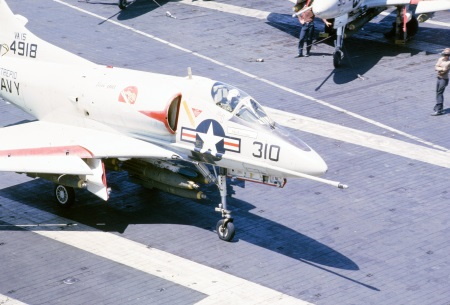 |
Our typical
Alpha Strike weapons load in
1966 was no centerline fuel
tank with a centerline MER
(Multiple Ejection Rack)
that held 6 MK 82s with 2 Mk
82s on a TER (Tripple
Ejection Rack) on each wing
station. (5000 lbs of bombs
for each aircraft) That was the mission load that was used on the Phy Ly mission. The only problem with this bomb load was that after dropping the bombs, the pilot was airspeed limited by the bomb racks. On the next cruise in 1967, we would carry a Mk 84 (2000# bomb) on the centerline and one Mk83 (1000# bomb) on each wing station for a total of 4000#s of bombs with no bomb racks! We were much faster and more maneuverable off the target |
USS
Intrepid and Carrier
Air Wing 10 were
tasked to participate
in the strike with
aircraft from the
Oriskany and Coral
Sea. The
Intrepid strike group
consisted of twenty
four A4B aircraft from
VA-15 and VA-195 led
by VA-15's Lcdr Jerry
Tuttle. VA-15's
second bomber division
was led by Lcdr Pete
Schoeffel. Our bombers
were tasked with
destroying the Phu Ly
railroad/highway
bridge. Our flack
suppressors who were tasked
to protect the
Intrepid
bombers from
AAA were led
by VA-15's
Lcdr Possum
Terrell.
Oriskany
and Coral Sea bombers
and their flack
suppressors were
targeted on
transshipment areas
and rail yards near
Phu Ly. Intrepid's
aircraft knocked down
several spans of the
bridge. Oriskany and
Coral Sea aircraft
destroyed their
targets.
Because Intrepid had no fighters, Iron Hand (anti-SAM), ECM aircraft, or AEW aircraft, our participation was limited to A4B bombers and flack suppressors.
The strike group encountered moderate AAA enroute to the target and SAM launches as they approached Phu Ly. AAA was intense in the target area.
The strike's proximity to Hanoi meant that MIGs from Kep and Phuc Yen north of Hanoi were a threat. F4 Phantom aircraft from the Coral Sea provided BARCAP/MIGCAP support. VF-111 F8C Crusaders from Oriskany provided TARCAP/StrikeCAP support. Two Oriskany Crusaders flown by Cdr Dick Bellinger and his wingman Lt Lee Prost provided TARCAP for the Intrepid aircraft. They intercepted 2 MIG21s. Cdr Bellinger shot down one of the MIGs (The first MIG21 downed by the Navy).
Because Intrepid had no fighters, Iron Hand (anti-SAM), ECM aircraft, or AEW aircraft, our participation was limited to A4B bombers and flack suppressors.
The strike group encountered moderate AAA enroute to the target and SAM launches as they approached Phu Ly. AAA was intense in the target area.
The strike's proximity to Hanoi meant that MIGs from Kep and Phuc Yen north of Hanoi were a threat. F4 Phantom aircraft from the Coral Sea provided BARCAP/MIGCAP support. VF-111 F8C Crusaders from Oriskany provided TARCAP/StrikeCAP support. Two Oriskany Crusaders flown by Cdr Dick Bellinger and his wingman Lt Lee Prost provided TARCAP for the Intrepid aircraft. They intercepted 2 MIG21s. Cdr Bellinger shot down one of the MIGs (The first MIG21 downed by the Navy).
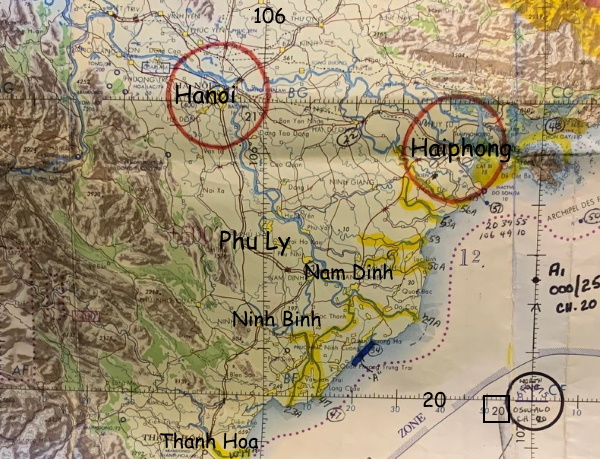 |
Phu Ly was located located northwest of Nam Dinh and south of Hanoi. Phu Ly was well within range of the MIG bases and was well defended by SAMs and AAA. Coral Sea F4 Phantom fighter aircraft provided BARCAP/MIGCAP support controlled by the PIRAZ ship or airborne E2 AEW aircraft. They took their stations separately from the strike group. The strike group aircraft from Intrepid, Coral Sea, and Oriskany coasted in near the mouth of the Red River and proceeded to the target via separate routes. Oriskany F8C Crusaders provided TARCAP/StrikeCAP for the strike group. |
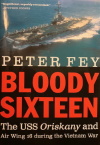 |
Most of my information on the strike composition, target assignments, BDA, and Cdr Bellinger's MIG 21 kill is from Peter Fey's "Bloody Sixteen", pages 158 and 159 |
All Intrepid and Oriskany aircraft returned to the ship safely. I have no information about Coral Sea strike aircraft damage. One Coral Sea F4 Phantom was shot down (I do not know if by a MIG, SAM, or AAA). The crew was not recovered although a massive RESCAP effort was made throughout the day (I have discussed more about that below on the VA-176 Spads versus MIG 17s below).
LCDR
Jerry Tuttle was the Intrepid Alpha
Strike Group leader. LCDR Pete
Schoeffel was a bomber division
leader.
Possum Terrell was the CAG 10 Flak Suppressor leader on the strike.
All three of these VALions received Distinguished Flying Crosses!
Possum Terrell was the CAG 10 Flak Suppressor leader on the strike.
All three of these VALions received Distinguished Flying Crosses!
Note: LCDR
Pete Schoeffel's wingman,
Bob Hamel, reported that
they encountered the
balloon tactic by the
North Vietnamese at Phu Ly
that day. The ballon
tactic consisted of
deploying a layer of
ballons at a specific
altitude. This was not so
much to cause the strike
aircrfat to have to dodge
the baloons, but rather to
be able to determine the
altitude of the strike
aircraft to the known
altitue of the baloons. In
this way, they could set
the fuses of the 37/57mm
barrage fire more
accurately.
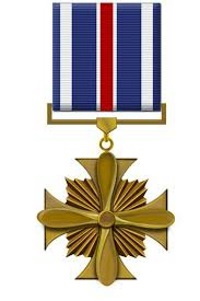 |
The DFC can be awarded for peacetime or combat related situations. If it awarded for a combat mission, it is worn with a "V". We had three DFCs awarded during the first cruise. Jerry Tuttle and Pete Schoeffel as bomber division leaders and Posssum Terrrell for leading the flak suppressors during the very successful strike on the Phu Ly Railroad yard on October 9th, 1966. However the second cruise provided lots of "opportunities to excel". As a result, all the "heavies" received at least one DFC for leading major strikes. |
 |
Most of the JOs received DFCs on the second cruise. There were opportunities that required the wingman to "take the lead" on a major strike or as a section leader, particularly with the Iron Hand mission. |
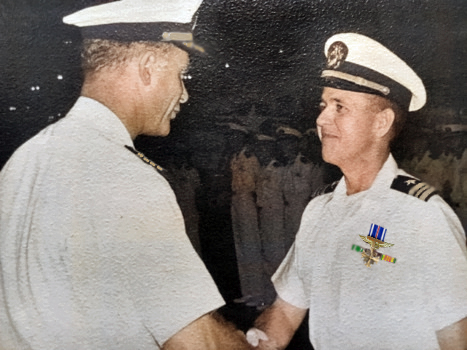 LCDR Jerry Tuttle receiving his DFC from Captain John Fair, CO USS Intrepid on October 19th, 1966 |
VA-165/VA-176 Spad RESCAP Alpha Strike Support
Both VA-165 and VA-176 flew RESCAP support for the October 9th Alpha Strikes that day. Because of the fuel endurance of the Spad, they we not limited by the short Alpha Strike cycles of the flight deck. Their missions were double or tripple cycle missions. Their RESCAP orbit position was off shore of the strike group ingress and egress route and nearby the destroyer with had a SAR (Search and Rescue) helo that was positioned on deck to respond to a rescue mission.
VA-176 Spad MIG Killers
VA-176 launched a flight of four Spads for RESCAP about mid morning on October 9th. When arriving on station, they were directed to support a rescue attempt for an Coral Sea F4 Phantom that was shot down on the first Ph Ly strike.
The Thunderbolt (VA--176) flight lead was LCDR Leo Cook and his wingman, Ltjg Jim Wiley departed for the rescue scene leaving behind the Section Leader Lt Pete Russell and his wingman, Lt Jg Tom Patton to stay with the SAR helo.
Note: The standard procedure in a shoot down situation is that the strike leader or someone designated by him that had more fuel would take command of the scene and coordinate the rescue. In this case, all the strike aircraft had to depart due to fuel considerations giving a description of the location of the downed pilots to LCDR Cook.
LCDR approached the scene looking for signs of the downed pilots such as a chute when his wingman, Ltjg Wiley reported tracers coming not from the ground up but from the air down to the ground (A MIG firing on them) and called for LCDR Cook to break right into the attack. The MIGs overshot and Ltjg Wiley achieved a firing position on one of the MIGs firing all four of his guns. Ltjg Riley observed pieces coming from the MIG. At this point the MIGs "bugged out" to the north steaming fuel and smoke. Ltjg Riley lost sight of LCDR Cook during his encounter with the two MIGs. CDR Cook had sought refuge at very low level flying below ridge lines in the area. As a result, he lost radio contact for a time.
Meanwhile, when Lt. Russel and his wingman Ltg Patton arrived with the helo and he saw two additional MIGs about to attack Ltjg Wiley. Lt Russel and Ltjg Patton engaged these MIGs and in the process Ltjg Patton shot down one of the MIGs (observed an ejection with a good parachute). After a turn or two one of the MIGs made an attack on Lt Russel but overshot which enable Lt Russel to pull lead (get a good sunsight solution). Lt Patton fired all his guns and some rockets at point blank range. Although that MIG was not observed to hit the ground or the pilot eject, that engagement was not documented but most observers consider it was probably a kill.
Lt Russel and Ltjg Wiley (one confirmed kill and one probable) found the helo and escorted it across the coastline where they encountered considerable AAA mostly directed toward the helo. The helo was very low on fuel but managed to land on the destroyer with 50#s of fuel remaining (fumes).
LCDR Cook and Ltjg Wiley joined and Lt Patton and Ltjg Patton and they returned to Intrepid low on fuel but undamaged. There is a code word used by the PIRAZ ship (the Yankee Station Air Defense cruiser) for beware MIGs in the area. It is said that after this flight, the North Vietnamese began using the Code Word Thunderbolt for "beware Spads in the area".
Note: The reports I have do not include what type of MIGs were involved. But, in 1966 they were probably two sections of MIG 17s. The final result we one MIG 17 confirmed kill, one MIG 17 damaged, and one MIG 17 probable.
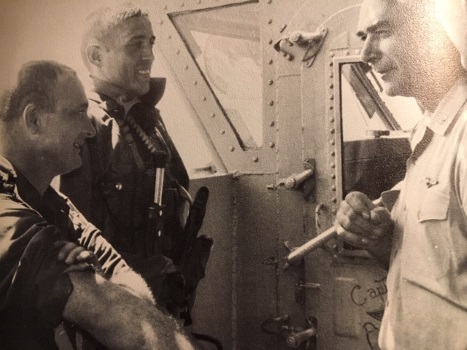 Captain John Fair, CO USS Intrepid, (Awarded the Navy Cross as an ACE with 5 kills in the Pacific in WW2) congratulates Ltjg Jim Wiley (one MIG damaged), LT Tom Patton (one MIG confirmed) (left to right) |
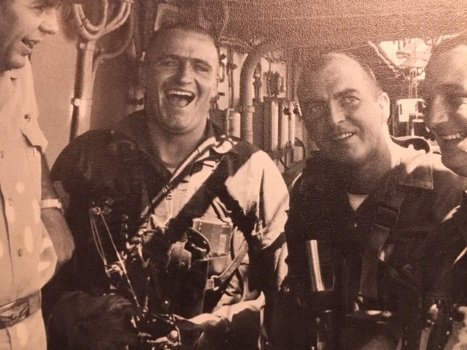 CDR Ray Ashworth , CO
VA-176 (left) congratulates
(left to right) LT Peter
Russell, (one MIG probable),
LCDR Cook (flight leader and
LT Tom Patton (one MIG
confirmed)
Note: Pete Russell was killed flying an OV-10 in a subsequent deployment as a member of VAL-4 in the Mekong Delta) |
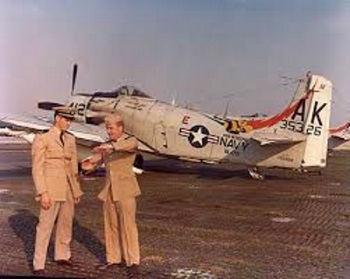 Lt Tom Patton
(left) decribing how he shot
down his MIG to Ltjg Pete
Russell
|
If you want to hear a 24 minute tape of each pilot describing the action in this incredible flight Google VA-176 Mig Killers |
The Spad MIG Killers experienced quite a bit of AAA when crossing the coast coming and going on their famous MIG Killer mission. They were lucky that day.
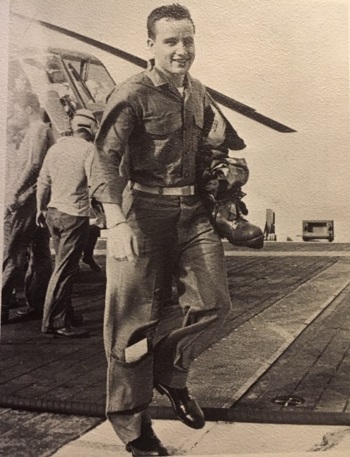 |
But, it was not uncommon for SPAD pilots top take hits when flying over North Vietnam. The plane's relatively slow speed made it easier for the 37/57mm AAA gunners to get hits. We lost one VA-165 Spad to ground fire in Route Package Three. Fortunately, the piloit, Ltjg Terry Dwyer was able to get out of the aircraft over Tonkin Gulf and was rescued uninjuired. |
October 9th- 0.9, 10 MK 82s. Flex deck strike. I was not on on the Alpha Strike.
I did not fly October 10th
October 11th- 0.8, 12 MK 81s, Flex deck major strike bomb load
October 12th- 1.9, 2 AGM 12 Bullpup missiles expended
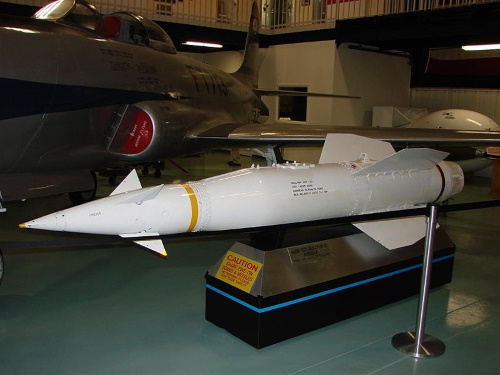 |
The AGM 12 Bullpup
missile came in two sizes; the
AGM 2A (little Bullpup) which
had a 250lb warhead and the
AGM 12B (big Bullpup) which
had a1000 lb warhead. The pilot launched the missile which was wire guided. The the pilot provided "line of sight" guidance using the trip button. Unfortunantely, the pilot had to stay in the run controlling the Bullpup to impact. The 250# Bullpup with it's small warhead was hardly worth the effort. The Big Bullpup's 1000# warhead was much better but the pilot was still in "harms way" during the run. However, it was a good Flak suppression weapon when used with a VT proximity fuse. |
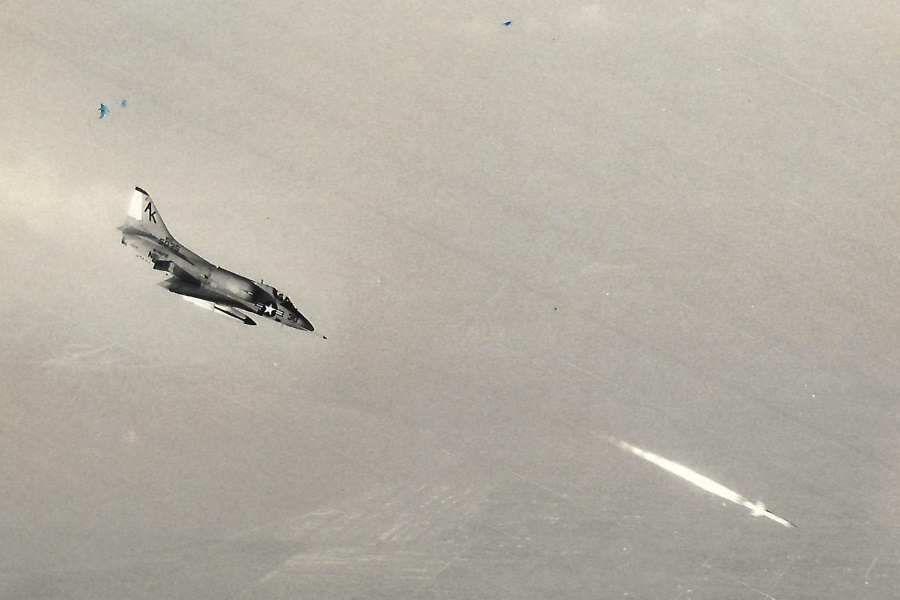 |
| VA-15 A4B firing a Bullpup missile |
October 12th- 1.7, combat tanker (1 point 1M flight), 1 wet plug
October 13th- 1.7, 2 MK 83s
October 14th- 1.8, 4 Mk 82s, This was my 109th mission. I hjad accumulated 200 points with ths mission
I ws awarded my 10th Strike Flight Air Medal with this mission
October 15th- 2.3, no weapons load logged, 0.5 actual ionstrument time, 0.1 night time, my 16th night trap (pinky)
I did not fly October 16th, 17th, 18th- Bad weather??
October 19th- 1.8, I flew off to Cubi Point.
Our first
Vietnam combat
deployment was over!
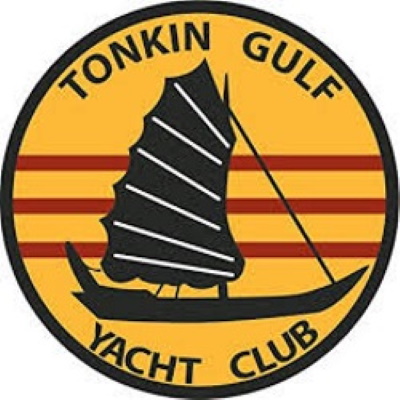 |
 |
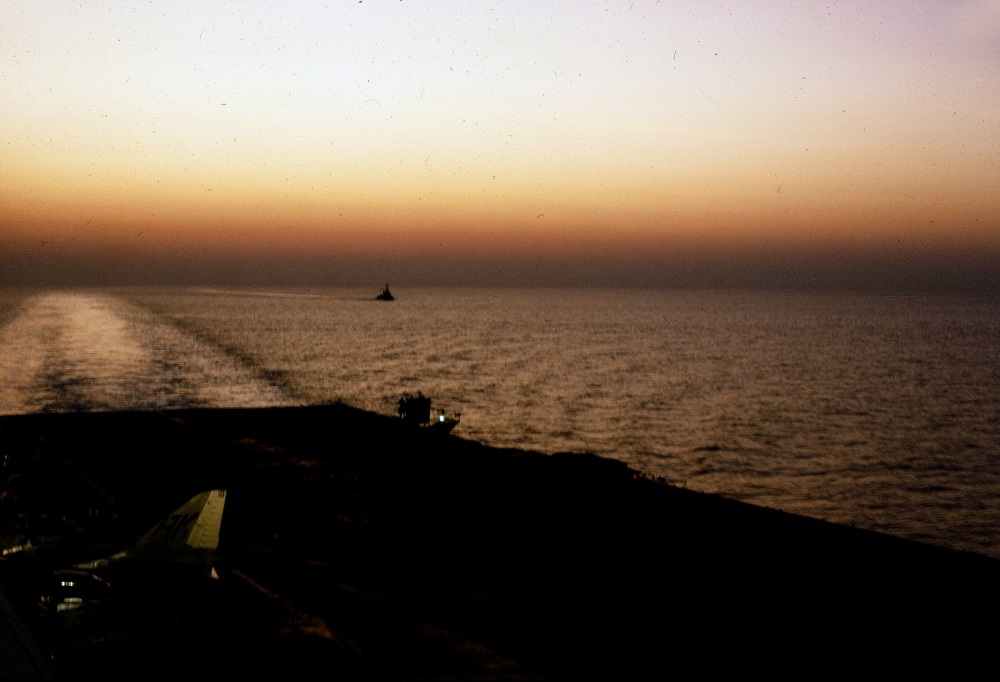 With our first Vietnam
deployment complete. it was time
for the Intrepid to head east
toward Subic Bay to get ready
for her transit back to the
states. Notice the plane guard
dstroyer still in position.
|
Air
Wing Ten flew off to Cubi Point- October
19th, 1966
The Intrepid stopped inport Cubi before returning to the states
The Intrepid stopped inport Cubi before returning to the states
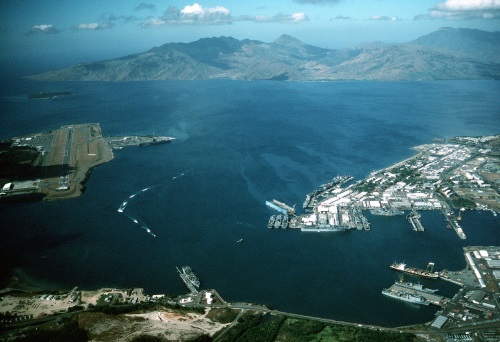 |
The Intrepid could have left Yankee Station and transited back to the states without coming into port at Subic Bay/Cubi Point. The ship could have refueled and taken on supplies at sea and then headed back. But that wasn't policy at the time. The air wing flew off from the Tonkin Gulf to Cubi Point and the ship followed coming inport a couple of days later. |
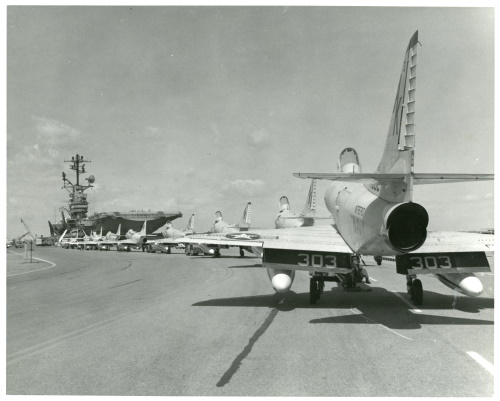 |
The aircraft were then craned aboard for the transit back to the states. The ship probably refueled and loaded needed supplies on board before departing for the trip back. |
Other
Vietnam Related Awards and Ribbons
 Meritorious
Unit
Commendation
|
VA-15
was awarded a Meritorious Unit
Commendation (MUC) for the 1966
Vietnam cruise. The MUC is equivalent to the Bronze Star Medal. |
Vietnam
Service Medal
|
The
Vietnam Service Medal is awarded
to units that served in the
Vietnam area of operations. The bronze star indicates service in one campaign. |

Vietnam Cross of Gallantry
|
The
Vietnam Cross of Gallantry was
awarded by the Republic of Vietnam
and was ntended to be awarded to
army units. It can be worn
with a palm, gold star, silver
star or bracket. My DD 214
says that I am authorized to wear
it with a silver star. Vietnam also awarded a Air Cross of Gallantry and a Navy Cross of Gallantry. For some reason, we were awarded a version intended for army units. Go figure! |

Republic of Vietnam Service
Ribbon
|
The Republic of Vietnam Service Ribbon was awarded to units operating in the Vietnam operating area during the period 1960-1973. The new version has an end date of 73. |
My
Ribbon Bar at the End of the 1966 Cruise
(Typical for the Junior Officers)
 |
| Top Row:
10 Strike Flight Air Medals, one NCM
(some JOs might have an NAM or NCM or both) Second Row: Meritorious Unit Citation (MUC), Defense Service Medal, Vietnam Campaign Medal, Third Row: Republic of Vietnam Gallantry Cross, Republic of Vietnam Service Ribbon, US Navy Expert Pistol Qualification Medal |
Magic Carpet Flight
Most
of the airwing pilots remained at Cubi
rather than return with the ship.
Pilots who flew a combat tour on Yaknee
Station were rewarded by being flown
home on commercial aircraft. These
were known as Magic Carpet
flights. So, rather than return
home with Intrepid, we flew home for a
couple of weeks of basket leave before
meeting the ship in Mayport for the
flyoff back to our home bases. (Basket
leave is leave that is not recorded
against your leave balance). An
exception to this was our Operations
Officer, LCDR Pete Schoeffel. Pete was
elected to ride the ship home as the
senior officer representing the
airwing. Pete used this time to
write the Cecil Field training plan for
the period from December 1966 through
mid March 1967 before type training
onboard Intrepid prior to the next
Vietnam deployment.
USS Oriskany (CV 34) experienced a serious fire while on Yankee Station on October 26th, the same day that Intrepid crossed the Equator in the eastern Indian Ocean:
The USS Oriskany (CV-34) was on Yankee Station the morning of October 26th, when afire erupted on the starboard side of the forward hangar bay. The fire was caused by a magnesium parachute flare which exploded (due to human error) in the forward flare locker of Hangar Bay One. A panicked sailor through the burning flare into the weapon's locker where the flares were stored rather than over the side of the ship into the water. (Magnesium flares burn at an extremely high temperature and cannot be extinguished by conventional means but will go out if immersed in sea water) The burning flare ignited the other flares in the weapons locker creating a fire which raced through five decks including many living compartments. Forty four men were killed including many pilots who had flown over North Vietnam earlier that morning. The Oriskany steamed into Subic Bay on October 28th and left Subic a week later to return to San Diego for repairs.
The Intrepid with her aircraft onboard could have been turned around and resumed Rolling Thunder air operations over North Vietnam in place of Oriskany. Except that the Intrepid's pilots had returned to the states on the Magic Carpet flights and were dispersed throughout America on post deployment leave.
This event resulted in a change in Magic Carpet flight policy. All future post deployment Magic Carpet flights would not take place until their carrier was no longer capable of being turned around. That meant that airwing pilots hung around Cubi relaxing and playing golf or going on leave to Hong Kong for a couple of weeks before taking a Magic Carpet Flight back to the states.
USS Intrepid Crossing the Equator Ceremony on October 26th in the eastern Indian Ocean enroute Mayport:
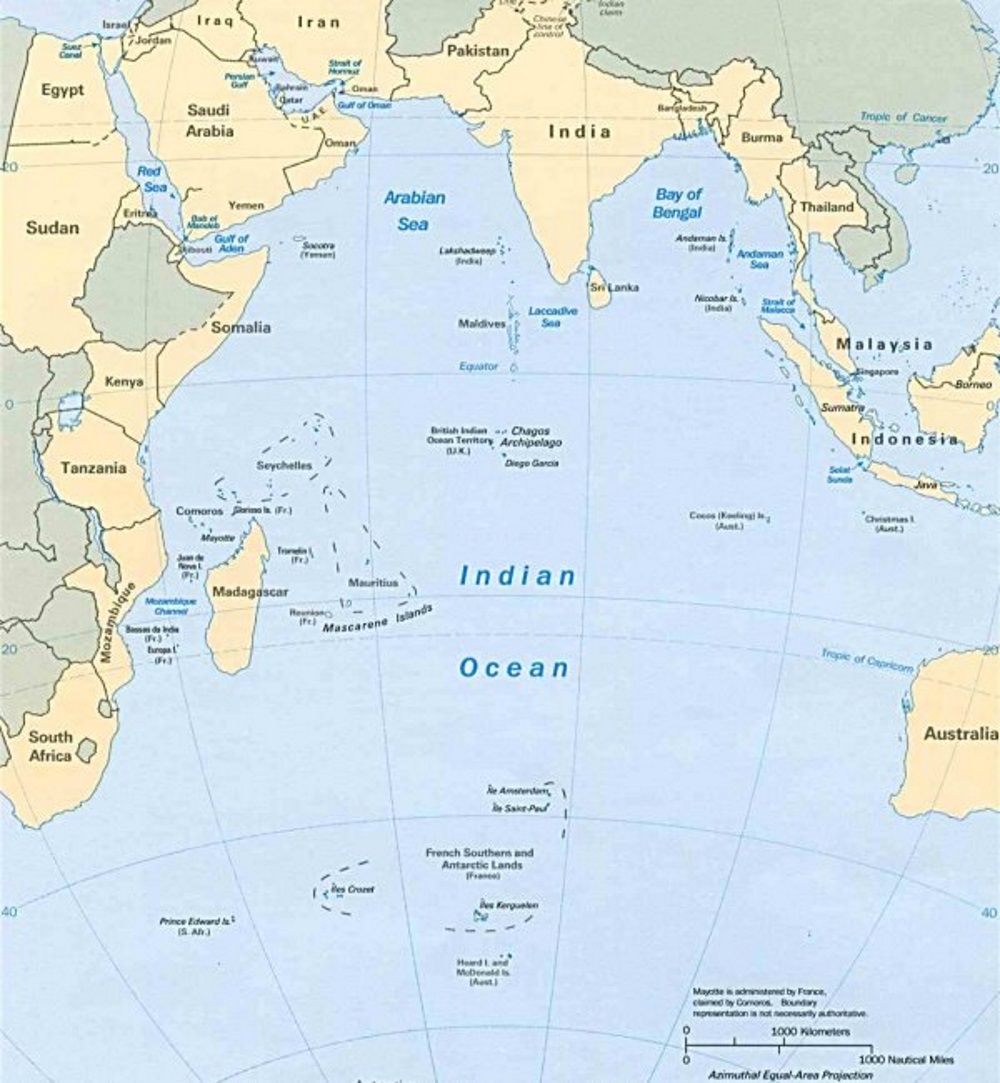 Intrepid must have hauled
butt to get through the Straits
of Malacca and transit close to
the west of Sumatra to get to
the Equator on October
26th. I assume that they
transited around Capetown, South
Africa and then to Mayport.
|
For centuries, Sailors have celebrated significant accomplishments at sea by holding ceremonies commemorating these events. Crossing the Equator is one of the most important of these ceremonies. When a ship crosses the line (Equator or Arctic Circle), The God of the Sea, King Neptune, along with Davy Jones visit the ship and along with their accomplices called shellbacks (shipmates who have crossed the line previously) "initiate" the polywogs (those who haven't crossed the line before) in an appropriate manner such as kissing the greased belly of a member of King Neptune's court. It's the trip to get to that point which can be exciting for the poor polywog. Note: Admirals who have not crossed the Equator are polywogs!
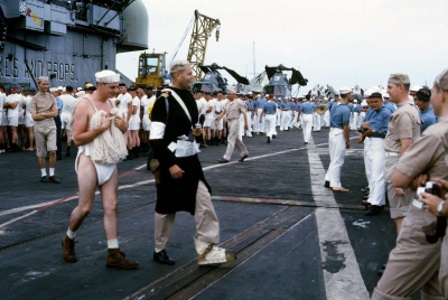 The polywogs must be
organized by the shellbacks
|
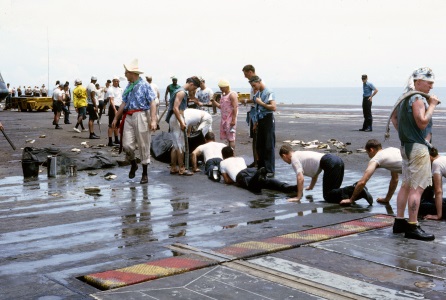 polywogs must be
cleansed
|
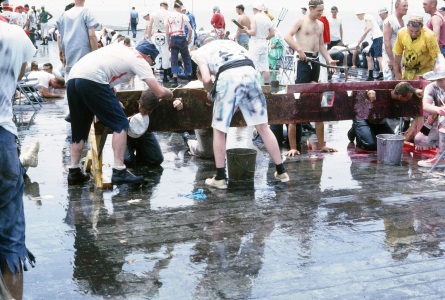 polywogs must be properly
instructed
|
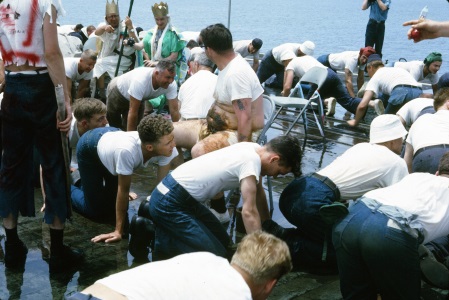 Finally, polywogs get the
pleasure if kissing the "royal
baby" before King Neptune's
court
|
A
colorful certificate is generally
awarded to polywogs who have
successfully completed their initiation
and become shellbacks.
Offload of Cag 10 Aircraft at Mayport and
Fly In at NAS Cecil Field
We flew our aircraft from from
Mayport to Cecil on November 21st, 1966
officially ending our first deployment.
Website Created by Robert S. "Bo" Smith
Photos are from the USS Intrepid 1966 cruise book, Google, and VALions Miller and Connie Detrick